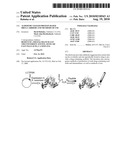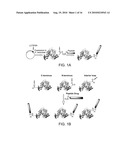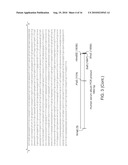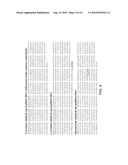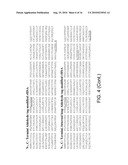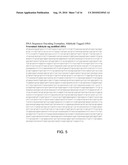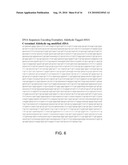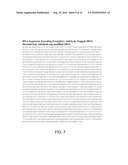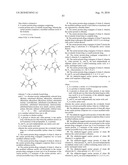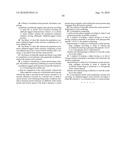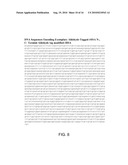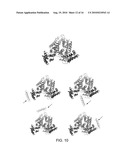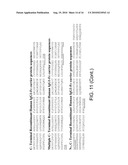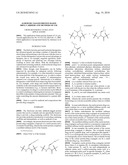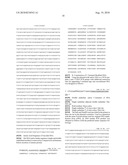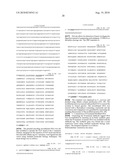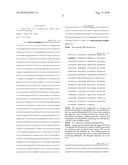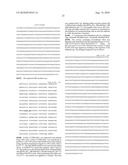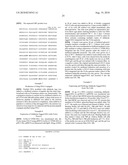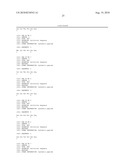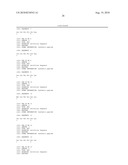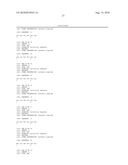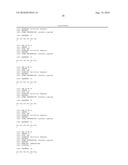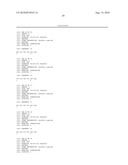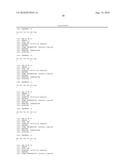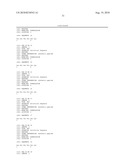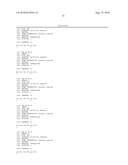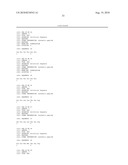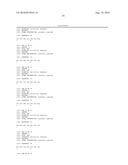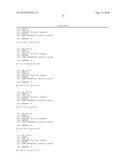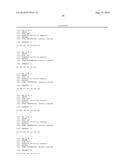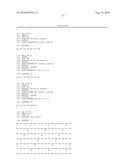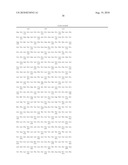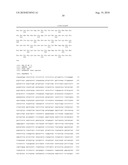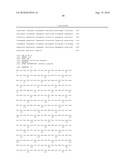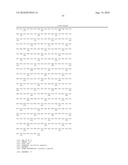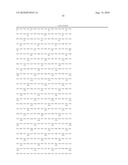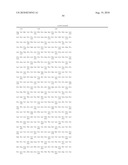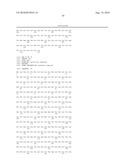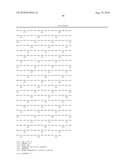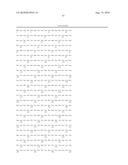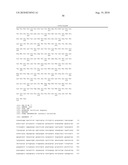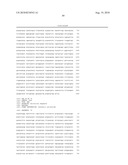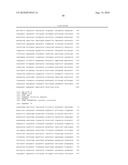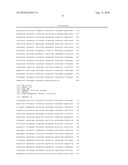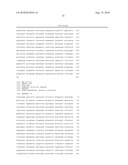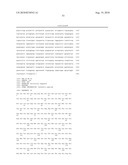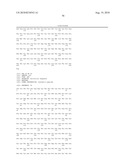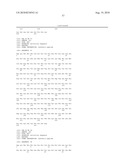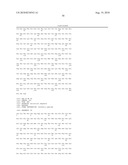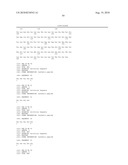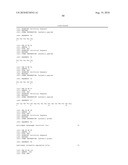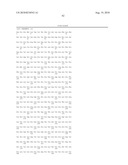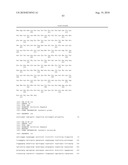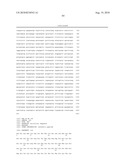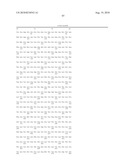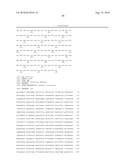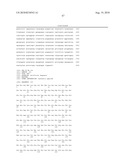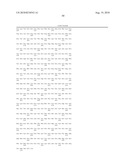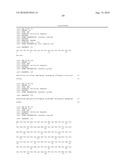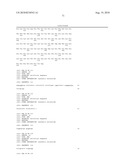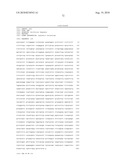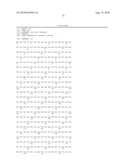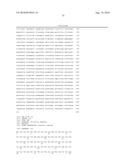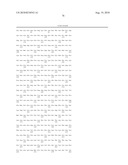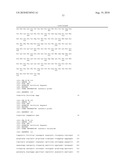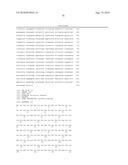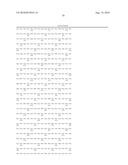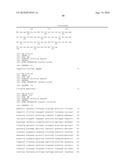Patent application title: Aldehyde-Tagged Protein-Based Drug Carriers and Methods of Use
Inventors:
David Rabuka (Oakland, CA, US)
Mark Alan Breidenbach (Oakland, CA, US)
IPC8 Class: AA61K3823FI
USPC Class:
514 12
Class name: Designated organic active ingredient containing (doai) peptide containing (e.g., protein, peptones, fibrinogen, etc.) doai 25 or more peptide repeating units in known peptide chain structure
Publication date: 2010-08-19
Patent application number: 20100210543
Claims:
1. A carrier protein-drug conjugate comprising:a carrier protein and a
covalently bound drug, wherein the carrier protein comprises a modified
sulfatase motif of the formula:X1(FGly')X2Z2X3Z3
where FGly' is of the formula: ##STR00003## wherein J1 is the
covalently bound drug;each L1 is a divalent moiety independently
selected from alkylene, substituted alkylene, alkenylene, substituted
alkenylene, alkynylene, alkynylene, arylene, substituted arylene,
cycloalkylene, substituted cycloalkylene, heteroarylene, substituted
heteroarylene, heterocyclene, substituted heterocyclene, acyl, amido,
acyloxy, urethanylene, thioester, sulfonyl, sulfonamide, sulfonyl ester,
--O--, --S--, --NH--, and substituted amine;n is a number selected from
zero to 40;Z2 is a proline or alanine residue;X1 is present or
absent and, when present, is any amino acid, with the proviso that when
the sulfatase motif is at an N-terminus of the polypeptide, X1 is
present;X2 and X3 are each independently any amino acid;
andZ3 is a basic amino acid; andwherein the carrier protein presents
the covalently bound drug on a solvent-accessible surface when in a
folded state.
2. The carrier protein-drug conjugate of claim 1, where in the carrier protein-drug conjugate comprises two or more modified sulfatase motifs.
3. The carrier protein-drug conjugate of claim 2, where in the carrier protein-drug conjugate comprises three or more modified sulfatase motifs.
4. The carrier protein-drug conjugate of claim 1, where in the modified sulfatase motifs are positioned in the carrier protein-drug conjugate at least one of an N-terminus of the carrier protein, a C-terminus of the carrier protein, and a solvent-accessible loop of the carrier protein.
5. The carrier protein-drug conjugate of claim 2, wherein the modified sulfatase motifs of provided as concatamer and are separated by a flexible linker.
6. The carrier protein-drug conjugate of claim 1, wherein the carrier protein is albumin.
7. The carrier protein-drug conjugate of claim 1, wherein the covalently bound drug is a peptide drug.
8. The carrier protein-drug conjugate of claim 7, herein the peptide drug is glucagon-like peptide 1 (GLP-1) or a biologically active variant thereof.
9. The carrier protein-drug conjugate of claim 7, herein the peptide drug is calcitonin or a biologically active variant thereof.
10. The carrier protein-drug conjugate of claim 1, wherein the covalently bound drug is a small molecule drug.
11. The carrier protein-drug conjugate composition of claim 1, wherein Z3 is arginine (R).
12. The carrier protein-drug conjugate of claim 1, wherein X1, when present, X2, and X3 are each independently an aliphatic amino acid, a sulfur-containing amino acid, or a polar, uncharged amino acid.
13. The carrier protein-drug conjugate of claim 1, wherein the X1, when present, is L, M, V, S or T.
14. The carrier protein-drug conjugate of claim 1, wherein X2 and X3 are each independently S, T, A, V, G, or C.
15. An aldehyde-tagged carrier protein comprising an amino acid sequence comprising:X1Z1X2Z2X3Z3 (I)whereZ1 is a cysteine, a serine, or a 2-formylglycine residue;Z2 is a proline or alanine residue;X1 is present or absent and, when present, is any amino acid, with the proviso that when the heterologous sulfatase motif is at an N-terminus of the aldehyde tagged polypeptide, X1 is present; andX2 and X3 are each independently any amino acid; andZ3 is a basic amino acid;wherein the carrier protein presents the covalently bound drug on a solvent-accessible surface when in a folded state.
16. The aldehyde-tagged carrier protein of claim 15, where in the carrier protein comprises two or more modified sulfatase motifs.
17. The aldehyde-tagged carrier protein of claim 16, where in the carrier protein-drug conjugate comprises three or more modified sulfatase motifs.
18. The aldehyde-tagged carrier protein of claim 15, where in the modified sulfatase motifs are positioned in the carrier protein-drug conjugate at least one of an N-terminus of the carrier protein, a C-terminus of the carrier protein, and a solvent-accessible loop of the carrier protein.
19. The aldehyde-tagged carrier protein of claim 15, wherein the carrier protein is albumin.
20. The aldehyde-tagged carrier protein of claim 15, wherein Z3 is arginine (R).
21. The aldehyde-tagged carrier protein of claim 15, wherein X1, when present, X2, and X3 are each independently an aliphatic amino acid, a sulfur-containing amino acid, or a polar, uncharged amino acid.
22. The aldehyde-tagged carrier protein of claim 15, wherein the X1, when present, is L, M, V, S or T.
23. The aldehyde-tagged carrier protein of claim 15, wherein X2 and X3 are each independently S, T, A, V, G, or C.
24. A library of modified carrier proteins, the library comprising:a population of aldehyde-tagged carrier proteins according to claim 15, or nucleic acid constructs encoding the aldehyde-tagged carrier proteins, where Z1 is a cysteine or serine residue, wherein the population comprises members having differently aldehyde-tagged carrier proteins.
25. The library of claim 24, wherein the population comprises aldehyde-tagged carrier proteins comprising two or more aldehyde tags.
26. The library of claim 24, wherein the population comprises aldehyde-tagged carrier proteins comprising at least one aldehyde tag at one or more of the N-terminus, the C-terminus, or an interior loop and the carrier protein.
27. The library of claim 24, wherein the library is provided in a population of recombinant cells genetically modified to express the nucleic acid constructs.
28. A method of producing a carrier protein-drug conjugate, the method comprising combining in a reaction mixturean aldehyde-tagged carrier protein of claim 15, wherein Z1 is a 2-formyl-glycine residue anda drug for conjugation to the carrier protein, wherein the drug comprises a aminooxy or hydrazide reactive group,wherein the drug is provided in the reaction mixture in an amount sufficient to provide for a desired ratio of drug to carrier protein, said combining being under conditions suitable to promote reaction between an aldehyde of the carrier protein and reactive group of the drug to generate a carrier protein-drug conjugate; and isolating the carrier protein-drug conjugate from the reaction mixture.
29. The method of claim 28, wherein the carrier protein is folded prior to said combining.
30. A formulation comprising:a carrier protein-drug conjugate according to claim 1; anda pharmaceutically acceptable excipient.
31. A method of treating a subject having or at risk of having condition amenable to treatment with glucagon-like peptide 1 (GLP-1), the method comprising:administering to a subject in of treatment a carrier protein-drug conjugate according to claim 1, wherein the covalently bound drug is glucagon-like peptide 1 (GLP-1) or a biologically active variant thereof;wherein said administering is effective to treat the condition in the subject.
32. A method of treating a subject having or at risk of having condition amenable to treatment with calcitonin, the method comprising:administering to a subject in of treatment a carrier protein-drug conjugate according to claim 1, wherein the covalently bound drug is calcitonin or a biologically active variant thereof;wherein said administering is effective to treat the condition in the subject.
33. A recombinant nucleic acid comprising a nucleic acid encoding an aldehyde-tagged carrier protein according to claim 10, wherein Z1 is a cysteine residue or a serine residue.
Description:
CROSS-REFERENCE TO RELATED APPLICATIONS
[0001]This application claims priority benefit of U.S. provisional application Ser. No. 61/153,162, filed Feb. 17, 2009, which application is incorporated herein by reference in its entirety.
INTRODUCTION
[0002]The field of protein and small molecule therapeutics has advanced greatly, providing a number of clinically beneficial drugs and promising to provide more with the years to come. Protein therapeutics can provide several advantages in therapies, due to, for example, exquisite specificity, multiplicity of functions and relatively low off-target activity, resulting in fewer side effects. With the development of sophisticated screening methods, small molecule drugs have also advanced in specificity of action.
[0003]Often, though, such therapeutics can be further improved by providing for enhanced activity following administration. For example, it is often desirable to increase the serum half-life of the therapeutic (e.g., in order to reduce the overall dose and/or the number of administrations required over a dosage period). Alternatively or in addition, therapeutics could benefit from improving their bioavailability. For example, some drugs may benefit from improving solubility in the relevant physiological environment and/or to facilitation formulation (e.g., to increase shelf-life). Moreover, conjugation of a drug to a carrier protein can be difficult to control, resulting in a heterogeneous mixture of conjugates that differ in the number of drug molecules attached. This can make controlling the amount administered to a patient difficult.
[0004]There is a need for methods and compositions that provide drug conjugates.
SUMMARY
[0005]The disclosure provides aldehyde-tagged protein carriers that can be covalently and site-specifically bound to drug to provide a drug-containing scaffold. The disclosure also provides methods of production of such drug-containing scaffolds and intermediates, as well as methods of use.
[0006]Accordingly, the present disclosure provides carrier protein-drug conjugates composed of a carrier protein and a covalently bound drug, wherein the carrier protein comprises a modified sulfatase motif of the formula:
X1(FGly')X2Z2X3Z3
[0007]where FGly' is of the formula:
##STR00001##
[0008]wherein J1 is the covalently bound drug;
[0009]each L1 is a divalent moiety independently selected from alkylene, substituted alkylene, alkenylene, substituted alkenylene, alkynylene, alkynylene, arylene, substituted arylene, cycloalkylene, substituted cycloalkylene, heteroarylene, substituted heteroarylene, heterocyclene, substituted heterocyclene, acyl, amido, acyloxy, urethanylene, thioester, sulfonyl, sulfonamide, sulfonyl ester, --O--, --S--, --NH--, and substituted amine;
[0010]n is a number selected from zero to 40;
[0011]Z2 is a proline or alanine residue;
[0012]X1 is present or absent and, when present, is any amino acid, with the proviso that when the sulfatase motif is at an N-terminus of the polypeptide, X1 is present;
[0013]X2 and X3 are each independently any amino acid; and
[0014]Z3 is a basic amino acid, and
[0015]wherein the carrier protein presents the covalently bound drug on a solvent-accessible surface when in a folded state.
[0016]In some embodiments, the carrier protein-drug conjugate contains two or more modified sulfatase motifs, and can contain three or more modified sulfatase motifs.
[0017]In further embodiments the modified sulfatase motifs of the carrier protein-drug conjugate are positioned in the carrier protein-drug conjugate at least one of an N-terminus of the carrier protein, a C-terminus of the carrier protein, and a solvent-accessible loop of the carrier protein.
[0018]The modified sulfatase motifs of the carrier protein-drug conjugate can be provided as a concatamer composed of modified sulfatase motifs separated by a flexible linker
[0019]In one exemplar, the carrier protein of the carrier protein-drug conjugate is albumin. The covalently bound drug can be a peptide drug, such as glucagon-like peptide 1 (GLP-1) or a biologically active variant thereof, or calcitonin or a biologically active variant thereof. The covalently bound drug of the carrier protein-drug conjugate can be a small molecule drug (e.g., doxorubicin).
[0020]Exemplary carrier protein-drug conjugates include those where Z3 is arginine (R). In exemplary embodiments, X1, when present, X2, and X3 are each independently an aliphatic amino acid, a sulfur-containing amino acid, or a polar, uncharged amino acid. In specific examples, X1, when present, is L, M, V, S or T. In specific examples, X2 and X3 are each independently S, T, A, V, G, or C.
[0021]The disclosure also provides aldehyde-tagged carrier proteins having an amino acid sequence of:
X1Z1X2Z2X3Z3
where
[0022]Z1 is a cysteine, a serine, or a 2-formylglycine residue;
[0023]Z2 is a proline or alanine residue;
[0024]X1 is present or absent and, when present, is any amino acid, with the proviso that when the heterologous sulfatase motif is at an N-terminus of the aldehyde tagged polypeptide, X1 is present; and
[0025]X2 and X3 are each independently any amino acid; and
[0026]Z3 is a basic amino acid;
wherein the carrier protein presents the covalently bound drug on a solvent-accessible surface when in a folded state.
[0027]In some examples the aldehyde-tagged carrier protein contains two or more modified sulfatase motifs, and can contain three or more modified sulfatase motifs. In some examples, the modified sulfatase motifs are positioned in the aldehyde-tagged carrier protein at least one of an N-terminus of the carrier protein, a C-terminus of the carrier protein, and a solvent-accessible loop of the carrier protein. In one example, the carrier protein is albumin
[0028]Exemplary aldehyde-tagged carrier proteins include those in which Z3 is arginine (R). Exemplary aldehyde-tagged carrier proteins include those in which X1, when present, X2, and X3 are each independently an aliphatic amino acid, a sulfur-containing amino acid, or a polar, uncharged amino acid. In specific examples of aldehyde-tagged carrier protein, X1, when present, is L, M, V, S or T. In specific examples of aldehyde-tagged carrier protein, X2 and X3 are each independently S, T, A, V, G, or C.
[0029]The disclosure also provides libraries of modified carrier proteins containing a population of aldehyde-tagged carrier proteins according to the present disclosure, or nucleic acid constructs encoding the aldehyde-tagged carrier proteins, where Z1 is a cysteine or serine residue, wherein the population comprises members having differently aldehyde-tagged carrier proteins. In some examples, the population of the library includes aldehyde-tagged carrier proteins having two or more aldehyde tags. In some examples, the wherein the population of the library includes aldehyde-tagged carrier proteins having at least one aldehyde tag at one or more of the N-terminus, the C-terminus, or an interior loop and the carrier protein. In some embodiments, the library is provided as a population of recombinant cells genetically modified to express the nucleic acid constructs.
[0030]The disclosure also provides methods of producing a carrier protein-drug conjugate by combining in a reaction mixture an aldehyde-tagged carrier protein having a 2-formyl-glycine residue (FGly' at Z1) and a drug for conjugation to the carrier protein, wherein the drug has an aminooxy or hydrazide reactive group. The drug is provided in the reaction mixture in an amount sufficient to provide for a desired ratio of drug to carrier protein, said combining being under conditions suitable to promote reaction between an aldehyde of the carrier protein and reactive group of the drug to generate a carrier protein-drug conjugate. The carrier protein-drug conjugate is then isolated from the reaction mixture. In specific embodiments, the aldehyde-tagged carrier protein is folded prior to said combining
[0031]The disclosure also provides formulations containing a carrier protein-drug conjugate of the present disclosure and a pharmaceutically acceptable excipient.
[0032]The disclosure also provides methods of treating a subject having or at risk of having condition amenable to treatment with glucagon-like peptide 1 (GLP-1) by administering to a subject in of treatment a carrier protein-drug conjugate of the present disclosure in which the covalently bound drug is glucagon-like peptide 1 (GLP-1) or a biologically active variant thereof, where administration is effective to treat the condition in the subject. The disclosure also provides methods of treating a subject having or at risk of having condition amenable to treatment with calcitonin by administering to a subject in of treatment a carrier protein-drug conjugate of the present disclosure in which the covalently bound drug is calcitonin or a biologically active variant thereof, where administration is effective to treat the condition in the subject.
[0033]The disclosure also provides recombinant nucleic acids having nucleic acid encoding an aldehyde-tagged carrier protein of the present disclosure in which Z1 is a cysteine residue or a serine residue.
[0034]Other features are provided below, and will be readily apparent to the ordinarily skilled artisan upon reading the present disclosure.
BRIEF DESCRIPTION OF THE DRAWINGS
[0035]It is emphasized that, according to common practice, the various features of the drawings may not be to-scale. On the contrary, the dimensions of the various features are arbitrarily expanded or reduced for clarity. Included in the drawings are the following figures:
[0036]FIG. 1A is a schematic illustrating production of an ald-tagged carrier protein containing a 2-formylglycine (FGly), which is reacted with an aminooxy-containing peptide to form a drug-conjugate of the present disclosure. The aldehyde tag is exemplified in FIG. 1A by LCTPSR (SEQ ID NO:1).
[0037]FIG. 1B is a schematic illustrating a library of ald-tagged carrier proteins, exemplified by an ald-tagged human serum albumin (HSA) (top panel), and ald-tagged HSA-drug conjugates (bottom panel) conjugated to a drug. By changing the location of the aldehyde tag, the spatial display of the peptide relative to the surface of the rHSA can be altered.
[0038]FIG. 2 is schematic illustrating an exemplary synthesis of peptides to contain a reactive partner for reaction with an aldehyde group of an ald-tagged carrier protein.
[0039]FIG. 3 is a schematic providing an amino acid sequence (SEQ ID NO:70) and nucleic acid sequence (SEQ ID NO:71) of human serum albumin (HSA).
[0040]FIG. 4 is a schematic providing amino acid sequences of exemplary ald-tagged HSA proteins (SEQ ID NO:72-76). The prepro leader sequence is indicated by a single underline. The sulfatase motif is indicated by a double underline.
[0041]FIGS. 5-9 are schematics providing the nucleic acid sequences (SEQ ID NO:77-81) of the exemplary ald-tagged HSA proteins of FIG. 4.
[0042]FIG. 10 is a schematic illustrating (top panel) the crystal structure of a recombinant HSA and (bottom panel) a carrier protein-drug conjugate of an ald-tagged recombinant HSA and GLP-1, with the GLP-1 peptide shown in the same scale as the HSA carrier protein. In each panel, the N-terminal end of the protein is on the right side of the schematic; the C-terminal end of the protein is on the left side of the schematic.
[0043]FIG. 11 provides amino acid sequences (SEQ ID NO:82-89) of exemplary ald-tagged Fc proteins. The sulfatase motif is indicated by double-underlined text.
[0044]FIG. 12 is a schematic of an exemplary ald-tagged carrier protein modified by conjugation to a small molecule drug. The N-terminal end of the protein is on the right side of the schematic; the C-terminal end of the protein is on the left side of the schematic. The aldehyde tag is exemplified in FIG. 12 by LCTPSR (SEQ ID NO:1).
[0045]FIG. 13 is a picture of a protein gel illustrating HSA, purified using Ni/NTA, purified using Ni/NTA, containing an aldehyde tag at the C terminus conjugated with a fluorophore. The negative control, CtoA construct, does not get converted to a formylglycine and is subsequently not conjugated when reacted with the fluorophore.
[0046]FIG. 14 is a picture of a gel showing Ald tag-HSA was expressed in and secreted from the yeast Pichia pastoris. A Pichia strain expressing no HSA (none), wild-type HSA (WT HSA), or ald tag-HSA (clones #7, 11, 24, 25) was grown in methanol-containing medium to induce expression of HSA. After 6 days, the media was collected, cleared of cells, run on an SDS-PAGE gel, and stained with Coomassie Blue. proteing gel is a Ald tag-HSA was expressed in and secreted from the yeast Pichia pastoris. A Pichia strain expressing no HSA (none), wild-type HSA (WT HSA), or ald tag-HSA (clones #7, 11, 24, 25) was grown in methanol-containing medium to induce expression of HSA. After 6 days, the media was collected, cleared of cells, run on an SDS-PAGE gel, and stained with Coomassie Blue.
[0047]FIG. 15 is a picture of a gel showing aldehyde-tagged-HSA was expressed and secreted from CHO cells. After 72 h, the media was collected, cleared of cells, and purified on Ni-NTA resin. Flow-through (FT), wash (W) and elution (E) fractions were collected, run on an SDS-PAGE gel and stained with Coomassie Blue.
DETAILED DESCRIPTION OF EXEMPLARY EMBODIMENTS
[0048]Before the present invention is described, it is to be understood that this invention is not limited to particular embodiments described, as such may, of course, vary. It is also to be understood that the terminology used herein is for the purpose of describing particular embodiments only, and is not intended to be limiting, since the scope of the present invention will be limited only by the appended claims.
[0049]Where a range of values is provided, it is understood that each intervening value, to the tenth of the unit of the lower limit unless the context clearly dictates otherwise, between the upper and lower limits of that range is also specifically disclosed. Each smaller range between any stated value or intervening value in a stated range and any other stated or intervening value in that stated range is encompassed within the invention. The upper and lower limits of these smaller ranges may independently be included or excluded in the range, and each range where either, neither or both limits are included in the smaller ranges is also encompassed within the invention, subject to any specifically excluded limit in the stated range. Where the stated range includes one or both of the limits, ranges excluding either or both of those included limits are also included in the invention.
[0050]Unless defined otherwise, all technical and scientific terms used herein have the same meaning as commonly understood by one of ordinary skill in the art to which this invention belongs. Although any methods and materials similar or equivalent to those described herein can be used in the practice or testing of the present invention, some potential and exemplary methods and materials are now described. All publications mentioned herein are incorporated herein by reference to disclose and describe the methods and/or materials in connection with which the publications are cited. It is understood that the present disclosure supersedes any disclosure of an incorporated publication to the extent there is a contradiction.
[0051]It must be noted that as used herein and in the appended claims, the singular forms "a", "an", and "the" include plural referents unless the context clearly dictates otherwise. Thus, for example, reference to "an aldehyde tag" includes a plurality of such tags and reference to "the polypeptide" includes reference to one or more polypeptides and equivalents thereof known to those skilled in the art, and so forth.
[0052]It is further noted that the claims may be drafted to exclude any element which may be optional. As such, this statement is intended to serve as antecedent basis for use of such exclusive terminology as "solely", "only" and the like in connection with the recitation of claim elements, or the use of a "negative" limitation.
[0053]It is appreciated that certain features of the invention, which are, for clarity, described in the context of separate embodiments, may also be provided in combination in a single embodiment. Conversely, various features of the invention, which are, for brevity, described in the context of a single embodiment, may also be provided separately or in any suitable sub-combination. All combinations of the embodiments pertaining to the invention are specifically embraced by the present invention and are disclosed herein just as if each and every combination was individually and explicitly disclosed, to the extent that such combinations embrace subject matter that are, for example, compounds that are stable compounds (i.e., compounds that can be made, isolated, characterized, and tested for biological activity). In addition, all sub-combinations of the various embodiments and elements thereof (e.g., elements of the chemical groups listed in the embodiments describing such variables) are also specifically embraced by the present invention and are disclosed herein just as if each and every such sub-combination was individually and explicitly disclosed herein.
[0054]The publications discussed herein are provided solely for their disclosure prior to the filing date of the present application. Nothing herein is to be construed as an admission that the present invention is not entitled to antedate such publication by virtue of prior invention. Further, the dates of publication provided may be different from the actual publication dates which may need to be independently confirmed.
DEFINITIONS
[0055]The terms "polypeptide", "peptide" and "protein" are used interchangeably herein to refer to a polymeric form of amino acids of any length. Unless specifically indicated otherwise, "polypeptide", "peptide" and "protein" can include genetically coded and non-coded amino acids, chemically or biochemically modified or derivatized amino acids, and polypeptides having modified peptide backbones. The term includes fusion proteins, including, but not limited to, fusion proteins with a heterologous amino acid sequence, fusions with heterologous and homologous leader sequences, proteins which contain at least one N-terminal methionine residue (e.g., to facilitate production in a recombinant bacterial host cell); immunologically tagged proteins; and the like.
[0056]"Native amino acid sequence" or "parent amino acid sequence" are used interchangeably herein in the context of a carrier protein to refer to the amino acid sequence of the carrier protein prior to modification to include a heterologous aldehyde tag.
[0057]By "aldehyde tag" or "ald-tag" is meant an amino acid sequence that contains an amino acid sequence derived from a sulfatase motif which is capable of being converted, or which has been converted, by action of a formylglycine generating enzyme (FGE) to contain a 2-formylglycine residue (referred to herein as "FGly"). Although this is technically incorrect, the FGly residue generated by an FGE is often referred to in the literature as a "formylglycine". Stated differently, the term "aldehyde tag" is used herein to refer to an amino acid sequence comprising an "unconverted" sulfatase motif (i.e., a sulfatase motif in which the cysteine or serine residues has not been converted to FGly by an FGE, but is capable of being converted) as well as to an amino acid sequence comprising a "converted" sulfatase motif (i.e., a sulfatase motif in which the cysteine or serine resuides has been converted to FGly by action of an FGE).
[0058]By "conversion" as used in the context of action of a formylglycine generating enzyme (FGE) on a sulfatase motif refers to biochemical modification of a cysteine or serine residue in a sulfatase motif to a formylglycine (FGly) residue (e.g., Cys to FGly, or Ser to FGly).
[0059]"Modification" encompasses addition, removal, or alteration of a moiety. As used in the context of a polypeptide having a converted sulfatase motif, "modification" is meant to refer to chemical or biochemical modification of an FGly residue of an aldehyde tag of a polypeptide through reaction of the FGly aldehyde moiety with a reactive partner. As discussed above, the term "conversion" refers to a type of biochemical modification of an FGly residue of an aldehyde tag mediated by an FGE. An aldehyde tag that is modified by reaction of an FGly with a reactive partner as described herein is sometimes referred to as a "modified ald tag" or an aldehyde tag containing "FGly".
[0060]By "genetically-encodable" as used in reference to an amino acid sequence of polypeptide, peptide or protein means that the amino acid sequence is composed of amino acid residues that are capable of production by transcription and translation of a nucleic acid encoding the amino acid sequence, where transcription and/or translation may occur in a cell or in a cell-free in vitro transcription/translation system.
[0061]The term "control sequences" refers to DNA sequences to facilitate expression of an operably linked coding sequence in a particular expression system, e.g. mammalian cell, bacterial cell, cell-free synthesis, etc. The control sequences that are suitable for prokaryote systems, for example, include a promoter, optionally an operator sequence, and a ribosome binding site. Eukaryotic cell systems may utilize promoters, polyadenylation signals, and enhancers.
[0062]A nucleic acid is "operably linked" when it is placed into a functional relationship with another nucleic acid sequence. For example, DNA for a presequence or secretory leader is operably linked to DNA for a polypeptide if it is expressed as a preprotein that participates in the secretion of the polypeptide; a promoter or enhancer is operably linked to a coding sequence if it affects the transcription of the sequence; or a ribosome binding site is operably linked to a coding sequence if it is positioned so as to facilitate the initiation of translation. Generally, "operably linked" means that the DNA sequences being linked are contiguous, and, in the case of a secretory leader, contiguous and in reading frame. Linking is accomplished by ligation or through amplification reactions. Synthetic oligonucleotide adaptors or linkers may be used for linking sequences in accordance with conventional practice.
[0063]The term "expression cassette" as used herein refers to a segment of nucleic acid, usually DNA, that can be inserted into a nucleic acid (e.g., by use of restriction sites compatible with ligation into a construct of interest or by homologous recombination into a construct of interest or into a host cell genome). In general, the nucleic acid segment comprises a polynucleotide that encodes a polypeptide of interest (e.g., an aldehyde tagged-carrier protein), and the cassette and restriction sites are designed to facilitate insertion of the cassette in the proper reading frame for transcription and translation. Expression cassettes can also comprise elements that facilitate expression of a polynucleotide encoding a polypeptide of interest in a host cell. These elements may include, but are not limited to: a promoter, a minimal promoter, an enhancer, a response element, a terminator sequence, a polyadenylation sequence, and the like.
[0064]As used herein the term "isolated" is meant to describe a compound of interest that is in an environment different from that in which the compound naturally occurs. "Isolated" is meant to include compounds that are within samples that are substantially enriched for the compound of interest and/or in which the compound of interest is partially or substantially purified.
[0065]As used herein, the term "substantially purified" refers to a compound that is removed from its natural environment and is at least 60% free, usually 75% free, and most usually 90% free from other components with which it is naturally associated.
[0066]The term "physiological conditions" is meant to encompass those conditions compatible with living cells, e.g., predominantly aqueous conditions of a temperature, pH, salinity, etc. that are compatible with living cells.
[0067]By "heterologous" is meant that a first entity and second entity are provided in an association that is not normally found in nature. For example, a protein containing a "heterologous" sulfatase motif or "heterologous" ald-tag is a protein that does not normally contain a sulfatase motif at that position within its amino acid sequence (e.g., proteins which have a single, native sulfatase motif can contain a second sulfatase motif that is "heterologous"; further proteins which contain a sulfatase motif can be modified so as to reposition the sulfatase motif, rendering the re-positioned sulfatase motif "heterologous" to the protein). In some embodiments, a heterologous sulfatase motif is present in a polypeptide which contains no native sulfatase motif.
[0068]By "reactive partner" is meant a molecule or molecular moiety that specifically reacts with another reactive partner to produce a reaction product. Exemplary reactive partners include an cysteine or serine of sulfatase motif and a formylglycine generating enzyme (FGE), which react to form a reaction product of a converted aldehyde tag containing a FGly in lieu of cysteine or serine in the motif. Other exemplary reactive partners include an aldehyde of a formylglycine (FGly) residue of a converted aldehyde tag and a reactive partner reagent comprising a moiety of interest, which react to form a reaction product of a modified aldehyde tagged polypeptide having the moiety of interest conjugated to the aldehyde tagged polypeptide at the FGly residue.
[0069]"N-terminus" refers to the terminal amino acid residue of a polypeptide having a free amine group, which amine group in non-N-terminus amino acid residues normally forms part of the covalent backbone of the polypeptide.
[0070]"C-terminus" refers to the terminal amino acid residue of a polypeptide having a free carboxyl group, which carboxyl group in non-C-terminus amino acid residues normally forms part of the covalent backbone of the polypeptide.
[0071]By "N-terminal" is meant the region of a polypeptide that is closer to the N-terminus than to the C-terminus.
[0072]By "C-terminal" is meant the region of a polypeptide that is closer to the C-terminus than to the N-terminus.
[0073]By "internal site" as used in referenced to a polypeptide or an amino acid sequence of a polypeptide means a region of the polypeptide that is not at the N-terminus or at the C-terminus, and includes both N-terminal and C-terminal regions of the polypeptide.
Introduction
[0074]The present disclosure provides aldehyde-tagged protein carriers that can be covalently and site-specifically bound to drug to provide a drug-containing scaffold, as well as methods of production of such drug-containing scaffolds and intermediates, as well as methods of use. Aldehyde-tagged carrier proteins may also be referred to herein as "ald-tagged carrier proteins", "ald-tagged protein scaffolds" or "ald-tagged scaffolds". Such Ald-tagged scaffolds can be site-specifically decorated with a covalently bound molecule of interest, such as a drug (e.g., a peptide, a small molecule drug, and the like). Such drug-scaffold conjugates can provide for enhanced serum half-life of the drug.
[0075]The compositions and methods of the present disclosure exploit a naturally-occurring, genetically-encodable sulfatase motif for use as a tag, referred to herein as an "aldehyde tag" or "ald tag", to direct site-specific modification of the carrier protein. The sulfatase motif of the aldehyde tag, which is based on a motif found in active sites of sulfatases, contains a serine or cysteine residue that is capable of being converted (oxidized) to a 2-formylglycine (FGly) residue by action of a formylglycine generating enzyme (FGE) either in vivo (e.g., at the time of translation of an ald tag-containing protein in a cell) or in vitro (e.g., by contacting an ald tag-containing protein with an FGE in a cell-free system). The aldehyde moiety of the resulting FGly residue can be used as a "chemical handle" to facilitate site-specific chemical modification of the protein, and thus site-specific attachment of a drug of interest. For example, a peptide modified to contain an α-nucleophile-containing moiety (e.g., an aminooxy or hydrazide moiety) can be reacted with the FGly-containing carrier protein to yield a conjugate in which the carrier protein and peptide are linked by a hydrazone or oxime bond, respectively. The reactivity of the aldehyde thus allows for bioorthongonal and chemoselective modification of the carrier protein, and thus provides a site-specific means for chemical modification that in turn can be exploited to provide for site-specific attachment of a moiety of interest in the final conjugate.
[0076]For illustrative purposes, a schematic of production of an ald-tagged carrier protein is provided in FIG. 1A. In this example, a construct encoding a carrier protein having an ald tag (exemplified by LCTPSR (SEQ ID NO:1)) is expressed in a host cell (exemplified by the yeast S. cerevisae) which is genetically modified to contain an FGE of M. tuberculosis. Expressing the recombinant protein in yeast not modified with FGE is produced without the cysteine being converted to FGly. The carrier protein can be purified and added to recombinant, purified FGE generating the aldehyde tag on the carrier protein. The resulting carrier protein contains an FGly having an aldehyde moiety (arrow). The ald-tagged carrier protein is then reacted with a peptide having a reactive aminoooxy moiety. The reaction product is a drug-carrier protein conjugate having the peptide bound to the carrier protein through an oxime bond. FIG. 1B illustrates how the ald-tag can be placed at various positions on the carrier protein, thus providing for drug-carrier protein conjugates having bound drug (exemplified by a peptide drug) at different positions on the carrier protein.
[0077]Exemplary methods and compositions for practice of the invention will now be described in more detail.
Aldehyde Tags
[0078]In general, an aldehyde tag ("ald tag") can be based on any amino acid sequence derived from a sulfatase motif (also referred to as a "sulfatase domain"), which is capable of being converted by action of a formylglycine generating enzyme (FGE) to contain a formylglycine (FGly). Action of FGE is directed in a sequence-specific manner in that the FGE acts at a sulfatase motif, but this sulfatase motif can be positioned within any region of carrier protein. Thus, FGE-mediated conversion of a sulfatase motif is site-specific (i.e., in that FGE acts at the amino acid sequence of a sulfatase motif) but the ability of FGE to act upon the sulfatase motif is sequence context-independent (i.e., the ability of the FGE to convert a cysteine/serine of a sulfatase motif is independent of the sequence context in which the sulfatase motif is presented in the carrier protein).
[0079]Exemplary Aldehyde Tats
[0080]A minimal sulfatase motif of an aldehyde tag is usually about 5 or 6 amino acid residues in length, usually no more than 6 amino acid residues in length. In general, it is normally desirable to minimize the extent of modification of the native amino acid sequence of the carrier protein, so as to minimize the number of amino acid residues that are inserted, deleted, substituted (replaced), or added (e.g., to the N- or C-terminus). Minimizing the extent of amino acid sequence modification of the carrier protein is usually desirable so as to minimize the impact such modifications may have upon carrier protein structure and/or immunogenicity. Thus, aldehyde tags of particular interest include those that require modification (insertion, addition, deletion, substitution/replacement) of less than 16, 15, 14, 13, 12, 11, 10, 9, 8, or 7 amino acid residues of the amino acid sequence of the carrier protein (e.g., the carrier polypeptide).
[0081]It should be noted that while aldehyde tags of particular interest are those based on a minimal sulfatase motif, it will be readily appreciated that longer aldehyde tags are both contemplated and encompassed by the present disclosure and can find use in the compositions and methods of the invention. Aldehyde tags can thus comprise a minimal sulfatase motif of 5 or 6 residues, or can be longer and comprise a minimal sulfatase motif which can be flanked at the N- and/or C-terminal sides of the motif by additional amino acid residues. Aldehyde tags of, for example, 5 or 6 amino acid residues are contemplated, as well as longer amino acid sequences of more than 5, 6, 7, 8, 9, 10, 11, 12, 13, 14, 15, 16, 17, 18, 19, 20 or more amino acid residues.
[0082]In general, sulfatase motifs useful in aldehyde tags as described herein are of the formula:
X1Z1X2Z2X3Z3 (I)
or, in an exemplary embodiment
X1Z1X2Z2X3R (Ia)
where
[0083]Z1 is cysteine or serine (which can also be represented by (C/S));
[0084]Z2 is either a proline or alanine residue (which can also be represented by (P/A));
[0085]Z3 is a basic amino acid, and may be arginine (R), lysine (K) or histidine (H), usually lysine), or an aliphatic amino acid (alanine (A), glycine (G), leucine (L), valine (V), isoleucine (I), or proline (P), usually A, G, L, V, or I (in Formula (Ia) Z3 is arginine (R));
[0086]X1 is present or absent and, when present, can be any amino acid, though usually an aliphatic amino acid, a sulfur-containing amino acid, or a polar, uncharged amino acid, (i.e., other than a aromatic amino acid or a charged amino acid), usually L, M, V, S or T, more usually L, M, S or V, with the proviso that when the sulfatase motif is at the N-terminus of the carrier protein, X1 is present; and
[0087]X2 and X3 independently can be any amino acid, though usually an aliphatic amino acid, a polar, uncharged amino acid, or a sulfur containing amino acid (i.e., other than a aromatic amino acid or a charged amino acid), usually S, T, A, V, G or C, more usually S, T, A, V or G.
[0088]It should be noted that, following action of an FGE on the sulfatase motif, Z1 is oxidized to generate a 2-formylglycine (FGly) residue. Furthermore, following both FGE-mediated conversion and reaction with a reactive partner of a drug of interest, FGly position at Z1 in the formula above is covalently bound to the drug (e.g., a peptide drug, etc). The reactive partner generally is an α-nucleophile, such as an aminooxy or hydrazide group, and provides for linkage of the carrier protein to the drug through an oxime or hydrazone linkage. Thus the carrier protein and drug are not linked through an amide bond, as may be found in other drug conjugates based on recombinant fusion protein technology.
[0089]Where the aldehyde tag is present at a location other than the N-terminus of the carrier protein, X1 of the formula above can be provided by an amino acid residue of the native amino acid sequence of the carrier protein. Therefore, in some embodiments, and when present at a location other than the N-terminus of a carrier protein, sulfatase motifs are of the formula:
(C/S)X1(P/A)X2Z3 (II)
or, in an exemplary embodiment
(C/S)X1(P/A)X2R (IIa)
where X1 and X2 independently can be any amino acid, though usually an aliphatic amino acid, a polar, uncharged amino acid, or a sulfur-containing amino acid (i.e., other than an aromatic amino acid or a charged amino acid), usually S, T, A, V, or C, more usually S, T, A, or V. Z3 in Formula II is defined as above.
[0090]As noted above, the sulfatase motif can contain additional residues at one or both of the N- and C-terminus of the sequence, e.g., such that the aldehyde tag includes both a sulfatase motif and an "auxiliary motif". In one embodiment, the sulfatase motif includes an auxiliary motif at the C-terminus (i.e., following the arginine residue in the formula above) 1, 2, 3, 4, 5, 6, or all 7 of the contiguous residues of an amino acid sequence of AALLTGR (SEQ ID NO:46), SQLLTGR (SEQ ID NO:47), AAFMTGR (SEQ ID NO:48), AAFLTGR (SEQ ID NO:49), SAFLTGR (SEQ ID NO:50), ASILTGK (SEQ ID NO:51), VSFLTGR (SEQ ID NO:52), ASLLTGL (SEQ ID NO:53), ASILITG (SEQ ID NO:54), VSFLTGR (SEQ ID NO:55), SAIMTGR (SEQ ID NO:56), SAIVTGR (SEQ ID NO:57), TNLWRG (SEQ ID NO:58), TNLWRGQ (SEQ ID NO:59), TNLCAAS (SEQ ID NO:60), VSLWTGK (SEQ ID NO:61), SMLLTG (SEQ ID NO:62), SMLLTGN (SEQ ID NO:63), SMLLTGT (SEQ ID NO:64), ASFMAGQ (SEQ ID NO:65), or ASLLTGL (SEQ ID NO:66), (see, e.g., Dierks et al. (1999) EMBO J 18(8): 2084-2091), or of GSLFTGR (SEQ ID NO:67). Additional C-terminal amino acid residues are not required for FGE-mediated conversion of the sulfatase motif of the aldehyde tag, and thus are only optional and may be specifically excluded from the aldehyde tags described herein. In some embodiments the aldehyde tag does not contain an amino acid sequence CGPSR(M/A)S (SEQ ID NO:68) or CGPSR(M/A) (SEQ ID NO:69), which may be present as a native amino acid sequence in phosphonate monoester hydrolases.
[0091]The sulfatase motif of the aldehyde tag is generally selected so as to be capable of conversion by a selected FGE, e.g., an FGE present in a host cell in which the aldehyde tagged polypeptide is expressed or an FGE which is to be contacted with the aldehyde tagged polypeptide in a cell-free in vitro method.
[0092]Selection of aldehyde tags and an FGE that provide for suitable reactive partners to provide for generation of an FGly in the aldehyde tagged carrier protein can be readily accomplished in light of information available in the art. In general, sulfatase motifs susceptible to conversion by a eukaryotic FGE contain a cysteine and a proline (i.e., a cysteine and proline at Z1 and Z2, respectively, in Formula I above (e.g., X1CX2PX3R); CX1PX2R in Formula II above) and are modified by the "SUMF1-type" FGE (Cosma et al. Cell 2003, 113, (4), 445-56; Dierks et al. Cell 2003, 113, (4), 435-44). Sulfatase motifs susceptible to conversion by a prokaryotic FGE contain either a cysteine or a serine, and a proline in the sulfatase motif (i.e., a cysteine or serine at Z1, and a proline at Z2, respectively, in Formula I above (e.g., X1(C/S)X2PX3R); (C/S)X1PX2R in Formula II above) are modified either by the "SUMF1-type" FGE or the "AtsB-type" FGE, respectively (Szameit et al. J Biol Chem 1999, 274, (22), 15375-81). Other sulfatase motifs susceptible to conversion by a prokaryotic FGE contain either a cysteine or a serine, and either a proline or an alanine in the sulfatase motif (i.e., a cysteine or serine at Z1, and a proline or alanine at Z2, respectively, e.g, SX1AX2R; X1CX2PX3Z3; X1SX2PX2 Z3; X1CX2AX3Z3; X1SX2AX3Z3; CX1PX2Z3; SX1PX2Z3; CX1AX2Z3; SX1AX2Z3 (in Formula I above); CX1PX2Z3 (in Formula II above); X1CX2PX3R; X1SX2PX2R; X1CX2AX3R; X1SX2AX3R (in Formula Ia above); CX1PX2R; SX1PX2R; CX1AX2R; SX1AX2R (in Formula IIa above), and are susceptible to modification by, for example, can be modified by an FGE of a Firmicutes (e.g., Clostridium perfringens) (see Berteau et al. J. Biol. Chem. 2006; 281:22464-22470).
[0093]Therefore, for example, where the FGE is a eukaryotic FGE (e.g., a mammalian FGE, including a human FGE), the sulfatase motif is usually of the formula:
X1CX2PX3Z3 (III)
or, in an exemplary embodiment
X1CX2PX3R (IIIa)
where
[0094]X1 may be present or absent and, when present, can be any amino acid, though usually an aliphatic amino acid, a sulfur-containing amino acid, or a polar, uncharged amino acid, (i.e., other than a aromatic amino acid or a charged amino acid), usually L, M, S or V, with the proviso that when the sulfatase motif is at the N-terminus of the carrier protein, X1 is present;
[0095]X2 and X3 independently can be any amino acid, though usually an aliphatic amino acid, a sulfur-containing amino acid, or a polar, uncharged amino acid, (i.e., other than a aromatic amino acid or a charged amino acid), usually S, T, A, V, G, or C, more usually S, T, A, V or G; and
[0096]Z3 is a basic amino acid (which may be other than arginine (R), and may be lysine (K) or histidine (H), usually lysine), or an aliphatic amino acid (alanine (A), glycine (G), leucine (L), valine (V), isoleucine (I), or proline (P), usually A, G, L, V, or I, where Z3 is arginine (R) in Formula IIIa.
[0097]Specific examples of sulfatase motifs include LCTPSR (SEQ ID NO:1), MCTPSR (SEQ ID NO:2), VCTPSR(SEQ ID NO:3), LCSPSR (SEQ ID NO:4), LCAPSR (SEQ ID NO:5) LCVPSR (SEQ ID NO:6), LCGPSR(SEQ ID NO:7), ICTPAR(SEQ ID NO:8), LCTPSK(SEQ ID NO:9), MCTPSK (SEQ ID NO:10), VCTPSK (SEQ ID NO:11), LCSPSK (SEQ ID NO:12), LCAPSK (SEQ ID NO:13), LCVPSK(SEQ ID NO:14), LCGPSK (SEQ ID NO:15), LCTPSA (SEQ ID NO:16), ICTPAA (SEQ ID NO:17), MCTPSA (SEQ ID NO:18), VCTPSA (SEQ ID NO:19), LCSPSA (SEQ ID NO:20), LCAPSA (SEQ ID NO:21), LCVPSA (SEQ ID NO:22), and LCGPSA (SEQ ID NO:23). Other specific sulfatase motifs are readily apparent from the disclosure provided herein.
[0098]As described in more detail below, a converted aldehyde tagged polypeptide is reacted with a reactive partner of a moiety of interest to provide for conjugation between the moiety of interest to the FGly residue of the converted aldehyde tagged polypeptide, and production of a modified polypeptide (e.g., a conjugate of the ald-tagged carrier protein and a peptide drug). Modified polypeptides having a modified aldehyde tag are generally described by comprising a modified sulfatase motif of the formula:
X1(FGly')X2Z2X3Z3 (I')
or, in an exemplary embodiment
X1(FGly')X2Z2X3R (Ia')
where
[0099]FGly' is a formylglycine residue having a covalently attached moiety (e.g., a peptide drug);
[0100]Z2 is either a proline or alanine residue (which can also be represented by (P/A));
[0101]Z3 in Formula I' is a basic amino acid, and may be arginine (R) (as in Formula Ia'), lysine (K) or histidine (H), usually lysine), or an aliphatic amino acid (alanine (A), glycine (G), leucine (L), valine (V), isoleucine (I), or proline (P), usually A, G, L, V, or I;
[0102]X1 may be present or absent and, when present, can be any amino acid, though usually an aliphatic amino acid, a sulfur-containing amino acid, or a polar, uncharged amino acid, (i.e., other than a aromatic amino acid or a charged amino acid), usually L, M, V, S or T, more usually L, M or V, with the proviso that when the sulfatase motif is at the N-terminus of the carrier protein, X1 is present; and
[0103]X2 and X3 independently can be any amino acid, though usually an aliphatic amino acid, a sulfur-containing amino acid, or a polar, uncharged amino acid, (i.e., other than a aromatic amino acid or a charged amino acid), usually S, T, A, V, G or C, more usually S, T, A, V or G.
[0104]Specific examples of converted sulfatase motifs include L(FGly)TPSR (SEQ ID NO:24), M(FGly)TPSR (SEQ ID NO:25), V(FGly)TPSR (SEQ ID NO:26), L(FGly)SPSR (SEQ ID NO:27), L(FGly)APSR (SEQ ID NO:28), L(FGly)VPSR (SEQ ID NO:29), L(FGly)GPSR (SEQ ID NO:30), I(FGly)TPAR (SEQ ID NO:31), L(FGly)TPSK (SEQ ID NO:32), M(FGly)TPSK (SEQ ID NO:33), V(FGly)TPSK (SEQ ID NO:34), L(FGly)SPSK (SEQ ID NO:35), L(FGly)APSK (SEQ ID NO:36), L(FGly)VPSK (SEQ ID NO:37), L(FGly)GPSK (SEQ ID NO:38), L(FGly)TPSA (SEQ ID NO:39), M(FGly)TPSA (SEQ ID NO:40), V(FGly)TPSA (SEQ ID NO:41), L(FGly)SPSA (SEQ ID NO:42), L(FGly)APSA (SEQ ID NO:43), L(FGly)VPSA (SEQ ID NO:44), and L(FGly)GPSA (SEQ ID NO:45). It will be appreciated that exemplary carrier proteins that are covalently bound to drug through reaction with the aldehyde of the FGly residue include those having the amino acid sequences described above, but the modified FGly (represented above by FGly') in lieu of the unmodified FGly.
Carrier Proteins
[0105]In general a "carrier protein" is a protein that is biologically inert, is susceptible to modification by use of the ald tag technology as disclosed herein, and which can provide for solvent-accessible presentation of drug conjugated to the carrier protein through a modified ald-tag positioned in the carrier protein (e.g., through an oxime or hydrazone bond within the converted sulfatase motif of the ald tagged carrier protein) in a physiological environment. "Biologically inert" is meant to indicate the carrier protein exhibits clinically insignificant or no detectable biological activity when administered to the appropriate subject, particularly when administered to a human subject. Thus, carrier proteins are biologically inert in that they, for example, are of low immunogenicity, do not exhibit significant or detectable targeting properties (e.g., do not exhibit significant or detectable activity in binding to a specific receptor), and exhibit little or no detectable biological activity that may interfere with activity of a drug to be conjugated to the ald-tagged carrier protein. By "low immunogenicity" is meant that the carrier protein elicits little or no detectable immune response upon administration to a subject, especially a mammalian subject, more especially a human subject. Carrier proteins can be provided in monomeric or multimeric (e.g., dimeric) forms.
[0106]Carrier proteins having a three-dimensional structure when folded that provides for multiple different solvent-accessible sites that are amenable to ald-tag modification (and thus conjugation to a drug) are of particular interest. In general, carrier proteins of interest are those that are of a size and three-dimensional folded structure so as to provide for presentation of conjugated drug on solvent accessible surfaces in a manner that is sufficient spatially separated so as to provide for activity and bioavailability of the conjugated drug molecules are of particular interest. The carrier protein will be selected according to a variety of factors including, but not limited to, the drug to be conjugated to the carrier.
[0107]Accordingly, any of a wide variety of polypeptides can be suitable for use as ald-tagged carrier proteins for use in the drug-carrier proteins conjugates of the present disclosure. Such carrier proteins can include those having a naturally-occurring amino acid sequence, a native amino acid sequence having an N-terminal methionine, fragments of naturally-occurring polypeptides, and non-naturally occurring polypeptides and fragments thereof.
[0108]Exemplary carrier proteins include, but are not necessarily limited to, albumin and fragments thereof (e.g., human serum albumin, bovine serum albumin, and the like), transferrin and fragments thereof (e.g. human transferrin), and Fc fragments having reduced binding to a mammalian Fc receptor, particularly a human Fc receptor (e.g., a modified Fc fragment of an antibody (e.g., IgG), particularly a mammalian antibody, e.g., a human antibody). Exemplary modified Fc fragments having reduced Fc receptor binding are exemplified by the Fc fragments of Herceptin (trastuzumab) and Rituxan (Rituximab), which contain point mutations that provide for reduced Fc receptor binding (see, e.g., Clynes et al Nature Medicine 2000, 6, 443-446). Alternatively or in addition, the isotype of the Fc fragment can be selected according to a desired level of Fc receptor binding (e.g., use of an Fc fragment of an IgG4 isotype human heavy chain constant region rather than from IgG1 or IgG3. (see, e.g, Fridman FASEB J 1991 September; 5 (12): 2684-90) In general, carrier proteins can be at least about 4 kDa (e.g., about 50 amino acid residues in length), usually at least about 25 kDa, and can be larger in size (e.g., transferrin has a molecular weight of 90 kDa while Fc fragments can have molecular weights of 30 kDa to 50 kDa).
[0109]Modification of Carrier Proteins to Contain an Aldehyde Tag
[0110]An aldehyde tag can be provided in a carrier protein by insertion (e.g., so as to provide a 5 or 6 amino acid residue insertion within the native amino acid sequence) and/or by addition (e.g., at an N- or C-terminus of the carrier protein). An aldehyde tag can also be provided by complete or partial substitution of native amino acid residues of the carrier protein with the contiguous amino acid sequence of an aldehyde tag. For example, a heterologous aldehyde tag of 5 (or 6) amino acid residues can be provided in a carrier protein by replacing 1, 2, 3, 4, or 5 (or 1, 2, 3, 4, 5, or 6) amino acid residues of the native amino acid sequence with the corresponding amino acid residues of the aldehyde tag.
[0111]Modification of a carrier protein to include one or more aldehyde tags can be accomplished using recombinant molecular genetic techniques, so as produce nucleic acid encoding the desired aldehyde tagged carrier protein. Such methods are well known in the art, and include cloning methods, site-specific mutation methods, and the like (see, e.g., Sambrook et al., In "Molecular Cloning: A Laboratory Manual" (Cold Spring Harbor Laboratory Press 1989); "Current Protocols in Molecular Biology" (eds., Ausubel et al.; Greene Publishing Associates, Inc., and John Wiley & Sons, Inc. 1990 and supplements). Alternatively, an aldehyde tag can be added using non-recombinant techniques, e.g., using native chemical ligation or pseudo-native chemical ligation, e.g., to add an aldehyde tag to a C-terminus of the carrier protein (see, e.g., U.S. Pat. No. 6,184,344; U.S. Pat. No. 6,307,018; U.S. Pat. No. 6,451,543; U.S. Pat. No. 6,570,040; US 2006/0173159; US 2006/0149039). See also Rush et al. (Jan. 5, 2006) Org Lett. 8(1):131-4.
[0112]Aldehyde tags can be positioned at any suitable location within a carrier protein, with the proviso that the site of the aldehyde tag is accessible for conversion by an FGE and subsequent modification at the FGly, or can be rendered accessible (e.g., by denaturing the protein). The carrier protein can include one or more aldehyde tags. The number of aldehyde tags that can be present in a carrier protein will vary with the carrier protein selected, and may include 1, 2, 3, 4, 5, or more aldehyde tags.
[0113]Carrier Proteins Containing Multiple Ald Tags
[0114]Multiple ald tags can be positioned in the ald-tagged carrier protein so as to distribute the tags over the surface of the folded carrier protein. Where the carrier protein is modified to contain multiple ald tags, the ald tags can be spaced apart in the carrier protein by amino acid residues native to the carrier protein. Alternatively or in addition, the carrier protein can include ald tags spaced apart by a linker, where the linker has an amino acid sequence heterologous to the carrier protein.
[0115]Alternatively or in addition, the ald tags can be provided in the ald-tagged carrier protein as a concatameric construct of 2, 3, 4 or more ald tags, where the expression construct thus encodes for 2, 3, 4 or more sulfatase motifs in a contiguous sequence of the modified carrier protein, wherein the sulfatase motifs are separated by a linker] The linkers of the concatemeric constructs may be designed so as to facilitate presentation of drug conjugated to the ald tag in the final carrier protein-drug conjugate. For example, the linker can be selected so as to provide flexibility between the ald tags, thus allowing for rotation of covalently-bound drug molecules so as to enhance presentation of biologically active drug on the carrier protein-drug conjugate surface. Such linkers can also be used in where the ald tags are not provided as a concatamer, e.g., where an ald tag is positioned at a C- or N-terminus of a carrier protein. Ald tags, including those provided as concatamers, can be positioned at or near the C-terminus of the carrier protein, at or near the N-terminus of the carrier protein, and/or in one or more solvent-accessible loops of the carrier protein.
[0116]Linkers will be selected according to a variety of factors (e.g., the ald tag used, the number of ald tags in the concatamer, the degree of flexibility desired), and will be variable length, such as from about 3 amino acids to about 25 amino acids, including about 4 amino acids to about 23 amino acids, about 5 amino acids to about 20 amino acids, about 6 amino acids to about 18 amino acids, about 7 amino acids to about 16 amino acids, about 8 amino acids to about 14 amino acids, and about 9 amino acids to about 12 amino acids. Exemplary flexible linkers include glycine polymers (G)n, glycine-serine polymers (including, for example, (GS)n, (GSGGS)n(SEQ ID NO:90) and (GGGS)n(SEQ ID NO:91), where n is an integer of at least one), glycine-alanine polymers, alanine-serine polymers, and other flexible linkers such as the tether for the shaker potassium channel, and a large variety of other flexible linkers, as will be appreciated by those in the art. Glycine and glycine-serine polymers are of interest since both of these amino acids are relatively unstructured, and therefore may be able to serve as a neutral tether between components. Glycine polymers are of particular interests glycine accesses significantly more phi-psi space than even alanine, and is much less restricted tan residues with longer side chains (see Scheraga, Rev. Computational Chem. 11173-142 (1992)). Exemplary flexible linkers include, but are not limited Gly-Gly-Ser-Gly-Gly (SEQ ID NO:92), Gly-Ser-Gly-Ser-Gly (SEQ ID NO:93), Gly-Ser-Gly-Gly-Gly (SEQ ID NO:94), Gly-Gly-Gly-Ser-Gly (SEQ ID NO:95), Gly-Ser-Ser-Ser-Gly (SEQ ID NO:96), and the like.
[0117]Concatameric ald tag constructs containing a linker can be described by the general formula:
T1-Ln-T2
where T1 and T2 are the same or different ald tags as described herein (see, e.g., formulae I, Ia, I', Ia, II, IIa, III, and IIIa), L is a linker peptide, and n is an integer of 1 or more, and may be 2, 3, 4, 5, 6, 7, 8 or more. An exemplary amino acid sequence of a concatameric ald tag containing a linker is LCTPSR GGGG LCTPSR (SEQ ID NO:97), where the cysteine (C) is modified to an FGly by action of an FGE, and can be reacted with a reactive partner-containing drug to provide for covalently bound drug as described herein.
[0118]The aldehyde tag(s) can be positioned in the carrier protein so as to take into account its structure when folded (e.g., in a cell-free environment, usually a cell-free physiological environment), e.g., so as to provide the aldehyde tag at a solvent accessible site in the folded carrier protein. The solvent accessible aldehyde tag can thus be accessed in the folded, unconverted ald-tagged carrier protein so as to be accessible to an FGE for conversion of the serine or cysteine to an FGly and/or to a reactive partner reagent for conjugation to a drug of interest. Where an aldehyde tag is positioned at a solvent accessible site, in vitro FGE-mediated conversion and modification with a moiety by reaction with a reactive partner can be performed without the need to denature the protein. Solvent accessible sites can also include carrier protein regions that are exposed at an extracellular or intracellular cell surface when expressed in a host cell.
[0119]Accordingly, or more aldehyde tags can be provided at sites independently selected from, for example, a solvent accessible N-terminus, a solvent accessible N-terminal region, a solvent accessible C-terminus, a solvent accessible C-terminal region, and/or a loop structure. In some embodiments, the aldehyde tag is positioned at a site other than the C-terminus of the polypeptide. In other embodiments, the polypeptide in which the aldehyde tag is positioned is a full-length polypeptide.
[0120]In other embodiments, an aldehyde tag site is positioned at a site which is post-translationally modified in the parent carrier protein (e.g., a naturally-occurring site). For example, an aldehyde tag can be introduced at a site of glycosylation (e.g., N-glycosylation, O-glycosylation), phosphorylation, sulftation, ubiquitination, acylation, methylation, prenylation, hydroxylation, carboxylation, and the like in the native carrier protein. In addition or alternatively the site of post-translational modification can be one that has been engineered (e.g., through recombinant techniques) and does not occur naturally in the carrier protein.
[0121]Nucleic and amino acid sequences of polypeptides suitable for use as ald-tagged carrier proteins as described herein are available in the art. For example, FIG. 3 provides the amino acid sequence and encoding nucleic acid sequence for human serum albumin (HSA). Once provided the guidance of the present disclosure, the ordinarily skilled artisan can readily generate ald-tagged HSA useful in the methods and compositions disclosed herein. Exemplary ald-tagged HSA amino acid and encoding nucleic acid sequences are provided in FIG. 4. Exemplary ald-tagged HSA amino acid sequences are provided in FIG. 4, with the corresponding encoding nucleic acid sequences provided in FIGS. 5-9. The three-dimensional structure of HSA is provided in the top panel of FIG. 10.
[0122]Further exemplary ald-tagged carrier proteins include ald-tagged Fc fragment. FIG. 11 provides the amino acid sequences of exemplary ald-tagged mouse IgG1 Fc fragments having single and multiple ald tags, including exemplary ald-tagged Fc fragments containing an ald tag concatmer with two ald tags separated by a linker.
[0123]Ald-Tagged Carrier Protein Libraries
[0124]As exemplified in the schematic of FIG. 1B, the carrier protein can be modified to contain an ald tag at different positions to provide a library composed of differently ald-tagged carrier proteins, e.g., ald-tagged carrier proteins having an ald-tag at one or more of the N-terminus, the C-terminus, an interior loop and the like. The members of the ald-tagged carrier protein library can contain 1, 2, 3, 4, 5, or more ald-tags. The library can be provided as a population of expression constructs encoding such ald-tagged carrier proteins for introduction into host cells for expression, e.g., a host cell that expresses an compatible FGE to provide for production of FGly-containing carrier proteins. Alternatively or in addition, the library can be provided as a population or recombinant host cells that are genetically modified to express the ald-tagged carrier protein and which, optionally, express a compatible FGE.
[0125]Such libraries can serve as a "plug and play" system for reaction of the produced ald-tagged carrier proteins with a candidate drug having a reactive partner (e.g., an aminooxy or hydrazide moiety). The reaction productions of drug-carrier protein conjugates can then be screened for desired characteristics (e.g., biological activity of the drug, low immunogenicity of the conjugate, and the like).
Formylglycine Generating Enzymes (FGEs)
[0126]A formylglycine generating enzyme (FGE) is an enzyme that oxidizes cysteine or serine in a sulfatase motif to FGly. It should be noted that in general, the literature refers to FGly-generating enzymes that convert a cysteine (C to FGly in a sulfatase motif as FGEs, and refers to enzymes that convert serine (S) to FGly in a sulfatase motif as Ats-B-like. However, for purposes of the present disclosure "FGE" is used generically to refer to both types of FGly-generating enzymes, with the understanding that an appropriate FGE will be selected according to the sulfatase motif (i.e., C-containing or S-containing) present in the modified carrier protein.
[0127]In general, the FGE used to facilitate conversion of cysteine or serine to FGly in a sulfatase motif of an aldehyde tag of a carrier protein is selected according to the sulfatase motif present in the aldehyde tag. The FGE can be native to the host cell in which the aldehyde tagged carrier protein is expressed, or the host cell can be genetically modified to express an appropriate FGE. Eukaryotic sulfatases generally contain a cysteine in their sulfatase motif and are modified by the "SUMF1-type" FGE (Cosma et al. Cell 2003, 113, (4), 445-56; Dierks et al. Cell 2003, 113, (4), 435-44). Prokaryotic sulfatases generally contain either a cysteine or a serine in their sulfatase motif and are modified either by the "SUMF1-type" FGE or the "AtsB-type" FGE, respectively (Szameit et al. J Biol Chem 1999, 274, (22), 15375-81). An FGE has been described in Mycobacterium tuberculosis (see, e.e., g GenBank Acc. No. NP--215226 (gi:15607852) and WO 2008/036350). FGEs have also been described in deuterostomia, including vertebrates and echinodermata (see, e.g., Pepe et al. (2003) Cell 113, 445-456, Dierks et al. (2003) Cell 113, 435-444; Cosma et al. (2004) Hum. Mutat. 23, 576-581). In some embodiments it may be desired to use a sulfatase motif compatible with a human FGE (e.g., the SUMF1-type FGE, see, e.g., Cosma et al. Cell 113, 445-56 (2003); Dierks et al. Cell 113, 435-44 (2003)), and express the aldehyde tagged protein in a human cell that expresses the FGE or in a host cell, usually a mammalian cell, genetically modified to express a human FGE.
[0128]In general, an FGE for use in the methods disclosed herein can be obtained from naturally occurring sources or synthetically produced. For example, an appropriate FGE can be derived from biological sources which naturally produce an FGE or which are genetically modified to express a recombinant gene encoding an FGE. Nucleic acids encoding a number of FGEs are known in the art and readily available (see, e.g., Preusser et al. 2005 J. Biol. Chem. 280(15):14900-10 (Epub 2005 Jan 18); Fang et al. 2004 J Biol. Chem. 79(15):14570-8 (Epub 2004 Jan 28); Landgrebe et al. Gene. 2003 Oct. 16; 316:47-56; Dierks et al. 1998 FEBS Lett. 423(1):61-5; Dierks et al. Cell. 2003 May 16; 113(4):435-44; Cosma et al. (2003 May 16) Cell 113(4):445-56; Baenziger (2003 May 16) Cell 113(4):421-2 (review); Dierks et al. Cell. 2005 May 20; 121(4):541-52; Roeser et al. (2006 Jan 3)Proc Natl Acad Sci USA 103(1):81-6; Sardiello et al. (2005 Nov 1) Hum Mol. Genet. 14(21):3203-17; WO 2004/072275; GenBank Accession No. NM--182760; and WO 2008/036350). Accordingly, the disclosure here provides for recombinant host cells genetically modified to express an FGE that is compatible for use with an aldehyde tag of a tagged carrier protein.
[0129]Where a cell-free method is used to convert a sulfatase motif-containing carrier protein, an isolated FGE can be used. Any convenient protein purification procedures may be used to isolate an FGE, see, e.g., Guide to Protein Purification, (Deuthser ed.) (Academic Press, 1990). For example, a lysate may prepared from a cell the produces a desired FGE, and purified using HPLC, exclusion chromatography, gel electrophoresis, affinity chromatography, and the like.
Expression Vectors and Host Cells for Production of Aldehyde Tagged-Carrier Polypeptides
[0130]The present disclosure provides nucleic acid encoding ald-tagged carrier polypeptides, as well as constructs and host cells containing nucleic acid. Such nucleic acids comprise a sequence of DNA having an open reading frame that encodes an aldehyde tagged carrier protein and, in most embodiments, is capable, under appropriate conditions, of being expressed. "Nucleic acid" encompasses DNA, cDNA, mRNA, and vectors comprising such nucleic acids.
[0131]Nucleic acids contemplated herein can be provided as part of a vector (also referred to as a construct), a wide variety of which are known in the art and need not be elaborated upon herein. Exemplary vectors include, but are not limited to, plasmids; cosmids; viral vectors (e.g., retroviral vectors); non-viral vectors; artificial chromosomes (YAC's, BAC's, etc.); mini-chromosomes; and the like. The choice of vector will depend upon a variety of factors such as the type of cell in which propagation is desired and the purpose of propagation.
[0132]Vectors can provide for extrachromosomal maintenance in a host cell or can provide for integration into the host cell genome. Vectors are amply described in numerous publications well known to those in the art, including, e.g., Short Protocols in Molecular Biology, (1999) F. Ausubel, et al., eds., Wiley & Sons. Vectors may provide for expression of the nucleic acids encoding a polypeptide of interest (e.g., an aldehyde tagged polypeptide, an FGE, etc.), may provide for propagating the subject nucleic acids, or both.
[0133]Exemplary vectors that may be used include but are not limited to those derived from recombinant bacteriophage DNA, plasmid DNA or cosmid DNA. For example, plasmid vectors such as pBR322, pUC 19/18, pUC 118, 119 and the M13 mp series of vectors may be used. Bacteriophage vectors may include λgt10, λgt11, λgt18-23, λZAP/R and the EMBL series of bacteriophage vectors. Cosmid vectors that may be utilized include, but are not limited to, pJB8, pCV 103, pCV 107, pCV 108, pTM, pMCS, pNNL, pHSG274, COS202, COS203, pWE15, pWE16 and the charomid 9 series of vectors. Alternatively, recombinant virus vectors may be engineered, including but not limited to those derived from viruses such as herpes virus, retroviruses, vaccinia virus, poxviruses, adenoviruses, adeno-associated viruses or bovine papilloma virus.
[0134]For expression of a polypeptide of interest, an expression cassette may be employed. Thus, the present invention provides a recombinant expression vector comprising a subject nucleic acid. The expression vector provides a transcriptional and translational regulatory sequence, and may provide for inducible or constitutive expression, where the coding region is operably linked under the transcriptional control of the transcriptional initiation region, and a transcriptional and translational termination region. These control regions may be native to the gene encoding the polypeptide (e.g., the carrier protein or the FGE), or may be derived from exogenous sources. In general, the transcriptional and translational regulatory sequences may include, but are not limited to, promoter sequences, ribosomal binding sites, transcriptional start and stop sequences, translational start and stop sequences, and enhancer or activator sequences. In addition to constitutive and inducible promoters, strong promoters (e.g., T7, CMV, and the like) find use in the constructs described herein, particularly where high expression levels are desired in an in vivo (cell-based) or in an in vitro expression system. Further exemplary promoters include mouse mammary tumor virus (MMTV) promoters, Rous sarcoma virus (RSV) promoters, adenovirus promoters, the promoter from the immediate early gene of human CMV (Boshart et al., Cell 41:521-530, 1985), and the promoter from the long terminal repeat (LTR) of RSV (Gorman et al., Proc. Natl. Acad. Sci. USA 79:6777-6781, 1982). The promoter can also be provided by, for example, a 5'UTR of a retrovirus.
[0135]Expression vectors generally have convenient restriction sites located near the promoter sequence to provide for the insertion of nucleic acid sequences encoding proteins of interest. A selectable marker operative in the expression host may be present to facilitate selection of cells containing the vector. In addition, the expression construct may include additional elements. For example, the expression vector may have one or two replication systems, thus allowing it to be maintained in organisms, for example in mammalian or insect cells for expression and in a prokaryotic host for cloning and amplification. In addition the expression construct may contain a selectable marker gene to allow the selection of transformed host cells. Selection genes are well known in the art and will vary with the host cell used.
[0136]Expression constructs encoding aldehyde tagged carrier proteins can also be generated using amplification methods (e.g., polymerase chain reaction (PCR)), where at least one amplification primer (i.e., at least one of a forward or reverse primer) includes a nucleic acid sequence encoding an aldehyde tag. For example, an amplification primer having an aldehyde tag-encoding sequence is designed to provide for amplification of a nucleic acid encoding a carrier protein of interest. The extension product that results from polymerase-mediated synthesis from the aldehyde tag-containing forward primer produces a nucleic acid amplification product encoding a fusion protein composed of an aldehyde tagged-carrier protein. The amplification product is then inserted into an expression construct of choice to provide an aldehyde tagged polypeptide expression construct.
[0137]Host Cells
[0138]Any of a number of suitable host cells can be used in the production of an aldehyde tagged carrier protein. The host cell used for production of an aldehyde tagged-carrier protein can optionally provide for FGE-mediated conversion, so that the polypeptide produced contains an FGly-containing aldehyde tag following expression and post-translational modification by FGE. Alternatively the host cell can provide for production of an unconverted aldehyde tagged carrier protein (e.g., due to lack of expression of an FGE that facilitates conversion of the aldehyde tag).
[0139]In general, the polypeptides described herein may be expressed in prokaryotes or eukaryotes in accordance with conventional ways, depending upon the purpose for expression. Thus, the present invention further provides a host cell, e.g., a genetically modified host cell that comprises a nucleic acid encoding an aldehyde tagged polypeptide. The host cell can further optionally comprise a recombinant FGE, which may be endogenous or heterologous to the host cell.
[0140]Host cells for production (including large scale production) of an unconverted or (where the host cell expresses a suitable FGE) converted aldehyde tagged carrier protein, or for production of an FGE (e.g., for use in a cell-free method) can be selected from any of a variety of available host cells. Exemplary host cells include those of a prokaryotic or eukaryotic unicellular organism, such as bacteria (e.g., Escherichia coli strains, Bacillus spp. (e.g., B. subtilis), and the like) yeast or fungi (e.g., S. cerevisiae, Pichia spp., and the like), and other such host cells can be used. Exemplary host cells originally derived from a higher organism such as insects, vertebrates, particularly mammals, (e.g. CHO, HEK, and the like), may be used as the expression host cells.
[0141]Specific expression systems of interest include bacterial, yeast, insect cell and mammalian cell derived expression systems. Representative systems from each of these categories are provided below.
[0142]The product can be recovered by any appropriate means known in the art. Further, any convenient protein purification procedures may be employed, where suitable protein purification methodologies are described in Guide to Protein Purification, (Deuthser ed.) (Academic Press, 1990). For example, a lysate may prepared from a cell comprising the expression vector expressing the ald-tagged carrier protein, and purified using HPLC, exclusion chromatography, gel electrophoresis, affinity chromatography, and the like.
Methods for Conversion and Modification of an Aldehyde Tag
[0143]Conversion of an aldehyde tag present in an aldehyde tagged carrier protein can be accomplished by cell-based (in vivo) or cell-free methods (in vitro). Similarly, modification of a converted aldehyde tag of an aldehyde tagged polypeptide can be accomplished by cell-based (in vivo) or cell-free methods (in vitro). These are described in more detail below.
[0144]"In Vivo" Host Cells Conversion and Modification
[0145]Conversion of an aldehyde tag of an aldehyde tagged polypeptide can be accomplished by expression of the aldehyde tagged polypeptide in a cell that contains a suitable FGE. In this embodiment, conversion of the cysteine or serine of the aldehyde tag is occurs during or following translation in the host cell. The FGE of the host cell can be endogenous to the host cell, or the host cell can be recombinant for a suitable FGE that is heterologous to the host cell. FGE expression can be provided by an expression system endogenous to the FGE gene (e.g., expression is provided by a promoter and other control elements present in the native FGE gene of the host cell), or can be provided by from a recombinant expression system in which the FGE coding sequence is operably linked to a heterologous promoter to provide for constitutive or inducible expression.
[0146]Conditions suitable for use to accomplish conjugation of a reactive partner moiety to an aldehyde tagged polypeptide are similar to those described in Mahal et al. (1997 May 16) Science 276(5315):1125-8.
[0147]"In Vitro" (Cell-Free) Conversion and Modification
[0148]In vitro (cell-free) conversion of an aldehyde tag of an aldehyde tagged carrier protein can be accomplished by contacting an aldehyde tagged polypeptide with an FGE under conditions suitable for conversion of a cysteine or serine of a sulfatase motif of the aldehyde tag to a FGly. For example, nucleic acid encoding an aldehyde tagged polypeptide can be expressed in an in vitro transcription/translation system in the presence of a suitable FGE to provide for production of converted aldehyde tagged polypeptides.
[0149]Alternatively, isolated, unconverted aldehyde tagged carrier protein can be isolated following recombinant production in a host cell lacking a suitable FGE or by synthetic production. The isolated aldehyde tagged carrier protein is then contacted with a suitable FGE under conditions to provide for aldehyde tag conversion. The aldehyde tagged carrier protein can be unfolded by methods known in the art (e.g., using heat, adjustment of pH, chaotropic agents, (e.g., urea, and the like), organic solvents (e.g., hydrocarbons: octane, benzene, chloroform), etc.) and the denatured protein contacted with a suitable FGE. The ald-tagged carrier protein can then be refolded under suitable conditions.
[0150]With respect to modification of converted aldehyde tagged, modification is normally carried out in vitro. Converted aldehyde tagged carrier protein is isolated from a production source (e.g., recombinant host cell production, synthetic production), and contacted with a reactive partner-containing drug under conditions suitable to provide for conjugation of a moiety of the reactive partner to the FGly of the aldehyde tag.
Drugs for Conjugation to Ald-Tagged Carrier Proteins
[0151]Any of a number of drugs are suitable for use, or can be modified to be rendered suitable for use, as a reactive partner to conjugate to an ald tagged-carrier protein. Exemplary drugs include small molecule drugs and peptide drugs.
[0152]"Small molecule drug" as used herein refers to compound, usually an organic compound, which exhibits a pharmaceutical activity of interest and which is generally of a molecular weight of no greater than about 800 Da, and usually no greater than 2000 Da, but can encompass molecules of up to 5 kDa and can be as large as about 10 kDa. A small inorganic molecule refers to a molecule containing no carbon atoms, while a small organic molecules refers to a compound containing at least one carbon atom.
[0153]"Peptide drug" as used herein refers to amino-acid containing polymeric compounds, and is meant to encompass naturally-occurring and non-naturally-occurring peptides, oligopeptides, cyclic peptides, polypeptides, and proteins, as well as peptide mimetics. The peptide drugs may be obtained by chemical synthesis or be produced from a genetically encoded source (e.g., recombinant source). Peptide drugs can range in molecular weight, and can be from 200 Da to 10 kDa or greater in molecular weight.
[0154]Glucagon-like peptide 1 (GLP-1), calcitonin, and biologically active fragments and variants thereof are exemplary peptide drugs. By "variant" is meant a polypeptide that has an amino acid sequence that is not found in nature, and includes polypeptides having one or more amino acid substitutions, insertions and/or deletions relative to a naturally-occurring parent polypeptide. "Variant" polypeptides thus encompass a polypeptide having an N- or C-terminal truncation relative to a parent polypeptide. A "fragment" of a polypeptide is one that shares an amino acid sequence of a naturally-occurring polypeptide, but that is truncated at the N-terminus, C-terminus or both relative to a naturally-occurring parent polypeptide.
[0155]GLP-1 is one of several naturally occurring incretin compounds that possess biologic activity when released from the gut during digestion. GLP-1 naturally works on several deficient organs to lower blood sugar levels. It is able to significantly delay the progression of Type 2 diabetes, and is useful in treatment of hyperglycemis. Currently, GLP-1 is less useful as a drug because it is broken down within minutes by the enzyme DPP-4, which is present throughout the human body. Coupling of GLP1 to an ald-tagged carrier protein can provide for increased serum half-lifeGLP-1 and biologically active fragments and variants thereof represent an exemplary peptide drug of interest for conjugation to a ald-tagged carrier protein of the present disclosure. Exemplary fragments and variants of GLP-1 include, but are not necessarily limited to, those described in Green et al. 2007 Best Pract Res Clin Endocrinol Metab 21:497-516; Brubaker et al. 2007 Trends Endocrinol Metab 18:240-245; Boyle et al. 2007 J Am Osteopath Assoc 107(Suppl):S10-S16; and Drucker et al. 2006 The incretin system: glucagon-like peptide-1 receptor agonists and dipeptidyl peptidase-4 inhibitors in type 2 diabetes. Lancet 368:1696-1705 32. Exemplary biologically active GLP-1 variants include those having, for example, an amino acid substitution at amino acid residues His(7), Ala(8), or Glu(9) of the native GLP-1 amino acid sequence. Specific examples include (D-His7)GLP-1, (D-Ala8)GLP-1, (Gly8)GLP-1, (Ser8)GLP-1, (Aha8)GLP-1, (Thr8)GLP-1, (Aib8)GLP-1, (Abu8)GLP-1, (Val8)GLP-1, (Asp9)GLP-1, (Ala9)GLP-1, (Pro9)GLP-1, (Phe9)GLP-1, and (Lys9)GLP-1. Specific exemplary biologically active GLP-1 variants are known as Exenatide, LY548806, CJC-1131, and Lirglutide.
[0156]Calcitonin and biologically active variants thereof represent an exemplary peptide drug of interest for conjugation to an ald-tagged carrier protein of the present disclosure. Calcitonin is a 32 amino-acid linear polypeptide hormone that is produced in humans primarily by the parafollicular (also known as C-cells) of the thyroid. Calcitonin has short absorption and elimination half-lives of 10-15 minutes and 50-80 minutes, respectively and can be used therapeutically for the treatment of hypercalcaemia or osteoporosis. Conjugation of calcintonin to an ald-tagged carrier protein as disclosed herein can provide for enhanced serum half-life, and thus provide for a therapeutic that can be administered much less frequently then the peptide alone. Exemplary biologically active calcitonin variants include, but are not necessarily limited to, those described in Fowler et al. Proc Natl Acad Sci USA. 2005 Jul. 19; 102(29):10105-10.
[0157]The biological activity of drug conjugated to an ald-tagged carrier protein as disclosed herein can be assayed according to methods known in the art. Such conjugated drugs that retain at least one desired pharmacologic activity of the corresponding parent compound are of interest.
[0158]Methods for Modification of Drugs to Contain Reactive Partner for Reaction with 2-formylglycine
[0159]Peptide drugs to be conjugated to an ald-tagged carrier protein are modified to incorporate a reactive partner for reaction with an aldehyde of the FGly residue of the ald-tagged carrier protein. Since the methods of ald-tagged polypeptide modification are compatible with conventional chemical processes, any of a wide variety of commercially available reagents can be used to accomplish conjugation. For example, aminooxy, hydrazide, hydrazine, or thiosemicarbazide derivatives of a number of moieties of interest are suitable reactive partners, and are readily available or can be generated using standard chemical methods.
[0160]Where the drug is a peptide drug, the reactive moiety (e.g., aminooxy or hydrazide can be positioned at an N-terminal region, the N-terminus, a C-terminal region, the C-terminus, or at a position internal to the peptide. FIG. 2 provides a schematic of an exemplary method for synthesizing a peptide drug having an aminooxy group. In this example, the peptide is synthesized from a Boc-protected precursor. An amino group of a peptide can react with a compound comprising a carboxylic acid group and oxy-N-Boc group. As shown in FIG. 2 for example, the amino group of the peptide reacts with 3-(2,5-dioxopyrrolidin-1-yloxy)propanoic acid. Other variations on the compound comprising a carboxylic acid group and oxy-N-protecting group can include different number of carbons in the alkylene linker and substituents on the alkylene linker. The reaction between the amino group of the peptide and the compound comprising a carboxylic acid group and oxy-N-protecting group occurs through standard peptide coupling chemistry. Examples of peptide coupling reagents that can be used include, but not limited to, DCC (dicyclohexylcarbodiimide), DIC (diisopropylcarbodiimide), di-p-toluoylcarbodiimide, BDP (1-benzotriazole diethylphosphate-1-cyclohexyl-3-(2-morpholinylethyl)carbodiimide), EDC (1-(3-dimethylaminopropyl-3-ethyl-carbodiimide hydrochloride), cyanuric fluoride, cyanuric chloride, TFFH (tetramethyl fluoroformamidinium hexafluorophosphosphate), DPPA (diphenylphosphorazidate), BOP (benzotriazol-1-yloxytris(dimethylamino)phosphonium hexafluorophosphate), HBTU (O-benzotriazol-1-yl-N,N,N',N'-tetramethyluronium hexafluorophosphate), TBTU (O-benzotriazol-1-yl-N,N,N',N'-tetramethyluronium tetrafluoroborate), TSTU (O--(N-succinimidyl)-N,N,N',N'-tetramethyluronium tetrafluoroborate), HATU (N-[(dimethylamino)-1-H-1,2,3-triazolo[4,5,6]-pyridin-1-ylmethylene]-N-me- thylmethanaminium hexafluorophosphate N-oxide), BOP-Cl (bis(2-oxo-3-oxazolidinyl)phosphinic chloride), PyBOP ((1-H-1,2,3-benzotriazol-1-yloxy)-tris(pyrrolidino)phosphonium tetrafluorophopsphate), BrOP (bromotris(dimethylamino)phosphonium hexafluorophosphate), DEPBT (3-(diethoxyphosphoryloxy)-1,2,3-benzotriazin-4(3H)-one) PyBrOP (bromotris(pyrrolidino)phosphonium hexafluorophosphate). In FIG. 2, HOBt and DIC are used as peptide coupling reagents.
[0161]Deprotection to expose the amino-oxy functionality is performed on the peptide comprising an N-protecting group. Deprotection of the N-oxysuccinimide group, for example, occurs according to standard deprotection conditions for a cyclic amide group. Deprotecting conditions can be found in Greene and Wuts, Protective Groups in Organic Chemistry, 3rd Ed., 1999, John Wiley & Sons, NY and Harrison et al. Certain deprotection conditions include a hydrazine reagent, amino reagent, or sodium borohydride. In FIG. 2, the deprotection of the Boc protecting group occurs with TFA. Other reagents for deprotection include, but are not limited to, hydrazine, methylhydrazine, phenylhydrazine, sodium borohydride, and methylamine. The product and intermediates can be purified by conventional means, such as HPLC purification.
[0162]The ordinarily skilled artisan will appreciate that factors such as pH and steric hindrance (i.e., the accessibility of the aldehyde tag to reaction with a reactive partner of interest) are of importance, Modifying reaction conditions to provide for optimal conjugation conditions is well within the skill of the ordinary artisan, and is routine in the art. In general, it is normally desirable to conduction conjugation reactions at a pH below 7, with a pH of about 5.5, about 6, about 6.5, usually about 5.5 being optimal. Where conjugation is conducted with an aldehyde tagged polypeptide present in or on a living cell, the conditions are selected so as to be physiologically compatible. For example, the pH can be dropped temporarily for a time sufficient to allow for the reaction to occur but within a period tolerated by the cell having an aldehyde tag (e.g., from about 30 min to 1 hour). Physiological conditions for conducting modification of aldehyde tagged polypeptides on a cell surface can be similar to those used in a ketone-azide reaction in modification of cells bearing cell-surface azides (see, e.g., U.S. Pat. No. 6,570,040).
[0163]Small molecule compounds containing, or modified to contain, an α-nucleophilic group that serves as a reactive partner with an aldehyde of an FGly of an ald tag are also contemplated for use as drugs in the carrier protein-drug conjugates of the present disclosure. General methods are known in the art for chemical synthetic schemes and conditions useful for synthesizing a compound of interest (see, e.g., Smith and March, March's Advanced Organic Chemistry: Reactions, Mechanisms, and Structure, Fifth Edition, Wiley-Interscience, 2001; or Vogel, A Textbook of Practical Organic Chemistry, Including Qualitative Organic Analysis, Fourth Edition, New York: Longman, 1978).
[0164]Thus small molecules having an aminooxy or hydrazone group for reaction with an aldehyde of an FGly of an ald-tagged carrier protein group are available or can be readily synthesized. An aminooxy or hydrazone group can be installed onto a small molecule using standard synthetic chemistry techniques. FIG. 12 provides a schematic of an exemplary ald-tagged carrier protein (represented by HSA) modified by conjugation to a small molecule drug (represented by doxorubicin).
Peptide Drug--Carrier Protein Conjugates
[0165]The conjugates of the present disclosure are site-specifically decorated with covalently bound drug. The site-specificity of reaction of a reactive partner-containing drug with an aldehyde tag of the carrier protein allows for production of carrier proteins having multiple sites for chemical conjugation, thus providing a scaffold for production of carrier protein-drug conjugates have a desired drug payload per protein ratio. Moreover, the relative position of the ald tags in the ald-tagged carrier protein can be designed so as to provide for a desired presentation of covalently bound drug molecules on the surface of the final carrier protein-drug conjugate, thus allowing for control of spatial orientation of the displayed drug payload.
[0166]Further, the site-specific nature of chemical modification of ald tags to attach drug to the carrier protein can be exploited to provide for a composition composed of a substantially homogenous population carrier protein-drug conjugates. Such carrier protein-drug conjugates can provide for control of the stoichiometry of drug delivery.
[0167]Carrier protein-drug conjugates of the present disclosure are composed of a carrier protein and one or more covalently bound drug molecules, where the carrier protein comprises a modified sulfatase motif of the formula:
X1(FGly')X2Z2X3Z3
where FGly' is of the formula:
##STR00002##
[0168]wherein J1 is the covalently bound drug;
[0169]each L1 is a divalent moiety independently selected from alkylene, substituted alkylene, alkenylene, substituted alkenylene, alkynylene, alkynylene, arylene, substituted arylene, cycloalkylene, substituted cycloalkylene, heteroarylene, substituted heteroarylene, heterocyclene, substituted heterocyclene, acyl, amido, acyloxy, urethanylene, thioester, sulfonyl, sulfonamide, sulfonyl ester, --O--, --S--, --NH--, and substituted amine;
[0170]n is a number selected from zero to 40;
[0171]Z2 is a proline or alanine residue;
[0172]X1 is present or absent and, when present, is any amino acid, with the proviso that when the sulfatase motif is at an N-terminus of the polypeptide, X1 is present;
[0173]X2 and X3 are each independently any amino acid; and
[0174]Z3 is a basic amino acid, and
[0175]wherein the carrier protein presents the covalently bound drug on a solvent-accessible surface when in a folded state. The X1, X2, Z2, X3, and Z3 can be further defined as discussed above.
[0176]As noted above, the ald-tagged carrier protein can be designed so as to provide for multiple sites for chemical conjugation, thus providing a scaffold for production of carrier protein-drug conjugates have a desired drug payload per protein ratio. The carrier protein-drug conjugates contemplated by the present disclosure generally include at least 2 modified sulfatase motifs having covalently bound drug molecules, and usually include 3 or more modified sulfatase motifs having covalently bound drug molecules. The carrier protein-drug conjugates of the present disclosure can provide for a 4 or more, 5 or more, or 6 or more covalently bound drug molecules in the carrier protein-drug conjugate. Carrier protein-drug conjugates of the present disclosure thus include those having a drug payload to protein carrier ratio of at least 2:1, at least 3:1, at least 4:1, at least 5:1 and, depending upon, for example, the size of the drug molecule relative to the size of the carrier protein and/or the available sites for insertion of an ald tag on the solvent-accessible surface area of the folded carrier protein.
[0177]As noted above, the relative position of the ald tags in the ald-tagged carrier protein can be designed so as to provide for a desired presentation of covalently bound drug molecules on the surface of the final carrier protein-drug conjugate. This feature allows for control of spatial orientation of the displayed drug payload on the surface of the final carrier protein-drug conjugate. Carrier protein-drug conjugates containing multiple ald tags, which may include concatameric ald tags separated by flexible linkers as described herein, can provide for greater drug payload:carrier protein ratios and enhanced presentation of drug to a physiological environment in which the carrier protein-drug conjugate is present. As such, the carrier protein-drug conjugates can be described as a modified carrier protein "decorated" with drug covalently bound to the carrier protein through an oxime or hydrazone linkage to the peptide backbone of the carrier protein.
[0178]For example, the ald tags of the carrier protein-drug conjugate can be positioned in the carrier protein-drug conjugate at least one of an N-terminus of the carrier protein, a C-terminus of the carrier protein, and a solvent-accessible loop of the carrier protein. The ald tags can optionally be provided in connection with a linker, e.g., a flexible linker, as described above. The multiple ald tags can be localized to a particular region(s) of the carrier protein (e.g., provided in one or more of a solvent-accessible loop, N-terminal region (including N-terminus), C-terminal region (including C-terminus)), or can be distributed over the solvent-accessible surface area of the folded modified carrier protein.
[0179]In general, it may be desirable to space the ald tags of the ald-tagged carrier protein so that the final carrier protein-drug conjugate has covalently bound drug spaced apart at a distance sufficient to avoid interaction between the covalently bound drug molecules, e.g., so that drug molecules do not contact one another or otherwise interfere with their respective biological activities. The spatial orientation and positioning within the carrier protein will vary according to a variety of factors including the relative sizes of the drug to be conjugated and the carrier protein. FIG. 10, bottom panel, provides a schematic of the three-dimensional structure exemplifying an ald-tagged recombination HSA having a covalently bound GLP-1 peptide at its N-terminus
[0180]As noted above, the site-specific nature of chemical modification of ald tags to attach drug to the carrier protein can be exploited to provide for a composition composed of a substantially homogenous population carrier protein-drug conjugates. Such carrier protein-drug conjugates can provide for control of the stoichiometry of drug delivery. Such homogenous populations of carrier protein-drug conjugates include those in which at least 60%, at least 70%, at least 80% at least 90% or more of the carrier protein-drug conjugates of the population have the same drug payload to carrier protein ratio.
[0181]Methods of Making Carrier Protein-Drug Conjugates
[0182]Methods of conjugation of an FGly-containing ald-tagged carrier protein with a reactive-partner containing-drug to provide a carrier protein-drug conjugate having a desired drug payload:carrier protein ratio are contemplated by the present disclosure. In general, such methods involve combining an FGly-containing, ald-tagged carrier protein with a reactive partner-containing drug (e.g., an aminooxy- or hydrazide-containing drug) in a reaction mixture under conditions suitable to promote reaction between the aldehyde(s) for the FGly(s) of the ald-tagged carrier protein with the reactive partner of the drug molecule(s), thereby producing a reaction product of a carrier protein-drug conjugate having drug covalently bound to the peptide backbone of the carrier protein through an oxime bond, hydrazide bond, or other aldehyde specific chemistries such as reductive aminations, or Wittig reactions.
[0183]After production of the ald-tagged carrier protein, it is isolated using any of a variety of techniques available in the art (e.g., chromatography, e.g., HPLC, FPLC, immunoaffinity purification, and the like). In some embodiments, the carrier protein of the carrier protein-drug conjugate contains an immunotag (e.g., His tag, FLAG tag), usually positioned at an N- or C-terminus to facilitate isolation and purification prior to conjugation with drug. The FGly-containing ald-tagged carrier protein for use in a conjugation reaction with drug can be provided in denatured form or can be folder prior to combining in the reaction mixture. Usually, the FGly-containing ald-tagged carrier protein is provided in folded form in the conjugation reaction mixture. Where obtained from cells expressing the ald-tagged carrier protein and a compatible FGE, the FGly-containing ald-tagged carrier protein can be isolated in folded form from cells or, where secreted, from culture supernatant. Where needed, methods for folding of proteins are available in the art, and can be readily applied to the methods here.
[0184]In general, the ald-tagged carrier protein having FGly residues is isolated, and usually is purified. The carrier protein-drug conjugate is combined in a reaction mixture in buffered solution with a reactive partner-containing drug. The buffered solution can be at a physiological or near physiological pH, e.g., a pH of about 5 to 7, usually a pH of about 6.5. The reactive partner-containing drug is provided in the reaction mixture in excess to the aldehyde moieties of the FGly-containing ald-tagged carrier protein, usually at least 2 fold, 3 fold, 4 fold, 5 fold or more excess, in order drive the reaction to completion. After addition of reactive partner-containing drug to the reaction mixture, the mixture is stirred under suitable conditions of time and temperature (e.g., at room temperature for about 2 h). The resulting carrier protein-drug conjugate is isolated from the reaction mixture and can be further purified using standard techniques (e.g., chromatography, e.g., HPLC, FPLC).
[0185]Assessment of Carrier Protein-Drug Conjugate Activity
[0186]Following isolation of a carrier protein-drug conjugate from a reaction mixture, the carrier protein-drug conjugate can be screened for activity in one or more assays. Such assays can be for one or more biological activities of the drug conjugated to the carrier protein-drug conjugate and/or for one or more characteristics of the carrier protein-drug conjugate (e.g., immunogenicity).
[0187]Methods for assessing immunogenicity are available in the art and can be adapted for use in assessing carrier protein-drug conjugates of the present disclosure. For example, the carrier protein-drug conjugate can be administered to a non-human animal (e.g., an animal that can serve as a model for a human immune response), and the immune response to the carrier protein-drug conjugate assessed. Carrier protein-drug conjugates can be assessed for their activity in eliciting a humoral and/or cellular immune response in a non-human animal. Of particular interest is the production of anti-carrier protein-drug conjugate antibodies by the immunized host. Methods for assessing antibody production in a host are well known in the art.
[0188]Methods for assessing activity of the drug conjugated to the carrier protein-drug conjugate are selected according to the drug bound to the carrier protein-drug conjugate and are available in the art. Such assays can be in vitro cell-free assays, in vitro cell-based assays, or in vivo assays (e.g., in an animal model). Usually the assay is a cell-based in vitro functional assay or an in vivo assay using a non-human animal model (e.g, an animal model of human disease).
[0189]For example, activity of a carrier protein-GLP-1 conjugate of the present disclosure can be assayed in a cellular receptor activity assay, as exemplified in the Example below. Activity of a carrier protein-calicitonin conjugate of the present disclosure can be assayed in a bone cell culture system to asses bone resorption of calcium.
Formulations
[0190]The carrier protein-drug conjugates of the present disclosure can be formulated in a variety of different ways. In general, the carrier protein-drug conjugate is formulated in a manner compatible with the drug conjugated to the carrier protein-drug conjugate, the condition to be treated, and the route of administration to be used.
[0191]The carrier protein-drug conjugate can be provided in any suitable form, e.g., in the form of a pharmaceutically acceptable salt, and can be formulated for any suitable route of administration, e.g., oral, topical or parenteral administration. Where the carrier protein-drug conjugate is provided as a liquid injectable (such as in those embodiments where they are administered intravenously or directly into a tissue), the carrier protein-drug conjugate can be provided as a ready-to-use dosage form, or as a reconstitutable storage-stable powder or liquid composed of pharmaceutically acceptable carriers and excipients.
[0192]Methods for formulating carrier protein-drug conjugates can be adapted from those available in the art. For example, carrier protein-drug conjugates can be provided in a pharmaceutical composition comprising an effective amount of a carrier protein-drug conjugate and a pharmaceutically acceptable carrier (e.g., saline). The pharmaceutical composition may optionally include other additives (e.g., buffers, stabilizers, preservatives, and the like). Of particular interest are formulations that are suitable for administration to a mammal, particularly those that are suitable for administration to a human.
Methods of Treatment
[0193]The carrier protein-drug conjugates of the present disclosure find use in treatment of a condition or disease in a subject that is amenable to treatment by administration of the parent drug (i.e., the drug prior to conjugation to the carrier protein. By "treatment" is meant that at least an amelioration of the symptoms associated with the condition afflicting the host is achieved, where amelioration is used in a broad sense to refer to at least a reduction in the magnitude of a parameter, e.g. symptom, associated with the condition being treated. As such, treatment also includes situations where the pathological condition, or at least symptoms associated therewith, are completely inhibited, e.g., prevented from happening, or stopped, e.g. terminated, such that the host no longer suffers from the condition, or at least the symptoms that characterize the condition. Thus treatment includes: (i) prevention, that is, reducing the risk of development of clinical symptoms, including causing the clinical symptoms not to develop, e.g., preventing disease progression to a harmful state; (ii) inhibition, that is, arresting the development or further development of clinical symptoms, e.g., mitigating or completely inhibiting an active disease; and/or (iii) relief, that is, causing the regression of clinical symptoms.
[0194]The subject to be treated can be one that is in need of therapy, where the host to be treated is one amenable to treatment using the parent drug. Accordingly, a variety of subjects may be amenable to treatment using the carrier protein-drug conjugates disclosed herein. Generally such subjects are "mammals", with humans being of particular interest. Other subjects can include domestic pets (e.g., dogs and cats), livestock (e.g., cows, pigs, goats, horses, and the like), rodents (e.g., mice, guinea pigs, and rats, e.g., as in animal models of disease), as well as other primates (e.g., chimpanzees, and monkeys.
[0195]The amount of carrier protein-drug conjugate administered can be initially determined based on guidance of a dose and/or dosage regimen of the parent drug. In general, the carrier protein-drug conjugates can provide for enhanced blood serum half-life of the bound drug, thus providing for at least one of reduced dose or reduced administrations in a dosage regimen. Thus the carrier protein-drug conjugates can provide for reduced dose and/or reduced administration in a dosage regimen relative to the parent drug prior to conjugated in a carrier protein-drug conjugate of the present disclosure.
[0196]Furthermore, as noted above, because the carrier protein-drug conjugates can provide for controlled stoichiometry of drug delivery, dosages of carrier protein-drug conjugates can be calculated based on the number of drug molecules provided on a per carrier protein-drug conjugate basis.
[0197]Accordingly, the carrier protein-drug conjugates of the present disclosure where in the drug is GLP-1, or a biologically active variant thereof, can be used in treatment of conditions amenable to therapy by administration of GLP-1. Such conditions include Type II diabetes and hyperglycemia. Such methods involve administration of an effective amount of a carrier protein-GLP-1 conjugate (or a carrier protein-drug conjugate having a covalently bound variant of GLP-1) to a subject in need to treatment (e.g., a subject having or at risk of Type II diabetes and/or hyperglycemia, wherein administration of the carrier protein-drug conjugate is effect to treat the condition.
[0198]Where the drug of the carrier protein-drug conjugates of the present disclosure is Calcitonin, or a biologically active variant thereof, can be used in treatment of conditions amenable to therapy by administration of Calcitonin. Such conditions include osteoporosis and hypercalcaemia. Such methods involve administration of an effective amount of a carrier protein-Calcitonin conjugate (or a carrier protein-drug conjugate having a covalently bound variant of Calcitonin) to a subject in need to treatment (e.g., a subject having or at risk of osteoporosis or hypercalcaemia, wherein administration of the carrier protein-drug conjugate is effect to treat the condition.
Kits and Systems
[0199]Kits and systems are provided to facilitate and, where desired, standardize the compositions of the invention and the uses thereof. Kits contemplated herein can include one or more of a construct encoding an aldehyde tagged carrier protein (and may encompass a library composed of constructs encoding a population of differently ald-tagged carrier proteins) for expression in a host cell; a host cell that produces an FGE compatible with an aldehyde tag of the kit, where the FGE may be endogenous, recombinant, or heterologous; a host cell genetically modified to express an aldehyde tagged carrier protein (and may encompass a library composed of recombinant host cells containing constructs encoding a population of differently ald-tagged carrier proteins), which host cell can further express an endogenous, recombinant, or heterologous FGE compatible for conversion of the aldehyde tag of the tagged polypeptide; reagents to provide for production of a reactive partner-containing drug; and reagents to promote a reaction between an ald-tagged carrier protein and a reactive partner-containing drug.
[0200]In addition, the kit can contain instructions for using the components of the kit, particularly the compositions of the invention that are contained in the kit.
EXAMPLES
[0201]The following examples are put forth so as to provide those of ordinary skill in the art with a complete disclosure and description of how to make and use the present invention, and are not intended to limit the scope of what the inventors regard as their invention nor are they intended to represent that the experiments below are all or the only experiments performed. Efforts have been made to ensure accuracy with respect to numbers used (e.g. amounts, temperature, etc.) but some experimental errors and deviations should be accounted for. Unless indicated otherwise, parts are parts by weight, molecular weight is weight average molecular weight, temperature is in degrees Centigrade, and pressure is at or near atmospheric.
Example 1
Production of Panel of HSA Carrier Proteins
[0202]The ald-tag technology is used to provide for high-efficiency modification of secreted carrier proteins in mammalian cell culture system. An FGE and sulfatase motifs are used to install aldehyde tags in a recombinant human serum albumin (rHSA) in a yeast expression system, e.g., Saccharomyces cerevisiae. The FGly-containing ald tag will be exploited to conjugate drugs (e.g., small molecule drugs) to the HSA carrier protein. HSA is trafficked through the secretory pathway, similar to native sulfatases and the previously studied secreted Fc proteins, and are therefore will be readily be recognized as substrates by ER-resident FGE when expressed in mammalian cells. When expressed in yeast, the recombinant HSA containing the aldehyde tag motif is purified and reacted with purified recombinant FGE to convert the cysteine to formylglycine ex vivo, the addition of purified FGE to a purified recombinant protein to give the enzymatic transformation. The converted aldehyde tagged HSA were chemically modified with small molecules to afford a final conjugated protein construct.
[0203]C-Terminal Modified HSA as a Model Protein
[0204]The vector construction utilized the native (human) HSA leader sequence. Modifications to the sequence were made after initial cloning of HSA into a plasmid. A strong promoter was used (for example, Galactose inducible GAL or constitutively-active GPD promoter with -LEU2. For example, the vector p425-GAL1 or the vector p425GalL have a galactose-inducible strong promoter in place with a MCS that can receive the HSA sequence.
[0205]Yeast cell lines containing the HSA-Ald6 tag construct were generated using standard molecular biology techniques. After establishing and confirming transformed colonies by PCR, the expression of the Ald6 tagged-HSA was induced and production assayed by immunoblotting. In order to probe directly the aldehyde-modified protein, rHSA was reacted with aminooxy-FLAG peptide and analyzed by Western blot with an anti-FLAG antibody as well as an anti-HSA antibody. The percent conversion of Cys to FGly was quantified by isolation of the protein followed by tryptic digestion and mass spectrometry analysis.
Example 2
Production of Carrier Proteins Having Multiple Ald Tags
[0206]Carrier proteins conjugated with multiple peptide drugs or small molecules can greatly enhance the efficacy of the biotherapeutic of interest. Thus multiple aldehyde tags will be installed into a single HSA carrier protein. An HSA carrier protein having Ald6 tags (LCTPSR, (SEQ ID NO:1)) placed in different locations along the peptide backbone of the carrier protein will be generated.
[0207]Three different Ald6 tag sequences were appended to the recombinant HSA carrier protein. These constructs, containing Ald6 sequences, are shown in FIG. 6 (depicting three uniquely tagged proteins). The constructs were expressed in S. cerevisae, purified and reacted along with purified M. tuberculosis FGE. Reaction conditions were optimized to maximize the conversion of the cysteine to FGly. The converted protein was purified and analyzed for the presence of FGly by reaction with aminooxy-biotin or aminooxy FLAG peptide followed by Western blot. A CHO expression system was developed for the production of HSA and E. coli expression systems can also be developed for production of ald-tagged rHSAs. The percent conversion of Cys to FGly for each individual tag in the series of multi-ald-tagged rHSAs is assessed by isolation of the protein followed by tryptic digestion and mass spectrometry analysis.
[0208]A panel of ald-tagged rHSA carrier proteins was generated, with differently ald-tagged rHSA carrier proteins having aldehydes placed strategically throughout the scaffold. The panel thus serves as a library of differently ald-tagged rHSAs, where the members of the library differ in the number and/or position of ald tags in the scaffold. For example, as exemplified in FIG. 1B, one simple panel was generated where the members include an ald-tagged rHSA having an ald-tag position at the N-terminus, an ald-tagged rHSA having an ald-tag position at the C-terminus, an ald-tagged rHSA having an ald-tag positioned within a loop of the protein. Another library includes these members, as well as ald-tagged rHSAs having ald tags at both the N- and C-termini, at the N-termini and a solvent-accessible loop, at the C-termini and a solvent-accessible loop, and at each of the N-termini, the C-termini and a solvent-accessible loop. FIG. 10 provides the three-dimensional structure of HSA, which can be used for guidance in selecting sites for ald-tag insertion. Exemplary carrier protein-drug conjugates of HSA having a peptide drug positioned at exemplary solvent-accessible sites on HSA are provided in the bottom portion of FIG. 10.
Example 3
Conjugation of Peptides to the Protein Scaffold
[0209]Short serum half-life has been a challenge in the development peptide therapeutics. Peptides are typically cleared from the bloodstream within minutes to hours after administration, and thus may not be sufficiently exposed in the target tissue for a desired clinical effect. Aldehyde tagged carrier proteins, such as ald tagged HSA can be used as a carrier protein to increase the serum half-life of the peptides.
[0210]Two carrier protein-drug conjugates are generated--one a conjugate with Calcitonin and one a conjugate with GLP-1. As mentioned previously, by coupling the peptides to the HSA carrier protein the absorption and elimination half-lives will be increased.
[0211]The peptides were synthesized via standard Fmoc-based solid phase peptide synthesis protocols. The final residue added at the N terminus was (t-Boc-aminooxy)acetic acid followed by cleavage under standard conditions. Deprotection to expose the amino-oxy functionality is followed by HPLC purification. Purified ald-tagged HSA is added to a buffered solution of peptide that has been functionalized with an N-terminus amino-oxy functionality. Upon coupling to the ald-tagged HSA, the final protein-peptide complex is purified using FPLC.
Example 4
Assessment of HSA-GLP-1 Conjugates
[0212]The HSA-GLP-1 conjugate is assayed for activity as compared to native GLP-1. GLP-1, released from intestinal L-cells, is known for its potent stimulation of insulin biosynthesis and release from pancreatic β-cells. For the identification of GLP-1 receptor agonist, a cellular receptor activation assay based on the formation of cAMP occurring due to receptor activation is used. Receptor activation studies are performed by incubating RINm5F cells, a rat insulinoma cell line, with or without the test peptides or the HSA-peptide conjugates at increasing concentrations. Activation of the GLP-1 receptor is measured by quantification of the intracellular cAMP after cell lysis. EC50 values (concentration of test compound leading to a half maximal stimulation of camp production) are calculated from the resulting dose response curves.
Example 5
Assessment of HSA-Calcitonin Conjugates
[0213]The HSA-Calcitonin conjugate is assayed for osteoclast activity as compared to native Calcitonin. The BD BioCoat Osteologic Bone Cell Culture System is used to assess the effect of treatment with the HSA-peptide conjugate and the native Calcitonin peptide on bone resorption of calcium. The BD BioCoat Osteologic Bone Cell Culture System involves sub-micron synthetic calcium phosphate thin films coated onto various culture vessels. This system has been used as an alternative method for compound screening for direct assessment of osteoclast and osteoblast activity in vitro. The thin film design permits easy and reliable quantification of results.
Example 6
Construction of Aldehyde Tagged Human Serum Albumin Carrier Proteins
[0214]The following describes production of an exemplary ald-tagged HSA.
[0215]A. Primer Design:
[0216]A nucleic acid encoding the wildtype HSA was inserted into a vector which can be exploited for as a template for subcloning. Using a vector with the appropriate internal restriction sites the first PCR product was: [0217]-xmaI-----HSA-stop_codon-----xhoI-
[0218]After insertion of this sequence in a vector, variants were made using longer primers such as: [0219]-xmaI------HSA-6xhis-stop_codon-----xhoI- [0220]-xmal------HSA-LCTPSR-stop_codon-----xhoI
[0221]The following primers were used for PCR cDNA amplification.
TABLE-US-00001 Forward: (SEQ ID NO: 98) 5'-AATCCCGGGATGAAGTGGGTAACCTTTATTTCCC-3' Reverse: (SEQ ID NO: 99) 5'-TGACTCGAGTTATAAGCCTAAGGCAGCTTGACTTG-3'
[0222]The double underline represents the native sequence, with the single underline the newly introduced restriction sites for further cloning.
[0223]A 1830 bp fragment was isolated after gel purification. This was followed by digestion with XmaI and XhoI, and the DNA fragment inserted in the expression vector. The open reading frame for HSA in the expression vector was as follows.
[0224]HSA-Encoding Nucleic Acid Sequence:
TABLE-US-00002 (SEQ ID NO: 100) aatcccgggatgaagtgggtaacctttatttcccttctttttctctttag ctcggcttattccaggggtgtgtttcgtcgagatgcacacaagagtgagg ttgctcatcggtttaaagatttgggagaagaaaatttcaaagccttggtg ttgattgcctttgctcagtatcttcagcagtgtccatttgaagatcatgt aaaattagtgaatgaagtaactgaatttgcaaaaacatgtgttgctgatg agtcagctgaaaattgtgacaaatcacttcataccctttttggagacaaa ttatgcacagttgcaactcttcgtgaaacctatggtgaaatggctgactg ctgtgcaaaacaagaacctgagagaaatgaatgcttcttgcaacacaaag atgacaacccaaacctcccccgattggtgagaccagaggttgatgtgatg tgcactgcttttcatgacaatgaagagacatttttgaaaaaatacttata tgaaattgccagaagacatccttacttttatgccccggaactccttttct ttgctaaaaggtataaagctgcttttacagaatgttgccaagctgctgat aaagctgcctgcctgttgccaaagctcgatgaacttcgggatgaagggaa ggcttcgtctgccaaacagagactcaagtgtgccagtctccaaaaatttg gagaaagagctttcaaagcatgggcagtagctcgcctgagccagagattt cccaaagctgagtttgcagaagtttccaagttagtgacagatcttaccaa agtccacacggaatgctgccatggagatctgcttgaatgtgctgatgaca gggcggaccttgccaagtatatctgtgaaaatcaagattcgatctccagt aaactgaaggaatgctgtgaaaaacctctgttggaaaaatcccactgcat tgccgaagtggaaaatgatgagatgcctgctgacttgccttcattagctg ctgattttgttgaaagtaaggatgtttgcaaaaactatgctgaggcaaag gatgtcttcctgggcatgtttttgtatgaatatgcaagaaggcatcctga ttactctgtcgtgctgctgctgagacttgccaagacatatgaaaccactc tagagaagtgctgtgccgctgcagatcctcatgaatgctatgccaaagtg ttcgatgaatttaaacctcttgtggaagagcctcagaatttaatcaaaca aaattgtgagctttttgagcagcttggagagtacaaattccagaatgcgc tattagttcgttacaccaagaaagtaccccaagtgtcaactccaactctt gtagaggtctcaagaaacctaggaaaagtgggcagcaaatgttgtaaaca tcctgaagcaaaaagaatgccctgtgcagaagactatctatccgtggtcc tgaaccagttatgtgtgttgcatgagaaaacgccagtaagtgacagagtc accaaatgctgcacagaatccttggtgaacaggcgaccatgcttttcagc tctggaagtcgatgaaacatacgttcccaaagagtttaatgctgaaacat tcaccttccatgcagatatatgcacactttctgagaaggagagacaaatc aagaaacaaactgcacttgttgagctcgtgaaacacaagcccaaggcaac aaaagagcaactgaaagctgttatggatgatttcgcagcttttgtagaga agtgctgcaaggctgacgataaggagacctgctttgccgaggagggtaaa aaacttgttgctgcaagtcaagctgccttaggcttaactcgag
[0225]Amino Acid Sequence of Encoded HSA
[0226]The HSA native leader sequence (single and double underlined residues) is removed in 2-step process (in humans) before secretion of mature protein:
TABLE-US-00003 (SEQ ID NO: 101) NPGMKWVTFI SLLFLFSSAYK SRGVFRRDAH KSEVAHRFKD LGEENFKALV LIAFAQYLQQ CPFEDHVKLV NEVTEFAKTC VADESAENCD KSLHTLFGDK LCTVATLRET YGEMADCCAK QEPERNECFL QHKDDNPNLP RLVRPEVDVM CTAFHDNEET FLKKYLYEIA RRHPYFYAPE LLFFAKRYKA AFTECCQAAD KAACLLPKLD ELRDEGKASS AKQRLKCASL QKFGERAFKA WAVARLSQRF PKAEFAEVSK LVTDLTKVHT ECCHGDLLEC ADDRADLAKY ICENQDSISS KLKECCEKPL LEKSECIAEV ENDEMPADLP SLAADFVESK DVCKNYAEAK DVFLGMFLYE YARRHPDYSV VLLLRLAKTY ETTLEKCCAA ADPHECYAKV FDEFKPLVEE PQNLIKQNCE LFEQLGEYKF QNALLVRYTK KVPQVSTPTL VEVSRNLGKV GSKCCKHPEA KRMPCAEDYL SVVLNQLCVL HEKTPVSDRV TKCCTESLVN RRPCFSALEV DETYVPKEFN AETFTFHADI CTLSEKERQI KKQTALVELV KHKPKATKEQ LKAVMDDFAA FVEKCCKADD KETCFAEEGK KLVAASQAAL GLTR
[0227]B. Construction of C-Terminal Modified HSA
[0228]Using the plasmid with native HSA as a PCR template a new 3' HSA PCR primer with additional restriction sites for appending C-terminal tags onto recombinant HSA was designed as follows:
TABLE-US-00004 (SEQ ID NO: 102) 5'-ATACTCGAGTTAGTCGACTTCAAGCTTTAAGCCTAAGGCAGCTTGAC TTG-3'
[0229]Double underline: native C-terminus of HSA sequence.
[0230]Single underline adjacent double underline: HinDIII site
[0231]Bold residues=Stop codon
[0232]Single underline 3' of stop codon: SalI site
[0233]Single underline 5' of stop codon: XhoI site
[0234]The SalI and HindIII were provided in the primer as these are not in the plasmid constructs. Used in conjunction with the same Forward primer used for original HSA amplification from cDNA, an 1863 residue PCR product was obtained as follows (with the predicted amino sequence following):
TABLE-US-00005 (SEQ ID NO: 103) aatcccgggatgaagtgggtaacctttatttcccttctttttctctttag ctcggcttattccaggggtgtgtttcgtcgagatgcacacaagagtgagg ttgctcatcggtttaaagatttgggagaagaaaatttcaaagccttggtg ttgattgcctttgctcagtatcttcagcagtgtccatttgaagatcatgt aaaattagtgaatgaagtaactgaatttgcaaaaacatgtgttgctgatg agtcagctgaaaattgtgacaaatcacttcataccctttttggagacaaa ttatgcacagttgcaactcttcgtgaaacctatggtgaaatggctgactg ctgtgcaaaacaagaacctgagagaaatgaatgcttcttgcaacacaaag atgacaacccaaacctcccccgattggtgagaccagaggttgatgtgatg tgcactgcttttcatgacaatgaagagacatttttgaaaaaatacttata tgaaattgccagaagacatccttacttttatgccccggaactccttttct ttgctaaaaggtataaagctgcttttacagaatgttgccaagctgctgat aaagctgcctgcctgttgccaaagctcgatgaacttcgggatgaagggaa ggcttcgtctgccaaacagagactcaagtgtgccagtctccaaaaatttg gagaaagagctttcaaagcatgggcagtagctcgcctgagccagagattt cccaaagctgagtttgcagaagtttccaagttagtgacagatcttaccaa agtccacacggaatgctgccatggagatctgcttgaatgtgctgatgaca gggcggaccttgccaagtatatctgtgaaaatcaagattcgatctccagt aaactgaaggaatgctgtgaaaaacctctgttggaaaaatcccactgcat tgccgaagtggaaaatgatgagatgcctgctgacttgccttcattagctg ctgattttgttgaaagtaaggatgtttgcaaaaactatgctgaggcaaag gatgtcttcctgggcatgtttttgtatgaatatgcaagaaggcatcctga ttactctgtcgtgctgctgctgagacttgccaagacatatgaaaccactc tagagaagtgctgtgccgctgcagatcctcatgaatgctatgccaaagtg ttcgatgaatttaaacctcttgtggaagagcctcagaatttaatcaaaca aaattgtgagctttttgagcagcttggagagtacaaattccagaatgcgc tattagttcgttacaccaagaaagtaccccaagtgtcaactccaactctt gtagaggtctcaagaaacctaggaaaagtgggcagcaaatgttgtaaaca tcctgaagcaaaaagaatgccctgtgcagaagactatctatccgtggtcc tgaaccagttatgtgtgttgcatgagaaaacgccagtaagtgacagagtc accaaatgctgcacagaatccttggtgaacaggcgaccatgcttttcagc tctggaagtcgatgaaacatacgttcccaaagagtttaatgctgaaacat tcaccttccatgcagatatatgcacactttctgagaaggagagacaaatc aagaaacaaactgcacttgttgagctcgtgaaacacaagcccaaggcaac aaaagagcaactgaaagctgttatggatgatttcgcagcttttgtagaga agtgctgcaaggctgacgataaggagacctgctttgccgaggagggtaaa aaacttgttgctgcaagtcaagctgccttaggcttaaagcttgaagtcga ctaactcgagata (SEQ ID NO: 104) NPGMKWVTFI SLLFLFSSAY SRGVFRRDAH KSEVAHRFKD LGEENFKALV LIAFAQYLQQ CPFEDHVKLV NEVTEFAKTC VADESAENCD KSLHTLFGDK LCTVATLRET YGEMADCCAK QEPERNECFL QHKDDNPNLP RLVRPEVDVM CTAFHDNEET FLKKYLYEIA RRHPYFYAPE LLFFAKRYKA AFTECCQAAD KAACLLPKLD ELRDEGKASS AKQRLKCASL QKFGERAFKA WAVARLSQRF PKAEFAEVSK LVTDLTKVHT ECCHGDLLEC ADDRADLAKY ICENQDSISS KLKECCEKPL LEKSECIAEV ENDEMPADLP SLAADFVESK DVCKNYAEAK DVFLGMFLYE YARRHPDYSV VLLLRLAKTY ETTLEKCCAA ADPHECYAKV FDEFKPLVEE PQNLIKQNCE LFEQLGEYKF QNALLVRYTK KVPQVSTPTL VEVSRNLGKV GSKCCKHPEA KRMPCAEDYL SVVLNQLCVL HEKTPVSDRV TKCCTESLVN RRPCFSALEV DETYVPKEFN AETFTFHADI CTLSEKERQI KKQTALVELV KHKPKATKEQ LKAVMDDFAA FVEKCCKADD KETCFAEEGK KLVAASQAAL GLKLEVDLEI
[0235]The product was digested with XmaI and XhoI and inserted into the expression vector, then digested with HinDIII and SalI (sequentially) for insertion of a synthetic piece of double-stranded DNA with complementary sticky ends. The sequence of the synthetic DNA encoding the HSA having an ald tag LCTPSR (SEQ ID NO:1) at the C terminus is provided below (with the predicted amino sequence following):
TABLE-US-00006 (SEQ ID NO: 105) aacccgggcatgaaatgggtgacctttattagcctgctgtttctgtttag cagcgcgtatagccgcggcgtgtttcgccgcgatgcgcataaaagcgaag tggcgcatcgctttaaagatctgggcgaagaaaactttaaagcgctggtg ctgattgcgtttgcgcagtatctgcagcagtgcccgtttgaagatcatgt gaaactggtgaacgaagtgaccgaatttgcgaaaacctgcgtggcggatg aaagcgcggaaaactgcgataaaagcctgcataccctgtttggcgataaa ctgtgcaccgtggcgaccctgcgcgaaacctatggcgaaatggcggattg ctgcgcgaaacaggaaccggaacgcaacgaatgctttctgcagcataaag atgataacccgaacctgccgcgcctggtgcgcccggaagtggatgtgatg tgcaccgcgtttcatgataacgaagaaacctttctgaaaaaatatctgta tgaaattgcgcgccgccatccgtatttttatgcgccggaactgctgtttt ttgcgaaacgctataaagcggcgtttaccgaatgctgccaggcggcggat aaagcggcgtgcctgctgccgaaactggatgaactgcgcgatgaaggcaa agcgagcagcgcgaaacagcgcctgaaatgcgcgagcctgcagaaatttg gcgaacgcgcgtttaaagcgtgggcggtggcgcgcctgagccagcgcttt ccgaaagcggaatttgcggaagtgagcaaactggtgaccgatctgaccaa agtgcataccgaatgctgccatggcgatctgctggaatgcgcggatgatc gcgcggatctggcgaaatatatttgcgaaaaccaggatagcattagcagc aaactgaaagaatgctgcgaaaaaccgctgctggaaaaaagccattgcat tgcggaagtggaaaacgatgaaatgccggcggatctgccgagcctggcgg cggattttgtggaaagcaaagatgtgtgcaaaaactatgcggaagcgaaa gatgtgtttctgggcatgtttctgtatgaatatgcgcgccgccatccgga ttatagcgtggtgctgctgctgcgcctggcgaaaacctatgaaaccaccc tggaaaaatgctgcgcggcggcggatccgcatgaatgctatgcgaaagtg tttgatgaatttaaaccgctggtggaagaaccgcagaacctgattaaaca gaactgcgaactgtttgaacagctgggcgaatataaatttcagaacgcgc tgctggtgcgctataccaaaaaagtgccgcaggtgagcaccccgaccctg gtggaagtgagccgcaacctgggcaaagtgggcagcaaatgctgcaaaca tccggaagcgaaacgcatgccgtgcgcggaagattatctgagcgtggtgc tgaaccagctgtgcgtgctgcatgaaaaaaccccggtgagcgatcgcgtg accaaatgctgcaccgaaagcctggtgaaccgccgcccgtgctttagcgc gctggaagtggatgaaacctatgtgccgaaagaatttaacgcggaaacct ttacctttcatgcggatatttgcaccctgagcgaaaaagaacgccagatt aaaaaacagaccgcgctggtggaactggtgaaacataaaccgaaagcgac caaagaacagctgaaagcggtgatggatgattttgcggcgtttgtggaaa aatgctgcaaagcggatgataaagaaacctgctttgcggaagaaggcaaa aaactgctgtgcaccccgagccgcgtggatctggaaatt (SEQ ID NO: 106) NPGMKWVTFI SLLFLFSSAY SRGVFRRDAH KSEVAHRFKD LGEENFKALV LIAFAQYLQQ CPFEDHVKLV NEVTEFAKTC VADESAENCD KSLHTLFGDK LCTVATLRET YGEMADCCAK QEPERNECFL QEKDDNPNLP RLVRPEVDVM CTAFHDNEET FLKKYLYEIA RRHPYFYAPE LLFFAKRYKA AFTECCQAAD KAACLLPKLD ELRDEGKASS AKQRLKCASL QKFGERAFKA WAVARLSQRF PKAEFAEVSK LVTDLTKVHT ECCHGDLLEC ADDRADLAKY ICENQDSISS KLKECCEKPL LEKSECIAEV ENDEMPADLP SLAADFVESK DVCKNYAEAK DVFLGMFLYE YARRHPDYSV VLLLRLAKTY ETTLEKCCAA ADPHECYAKV FDEFKPLVEE PQNLIKQNCE LFEQLGEYKF QNALLVRYTK KVPQVSTPTL VEVSRNLGKV GSKCCKHPEA KRMPCAEDYL SVVLNQLCVL HEKTPVSDRV TKCCTESLVN RRPCFSALEV DETYVPKEFN AETFTFHADI CTLSEKERQI KKQTALVELV KHKPKATKEQ LKAVMDDFAA FVEKCCKADD KETCFAEEGK KLLCTPSRVD LEI
[0236]The plasmid encoding recombinant HSA was further modified to include the FGE motif at the C-terminus. Primers, designed for the insertion of FGE motif and thrombin-cleavable affinity tag at C-terminus, were ligated into the vector using standard molecular biology techniques. The insert design was as follows:
TABLE-US-00007 (SEQ ID NO:: 107) HinDIII-LCTPSR-LVPRGS-PstI-HHHHHH-SalI (SEQ ID NO: 108) 5' AGCTTCTTTGTACCCCTAGCAGGCTGGTGCCGCGCGGCAGCCTGCAG CATCATCACCACCATCACG (SEQ ID NO: 109) 5' AGAAACATGGGGATCGTCCGACCACGGCGCGCCGTCGGACGTCGTAG TAGTGGTGGTAGTGCAGCT
[0237]PstI site allows for detection of insert via diagnostic digestion instead of sequencing each miniprep. LVPRGS is a thrombin cleavage site. The ORF translates to:
TABLE-US-00008 (SEQ ID NO: 110) MKWTFISLLF LFSSAYSRGV FRRDAHKSEV AHRFKDLGEE NFKALVLIAF AQYLQQCPFE DHVKLVNEVT EFAKTCVADE SAENCDKSLH TLFGDKLCTVA TLRETYGEMA DCCAKQEPER NECFLQHKDD NPNLPRLVRP EVDVMCTAFH DNEETFLKKY LYEIARRHPY FYAPELLFFAK RYKAAFTECC QAADKAACLLP KLDELRDEGK ASSAKQRLKCA SLQKFGERA FKAWAVARLSQ RFPKAEFAEV SKLVTDLTKV HTECCEGDLL ECADDRADLA KYICENQDSI SSKLKECCEK PLLEKSHCIA EVENDEMPAD LPSLAADFVE SKDVCKNYAE AKDVFLGMFL YEYARRHPDY SVVLLLRLAK TYETTLEKCC AAADPHECYAK VFDEFKPLVE EPQNLIKQNCE LFEQLGEYKFQ NALLVRYTKK VPQVSTPTLV EVSRNLGKVG SKCCKHPEAK RMPCAEDYLS VVLNQLCVLH EKTPVSDRVT KCCTESLVNR RPCFSALEVD ETYVPKEFNA ETFTFHADIC TLSEKERQIK KQTALVELVK HKPKATKEQL KAVMDDFAAF VEKCCKADDK ETCFAEEGKK LVAASQAALG LKL LV PRGSLQHHHH HHVD
[0238]The construct was expressed in S. cerevisae and purified using affinity column purification (FIG. 13). The modified protein was reacted with purified FGE to convert the cysteine to formyl glycine. The recombinant HSA was reacted with a fluorophore containing a hydrazide and the conversion and conjugation was quantified by measuring the resulting fluorescence of the modified protein (FIG. 13).
[0239]C. Construction of N-terminal Modified HSA
[0240]Generating the N-terminal aldehyde tagged HSA was accomplished by inserting an in-frame synthetic gene where the N-terminus of mature HSA was modified with the aldehyde tag. The synthetic gene was cloned into a yeast expression vector using standard molecular biology techniques. The designed sequence is as follows.
Bold/underline=restriction site arrays
TABLE-US-00009 aaacgatg = kozak (shine dalgamo) sequence (SEQ ID NO: 111) = prepro region (removed from mature protein) aagtgggtaacctttatttcccttctttttctctttagctcggcttattc caggggtgtgtttcgtcga (SEQ ID NO: 112) = 7xHIS tag caccatcatcaccaccatcac (SEQ ID NO: 113) = thrombin recognition site ctggtgccgcgcggcagc (SEQ ID NO: 114) = LCTPSR motif (SEQ ID NO: 1) ctttgtacccctagcagg ggaggc = diglycine linker taa = stop codon (SEQ ID NO: 115) aaataaagcttcccgggggatccaaacgatgaagtgggtaac ctttatttcccttctttttctctttagctcggcttattccaggggtgtgt ttcgtcgagatgcacacaagcaccatcatcaccaccatcacctggtgccg cgcggcagcctttgtacccctagcaggggaggcagtgaggttgctcatcg gtttaaagatttgggagaagaaaatttcaaagccttggtgttgattgcct ttgctcagtatcttcagcagtgtccatttgaagatcatgtaaaattagtg aatgaagtaactgaatttgcaaaaacatgtgttgctgatgagtcagctga aaattgtgacaaatcacttcataccctttttggagacaaattatgcacag ttgcaactcttcgtgaaacctatggtgaaatggctgactgctgtgcaaaa caagaacctgagagaaatgaatgcttcttgcaacacaaagatgacaaccc aaacctcccccgattggtgagaccagaggttgatgtgatgtgcactgctt ttcatgacaatgaagagacatttttgaaaaaatacttatatgaaattgcc agaagacatccttacttttatgccccggaactccttttctttgctaaaag gtataaagctgcttttacagaatgttgccaagctgctgataaagctgcct gcctgttgccaaagctcgatgaacttcgggatgaagggaaggcttcgtct gccaaacagagactcaagtgtgccagtctccaaaaatttggagaaagagc tttcaaagcatgggcagtagctcgcctgagccagagatttcccaaagctg agtttgcagaagtttccaagttagtgacagaccttaccaaagtccacacg gaatgctgccatggagacctgcttgaatgtgctgatgacagggcggacct tgccaagtatatctgtgaaaatcaagattcgatctccagtaaactgaagg aatgctgtgaaaaacctctgttggaaaaatcccactgcattgccgaagtg gaaaatgatgagatgcctgctgacttgccttcattagctgctgattttgt tgaaagtaaggatgtttgcaaaaactatgctgaggcaaaggatgtcttcc tgggcatgtttttgtatgaatatgcaagaaggcatcctgattactctgtc gtgctgctgctgagacttgccaagacatatgaaaccactctagagaagtg ctgtgccgctgcagatcctcatgaatgctatgccaaagtgttcgatgaat ttaaacctcttgtggaagagcctcagaatttaatcaaacaaaattgtgag ctttttgagcagcttggagagtacaaattccagaatgcgctattagttcg ttacaccaagaaagtaccccaagtgtcaactccaactcttgtagaggtct caagaaacctaggaaaagtgggcagcaaatgttgtaaacatcctgaagca aaaagaatgccctgtgcagaagactatctatccgtggtcctgaaccagtt atgtgtgttgcatgagaaaacgccagtaagtgacagagtcaccaaatgct gcacagaatccttggtgaacaggcgaccatgcttttcagctctggaagtc gatgaaacatacgttcccaaagagtttaatgctgaaacattcaccttcca tgcagatatatgcacactttctgagaaggagagacaaatcaagaaacaaa ctgcacttgttgagctcgtgaaacacaagcccaaggcaacaaaagagcaa ctgaaagctgttatggatgatttcgcagcttttgtagagaagtgctgcaa ggctgacgataaggagacctgctttgccgaggagggtaaaaaacttgttg ctgcaagtcaagctgccttaggcttataatgaattcgtcgacctcgagga tatcacaag
[0241]The expected ORF product was
TABLE-US-00010 (SEQ ID NO: 116) MKWVTFISLL FLFSSAYSRG VFRRDAHKHH HHHHHLVPRG SLCTPSRGGS EVAHRFKDLG EENFKALVLI AFAQYLQQCP FEDHVKLVNE VTEFAKTCVA DESAENCDKS LHTLFGDKLC IVATLRETYG EMADCCAKQE PERNECFLQH KDDNPNLPRL VRPEVDVMCT AFHDNEETFL KKYLYEIARR HPYFYAPELL FFAKRYKAAF TECCQAADKA ACLLPKLDEL RDEGKASSAK QRLKCASLQK FGERAFKAWA VARLSQRFPKA EFAEVSKLVT DLTKVHTECC HGDLLECADDRADLAKYICE NQDSISSKLK ECCEKPLLEK SHCIAEVEND EMPADLPSLA ADFVESKDVC KNYAEAKDVF LGMFLYEYAR RHPDYSVVLL LRLAKTYETT LEKCCAAADP HECYAKVFDE FKPLVEEPQN LIKQNCELFE QLGEYKFQNA LLVRYTKKVP QVSTPTLVEV SRNLGKVGSK CCKHPEAKRM PCAEDYLSVV LNQLCVLHEK TPVSDRVTKC CTESLVNRRP CFSALEVDET YVPKEFNAET FTFHADICTL SEKERQIKKQ TALVELVKHK PKATKEQLKA VMDDFAAFVE KCCKADDKET CFAEEGKKLV AASQAALGL
[0242]The construct was expressed in S. cerevisae and purified using affinity column purification. The modified protein was reacted with purified FGE to convert the cysteine to formylglycine. The recombinant HSA was reacted with a fluorophore containing a hydrazide and the conversion and conjugation was quantified by measuring the resulting fluorescence of the modified protein.
[0243]D. Construction of Internal Modified HSA
[0244]Generating the internal aldehyde tagged HSA was accomplished by inserting an in-frame synthetic gene where key restriction sites are placed where mature HSA is to be modified with the aldehyde tag. The synthetic gene was cloned into a yeast expression vector using standard molecular biology techniques. The designed sequence was as follows:
TABLE-US-00011 (SEQ ID NO: 117) CGAAGGATCCAAACGATGAAGTGGGTAACCTTTATTTCCCTTCTTTTTCT CTTTAGCTCGGCTTATTCCAGGGGTGTGTTTCGTCGAGATGCACACAAGA GTGAGGTTGCTCATCGGTTTAAAGATTTGGGAGAAGAAAATTTCAAAGCC TTGGTGTTGATTGCCTTTGCTCAGTATCTTCAGCAGTGTCCATTTGAAGA TCATGTAAAATTAGTGAATGAAGTAACTGAATTTGCAAAAACATGTGTTG CTGATGAGTCAGCTGAAAATTGTGACAAATCACTTCATACCCTTTTTGGA GACAAATTATGCACAGTTGCAACTCTTCGTGAAACCTATGGTGAAATGGC TGACTGCTGTGCAAAACAAGAACCTGAGAGAAATGAATGCTTCTTGCAAC ACAAAGATGACAACCCAAACCTCCCCCGATTGGTGAGACCAGAGGTTGAT GTGATGTGCACTGCTTTTCATGACAATGAAGAGACATTTTTGAAAAAATA CTTATATGAAATTGCCAGAAGACATCCTTACTTTTATGCCCCGGAACTCC TTTTCTTTGCTAAAAGGTATAAAGCTGCTTTTACAGAATGTTGCCAAGCT GCTGATAAAGCTGCCTGCCTGTTGCCAAAGCTCGATGAACTTCGGGATGA AGGGAAGGCTTCGTCTGCCAAACAGAGACTCAAGTGTGCCAGTCTCCAAA AATTTGGAGAAAGAGCTTTCAAAGCATGGGCAGTAGCTCGCCTGAGCCAG AGATTTCCCAAGGCTGAGTTTGCAGAAGTTTCCAAGTTAGTGACTGACCT TACCAAAGTCCACACGGAATGCTGTCACGGAGACCTGCTTGAATGTGCTG ATGACAGGGCGGACCTTGCCAAGTATATCTGTGAAAATCAAGATTCGATC TCCAGTAAACTGAAGGAATGCTGTGAAAAACCTCTGTTGGAAAAATCCCA CTGCATTGCCGAAGTGGAAAATGATGAGATGCCTGCTCTCGAGCCTTCTA CTAGTGCTGATTTTGTTGAAAGTAAGGATGTTTGCAAAAACTATGCTGAG GCAAAGGATGTCTTCCTGGGCATGTTTTTGTATGAATATGCAAGAAGGCA TCCTGATTACTCTGTCGTGCTGCTGCTGAGACTTGCCAAGACATATGAAA CCACACTTGAGAAGTGCTGTGCCGCCGCTGATCCTCATGAATGCTATGCC AAAGTGTTCGATGAATTTAAACCTCTTGTGGAAGAGCCTCAGAATTTAAT CAAACAAAATTGTGAGCTTTTTGAGCAGCTTGGAGAGTACAAATTCCAGA ATGCGCTATTAGTTCGTTACACCAAGAAAGTACCCCAAGTGTCAACTCCA ACTCTTGTAGAGGTCTCAAGAAACCTAGGAAAAGTGGGCAGCAAATGTTG TAAACATCCTGAAGCAAAAAGAATGCCCTGTGCAGAAGACTATCTATCCG TGGTCCTGAACCAGTTATGTGTGTTGCATGAGAAAACGCCAGTAAGTGAC AGAGTCACCAAATGCTGCACAGAATCCTTGGTGAACAGGCGACCATGCTT TTCAGCTCTGGAAGTCGATGAAACATACGTTCCCAAAGAGTTTAATGCTG AAACATTCACCTTCCATGCAGATATATGCACACTTTCTGAGAAGGAGAGA CAAATCAAGAAACAAACTGCACTTGTTGAGCTTGTGAAACACAAGCCCAA GGCAACAAAAGAGCAACTGAAAGCTGTTATGGATGATTTCGCAGCTTTTG TAGAGAAGTGCTGCAAGGCTGACGATAAGGAGACCTGCTTTGCCGAGGAG GGTAAAAAACTTGTTGCTGCAAGTCAAGCTGCCTTAGGCTTACCCGGGTC TACTCCGCGGCTGGTGCCGCGCGGCAGCCTTCAACATCATCACCACCATC ACGTCGACTAATGGAATTCCCTA
[0245]The expected ORF was:
TABLE-US-00012 (SEQ ID NO: 118) MKWVTFISLL FLFSSAYSRG VFRRDAHKSE VAHRFKDLGE ENFKALVLIA FAQYLQQCPF EDHVKLVNEV TEFAKTCVAD ESAENCDKSL HTLFGDKLCT VATLRETYGE MADCCAKQEP ERNECFLQHK DDNPNLPRLV RPEVDVMCTA FHDNEETFLK KYLYEIARRH PYFYAPELLF FAKRYKAAFT ECCQAADKAA CLLPKLDELR DEGKASSAKQ RLKCASLQKF GERAFKAWAV ARLSQRFPKA EFAEVSKLVT DLTKVHTECC HGDLLECADD RADLAKYICE NQDSISSKLK ECCEKPLLEK SHCIAEVEND EMPALEPSTS ADFVESKDVC KNYAEAKDVF LGMFLYEYAR RHPDYSVVLL LRLAKTYETTL EKCCAAADPH ECYAKVFDEF KPLVEEPQNL IKQNCELFEQ LGEYKFQNAL LVRYTKKVPQ VSTPTLVEVS RNLGKVGSKC CKHPEAKRMP CAEDYLSVVL NQLCVLHEKT PVSDRVTKCC TESLVNRRPC FSALEVDETY VPKEFNAETF TFHADICTLS EKERQIKKQT ALVELVKHKP KATKEQLKAV MDDFAAFVEK CCKADDKETC FAEEGKKLVA ASQAALGLPG STPRLVPRGS LQHHHHHHVD
[0246]6×His-HSA synthetic gene was ligated into pCR blunt II-TOPO vector, followed by digestion of pRW33 with EcoRI and BamHI to cut out 6×His-HSA, which was purified and then ligated into pcDNA3.1 using the EcoRI and BamHI sites. The resulting vector was Digested with XhoI/SpeI and the annealed primers:
TABLE-US-00013 5'-CTAGCCTTTGTACCCCTAGCAGGG-3' (SEQ ID NO: 119) and 5- CTAGCCCTGCTAGGGGTACAAAGA-3' (SEQ ID NO: 120)
were ligated in generating the aldehyde tag. The designed sequence was as follows:
TABLE-US-00014 (SEQ ID NO: 121) CCGGAACTCCTTTTCTTTGCTAAAAGGTATAAAGCTGCTTTTACAGAATG TTGCCAAGCTGCTGATAAAGCTGCCTGCCTGTTGCCAAAGCTCGATGAAC TTCGGGATGAAGGGAAGGCTTCGTCTGCCAAACAGAGACTCAAGTGTGCC AGTCTCCAAAAATTTGGAGAAAGAGCTTTCAAAGCATGGGCAGTAGCTCG CCTGAGCCAGAGATTTCCCAAGGCTGAGTTTGCAGAAGTTTCCAAGTTAG TGACTGACCTTACCAAAGTCCACACGGAATGCTGTCACGGAGACCTGCTT GAATGTGCTGATGACAGGGCGGACCTTGCCAAGTATATCTGTGAAAATCA AGATTCGATCTCCAGTAAACTGAAGGAATGCTGTGAAAAACCTCTGTTGG AAAAATCCCACTGCATTGCCGAAGTGGAAAATGATGAGATGCCTGCTCTC GATCTTTGTACCCCTAGCAGGGCTACTAGTGCTGATTTTGTTGAAAGTAA GGATGTTTGCAAAAACTATGCTGAGGCAAAGGATGTCTTCCTGGGCATGT TTTTGTATGAATATGCAAGAAGGCATCCTGATTACTCTGTCGTGCTGCTG CTGAGACTTGCCAAGACATATGAAACCACACTTGAGAAGTGCTGTGCCGC CGCTGATCCTCATGAATGCTATGCCAAAGTGTTCGATGAATTTAAACCTC TTGTGGAAGAGCCTCAGAATTTAATCAAACAAAATTGTGAGCTTTTTGAG CAGCTTGGAGAGTACAAATTCCAGAATGCGCTATTAGTTCGTTACACCAA GAAAGTACCCCAAGTGTCAACTCCAACTCTTGTAGAGGTCTCAAGAAACC TAGGAAAAGTGGGCAGCAAATGTTGTAAACATCCTGAAGCAAAAAGAATG CCCTGTGCAGAAGACTATCTATCCGTGGTCCTGAACCAGTTATGTGTGTT GCATGAGAAAACGCCAGTAAGTGACAGAGTCACCAAATGCTGCACAGAAT CCTTGGTGAACAGGCGACCATGCTTTTCAGCTCTGGAAGTCGATGAAACA TACGTTCCCAAAGAGTTTAATGCTGAAACATTCACCTTCCATGCAGATAT ATGCACACTTTCTGAGAAGGAGAGACAAATCAAGAAACAAACTGCACTTG TTGAGCTTGTGAAACACAAGCCCAAGGCAACAAAAGAGCAACTGAAAGCT GTTATGGATGATTTCGCAGCTTTTGTAGAGAAGTGCTGCAAGGCTGACGA TAAGGAGACCTGCTTTGCCGAGGAGGGTAAAAAACTTGTTGCTGCAAGTC AAGCTGCCTTAGGCTTACCCGGGTCTACTCCGCGGCTGGTGCCGCGCGGC AGCCTTCAACATCATCACCACCATCACGTCGACTAATGGAATTCCCTA
[0247]The expected ORF product was:
TABLE-US-00015 (SEQ ID NO: 122) MKWVTFISLL FLFSSAYSRG VFRRDAHKSE VAHRFKDLGE ENFKALVLIA FAQYLQQCPF EDHVKLVNEV TEFAKTCVAD ESAENCDKSL HTLFGDKLCT VATLRETYGE MADCCAKQEP ERNECFLQHK DDNPNLPRLV RPEVDVMCTA FHDNEETFLK KYLYEIARRH PYFYAPELLF FAKRYKAAFT ECCQAADKAA CLLPKLDELR DEGKASSAKQ RLKCASLQKF GERAFKAWAV ARLSQRFPKA EFAEVSKLVT DLTKVHTECC HGDLLECADD RADLAKYICE NQDSISSKLK ECCEKPLLEK SHCIAEVEND EMPALDLCTP SRATSADFVE SKDVCKNYAE AKDVFLGMFL YEYARRHPDY SVVLLLRLAK TYETTLEKCC AAADPHECYA KVFDEFKPLV EEPQNLIKQN CELFEQLGEY KFQNALLVRY TKKVPQVSTP TLVEVSRNLG KVGSKCCKHP EAKRMPCAED YLSVVLNQLC VLHEKTPVSD RVTKCCTESL VNRRPCFSAL EVDETYVPKE FNAETFTFHA DICTLSEKER QIKKQTALVE LVKHKPKATK EQLKAVMDDF AAFVEKCCKA DDKETCFAEE GKKLVAASQA ALGLPGSTPR LVPRGSLQHH HHHHVD
[0248]6×His-LCTPSR-HSA was expressed and purified from CHO cells. 6×His-LCTPSR-HSA was transfected in pcDNA3.1 into CHO cells in Opti-MEM serum-free medium using Lipofectin transfection reagent in a 10 cm dish. After 3 h at 37° C., the Opti-MEM medium was removed and added 10 mL of HAM'S F12 serum-free medium. After 3 days at 37°, the media was collected and added 10 mL Binding Buffer (20 mM Na2PO4, 500 mM NaCl, 20 mM Imidazole, pH 7.5) and 200 μl of Ni-NTA resin. After incubating with rotation for 1 h at 4° C., the mixture was applied to a column. The resin was washed with 5 mL Binding Buffer and then eluted with 5×500 μl Elution Buffer (20 mM Na2PO4, 500 mM NaCl, 500 mM Imidazole, pH 7.5). The samples were run on 10% Tric-HCl gels and either stained with Coomassie or transferred to nitrocellulose for immunoblotting with an anti-His antibody to verify the presence of protein.
[0249]E. Construction HSA Modified with Two Aldehyde Tags, Internally Modified and C-Terminally Modified HSA
[0250]The vectors containing recombinant HSA was digested with XmaI/SacII and the annealed primers 5'-CCGGACTTTGTACCCCTAGCAGGGGGC-3' (SEQ ID NO:123) and 5'-CCCCTGCTAGGGGTACAAAGT-3' (SEQ ID NO:124) were ligated in resulting in the insertion of the aldehyde tag. The designed sequence was as follows:
TABLE-US-00016 (SEQ ID NO: 125) GAGACATTTTTGAAAAAATACTTATATGAAATTGCCAGAAGACATCCTTA CTTTTATGCCCCGGAACTCCTTTTCTTTGCTAAAAGGTATAAAGCTGCTT TTACAGAATGTTGCCAAGCTGCTGATAAAGCTGCCTGCCTGTTGCCAAAG CTCGATGAACTTCGGGATGAAGGGAAGGCTTCGTCTGCCAAACAGAGACT CAAGTGTGCCAGTCTCCAAAAATTTGGAGAAAGAGCTTTCAAAGCATGGG CAGTAGCTCGCCTGAGCCAGAGATTTCCCAAGGCTGAGTTTGCAGAAGTT TCCAAGTTAGTGACTGACCTTACCAAAGTCCACACGGAATGCTGTCACGG AGACCTGCTTGAATGTGCTGATGACAGGGCGGACCTTGCCAAGTATATCT GTGAAAATCAAGATTCGATCTCCAGTAAACTGAAGGAATGCTGTGAAAAA CCTCTGTTGGAAAAATCCCACTGCATTGCCGAAGTGGAAAATGATGAGAT GCCTGCTCTCGATCTTTGTACCCCTAGCAGGGCTACTAGTGCTGATTTTG TTGAAAGTAAGGATGTTTGCAAAAACTATGCTGAGGCAAAGGATGTCTTC CTGGGCATGTTTTTGTATGAATATGCAAGAAGGCATCCTGATTACTCTGT CGTGCTGCTGCTGAGACTTGCCAAGACATATGAAACCACACTTGAGAAGT GCTGTGCCGCCGCTGATCCTCATGAATGCTATGCCAAAGTGTTCGATGAA TTTAAACCTCTTGTGGAAGAGCCTCAGAATTTAATCAAACAAAATTGTGA GCTTTTTGAGCAGCTTGGAGAGTACAAATTCCAGAATGCGCTATTAGTTC GTTACACCAAGAAAGTACCCCAAGTGTCAACTCCAACTCTTGTAGAGGTC TCAAGAAACCTAGGAAAAGTGGGCAGCAAATGTTGTAAACATCCTGAAGC AAAAAGAATGCCCTGTGCAGAAGACTATCTATCCGTGGTCCTGAACCAGT TATGTGTGTTGCATGAGAAAACGCCAGTAAGTGACAGAGTCACCAAATGC TGCACAGAATCCTTGGTGAACAGGCGACCATGCTTTTCAGCTCTGGAAGT CGATGAAACATACGTTCCCAAAGAGTTTAATGCTGAAACATTCACCTTCC ATGCAGATATATGCACACTTTCTGAGAAGGAGAGACAAATCAAGAAACAA ACTGCACTTGTTGAGCTTGTGAAACACAAGCCCAAGGCAACAAAAGAGCA ACTGAAAGCTGTTATGGATGATTTCGCAGCTTTTGTAGAGAAGTGCTGCA AGGCTGACGATAAGGAGACCTGCTTTGCCGAGGAGGGTAAAAAACTTGTT GCTGCAAGTCAAGCTGCCTTAGGCTTACCCGGACTTTGTACCCCTAGCAG GGGGCGGCTGGTGCCGCGCGGCAGCCTTCAACATCATCACCACCATCACG TCGACTAATGGAATTCCCTA
[0251]The expected ORF product was:
TABLE-US-00017 (SEQ ID NO: 126) MKWVTFISLL FLFSSAYSRG VFRRDAHKSE VAHRFKDLGE ENFKALVLIA FAQYLQQCPF EDHVKLVNEV TEFAKTCVAD ESAENCDKSL HTLFGDKLCT VATLRETYGE MADCCAKQEP ERNECFLQHK DDNPNLPRLV RPEVDVMCTA FHDNEETFLK KYLYEIARRH PYFYAPELLF FAKRYKAAFT ECCQAADKAA CLLPKLDELR DEGKASSAKQ RLKCASLQKF GERAFKAWAV ARLSQRFPKA EFAEVSKLVT DLTKVHTECC HGDLLECADD RADLAKYICE NQDSISSKLK ECCEKPLLEK SHCIAEVEND EMPALDLCTP SRATSADFVE SKDVCKNYAE AKDVFLGMFL YEYARRHPDY SVVLLLRLAK TYETTLEKCC AAADPHECYA KVFDEFKPLV EEPQNLIKQN CELFEQLGEY KFQNALLVRY TKKVPQVSTP TLVEVSRNLG KVGSKCCKHP EAKRMPCAED YLSVVLNQLC VLHEKTPVSD RVTKCCTESL VNRRPCFSAL EVDETYVPKE FNAETFTFHA DICTLSEKER QIKKQTALVE LVKHKPKATK EQLKAVMDDF AAFVEKCCKA DDKETCFAEE GKKLVAASQA ALGLPGLCTP SRGRLVPRGS LQHHHHHHV D
Example 7
Production of Drug-HSA Conjugate
[0252]Purified HSA modified with aldehyde tags was added to a buffered solution of peptide that has been functionalized with an N-terminus amino-oxy functionality. The conjugation reaction is carried out in a buffered solution at a pH of 6.0 with 100 mM aniline added. A three-fold excess of aminooxy peptide to aldehyde was added to the reaction mixture to drive the reaction to completion. After addition of peptide to a solution of the ald-tagged HSA, the mixture was stirred at room temp for 2 h, dialyzed and the protein-peptide conjugate purified using FPLC.
Example 8
Expression of Aldehyde-Tagged HSA with Pichia Pastoris
[0253]6×His-LCTPSR-HSA was transformed into the Pichia strain GS115 using pRW39 (6×His-LCTPSR-HSA in pPIC3.5K). pRW39 was linearized with BglII. 20 μg of DNA in 10 μL water was added to 80 μL of freshly competent GS115 cells and electroporated in a 2 mm cuvette (2000V). 1 mL of ice cold 1M sorbitol was added immediately after electroporation. The cells were plated on regeneration dextrose Bacto agar plates (lacking histidine to select for HIS+ transformants) and incubated 30° C. for 3 days. Colonies were isolated and tested for resistance to G418 to select for those colonies containing multiple copies of aldehyde-tagged-HSA integrated into the Pichia genome.
[0254]Colonies were grown 10 mL of buffered glycerol-complex medium overnight at 30° C. Cultures were centrifuged the cells were resuspended in buffered methanol-complex medium to induce expression of 6×His-LCTPSR-HSA, integrated into the Pichia genome under the control of a methanol-inducible promoter. The cells were grown for 6 days at 30° C. Methanol was added to each culture every 24 h to 0.5%. After 6 days, cells were cleared from the media by centrifugation and 10 uL of the media was run on an SDS-PAGE gel, and the gel was stained with Coomassie Blue. As a negative control, the original untransformed GS115 strain was also grown and taken through the same procedure. As a positive control for methanol induction and secretion of a protein into the media, a GS115 strain containing wild-type HSA integrated into the Pichia genome under control of the methanol-inducible promoter was also grown. The colonies expressed aldehyde-tagged-HSA and secreted it into the media (see FIG. 14).
Example 9
Expressing and Purifying Aldehyde-Tagged-HSA from Cho Cells
[0255]24 μg of a DNA construct containing aldehyde-tagged-HSA in pcDNA3.1 (pRW38) was transfected into CHO-K1 cells in Opti-MEM serum-free medium using Lipofectin transfection reagent in a 10 cm dish. After 5 h at 37° C., the Opti-MEM was removed and Ex-Cell 325 protein-free medium (+1% FBS+L-glut+Pen/Strep) was added. After 72 h at 37°, the media was collected and cleared of debris. 10 mL Binding Buffer (20 mM Na2PO4, 500 mM NaCl, 20 mM Imidazole, pH 7.5) and 200 μl of Ni-NTA resin was added. After incubating with rotation for 1 h at 4° C., the mixture was added to a column and the flow-through fraction was collected. The resin was washed with 4 mL Binding Buffer and then eluted 5 times with 500 μL Elution Buffer (20 mM Na2PO4, 500 mM NaCl, 500 mM Imidazole, pH 7.5). 10 uL of the media was run on an SDS-PAGE gel, and the gel was stained with Coomassie Blue (FIG. 15).
Sequence CWU
1
12616PRTArtificial SequenceSynthetic peptide 1Leu Cys Thr Pro Ser Arg1
526PRTArtificial SequenceSynthetic peptide 2Met Cys Thr Pro Ser
Arg1 536PRTArtificial SequenceSynthetic peptide 3Val Cys
Thr Pro Ser Arg1 546PRTArtificial SequenceSynthetic peptide
4Leu Cys Ser Pro Ser Arg1 556PRTArtificial
SequenceSynthetic peptide 5Leu Cys Ala Pro Ser Arg1
566PRTArtificial SequenceSynthetic peptide 6Leu Cys Val Pro Ser Arg1
576PRTArtificial SequenceSynthetic peptide 7Leu Cys Gly Pro Ser
Arg1 586PRTArtificial SequenceSynthetic peptide 8Ile Cys
Thr Pro Ala Arg1 596PRTArtificial SequenceSynthetic peptide
9Leu Cys Thr Pro Ser Lys1 5106PRTArtificial
SequenceSynthetic peptide 10Met Cys Thr Pro Ser Lys1
5116PRTArtificial SequenceSynthetic peptide 11Val Cys Thr Pro Ser Lys1
5126PRTArtificial SequenceSynthetic peptide 12Leu Cys Ser Pro
Ser Lys1 5136PRTArtificial SequenceSynthetic peptide 13Leu
Cys Ala Pro Ser Lys1 5146PRTArtificial SequenceSynthetic
peptide 14Leu Cys Val Pro Ser Lys1 5156PRTArtificial
SequenceSynthetic peptide 15Leu Cys Gly Pro Ser Lys1
5166PRTArtificial SequenceSynthetic peptide 16Leu Cys Thr Pro Ser Ala1
5176PRTArtificial SequenceSynthetic peptide 17Ile Cys Thr Pro
Ala Ala1 5186PRTArtificial SequenceSynthetic peptide 18Met
Cys Thr Pro Ser Ala1 5196PRTArtificial SequenceSynthetic
peptide 19Val Cys Thr Pro Ser Ala1 5206PRTArtificial
SequenceSynthetic peptide 20Leu Cys Ser Pro Ser Ala1
5216PRTArtificial SequenceSynthetic peptide 21Leu Cys Ala Pro Ser Ala1
5226PRTArtificial SequenceSynthetic peptide 22Leu Cys Val Pro
Ser Ala1 5236PRTArtificial SequenceSynthetic peptide 23Leu
Cys Gly Pro Ser Ala1 5246PRTArtificial SequenceSynthetic
peptide 24Leu Gly Thr Pro Ser Arg1 5256PRTArtificial
SequenceSynthetic peptide 25Met Gly Thr Pro Ser Arg1
5266PRTArtificial SequenceSynthetic peptide 26Val Gly Thr Pro Ser Arg1
5276PRTArtificial SequenceSynthetic peptide 27Leu Gly Ser Pro
Ser Arg1 5286PRTArtificial SequenceSynthetic peptide 28Leu
Gly Ala Pro Ser Arg1 5296PRTArtificial SequenceSynthetic
peptide 29Leu Gly Val Pro Ser Arg1 5306PRTArtificial
SequenceSynthetic peptide 30Leu Gly Gly Pro Ser Arg1
5316PRTArtificial SequenceSynthetic peptide 31Ile Gly Thr Pro Ala Arg1
5326PRTArtificial SequenceSynthetic peptide 32Leu Gly Thr Pro
Ser Lys1 5336PRTArtificial SequenceSynthetic peptide 33Met
Gly Thr Pro Ser Lys1 5346PRTArtificial SequenceSynthetic
peptide 34Val Gly Thr Pro Ser Lys1 5356PRTArtificial
SequenceSynthetic peptide 35Leu Gly Ser Pro Ser Lys1
5366PRTArtificial SequenceSynthetic peptide 36Leu Gly Ala Pro Ser Lys1
5376PRTArtificial SequenceSynthetic peptide 37Leu Gly Val Pro
Ser Lys1 5386PRTArtificial SequenceSynthetic peptide 38Leu
Gly Gly Pro Ser Lys1 5396PRTArtificial SequenceSynthetic
peptide 39Leu Gly Thr Pro Ser Ala1 5406PRTArtificial
SequenceSynthetic peptide 40Met Gly Thr Pro Ser Ala1
5416PRTArtificial SequenceSynthetic peptide 41Val Gly Thr Pro Ser Ala1
5426PRTArtificial SequenceSynthetic peptide 42Leu Gly Ser Pro
Ser Ala1 5436PRTArtificial SequenceSynthetic peptide 43Leu
Gly Ala Pro Ser Ala1 5446PRTArtificial SequenceSynthetic
peptide 44Leu Gly Val Pro Ser Ala1 5456PRTArtificial
SequenceSynthetic peptide 45Leu Gly Gly Pro Ser Ala1
5467PRTArtificial SequenceSynthetic peptide 46Ala Ala Leu Leu Thr Gly
Arg1 5477PRTArtificial SequenceSynthetic peptide 47Ser Gln
Leu Leu Thr Gly Arg1 5487PRTArtificial SequenceSynthetic
peptide 48Ala Ala Phe Met Thr Gly Arg1 5497PRTArtificial
SequenceSynthetic peptide 49Ala Ala Phe Leu Thr Gly Arg1
5507PRTArtificial SequenceSynthetic peptide 50Ser Ala Phe Leu Thr Gly
Arg1 5517PRTArtificial SequenceSynthetic peptide 51Ala Ser
Ile Leu Thr Gly Lys1 5527PRTArtificial SequenceSynthetic
peptide 52Val Ser Phe Leu Thr Gly Arg1 5537PRTArtificial
SequenceSynthetic peptide 53Ala Ser Leu Leu Thr Gly Leu1
5547PRTArtificial SequenceSynthetic peptide 54Ala Ser Ile Leu Ile Thr
Gly1 5557PRTArtificial SequenceSynthetic peptide 55Val Ser
Phe Leu Thr Gly Arg1 5567PRTArtificial SequenceSynthetic
peptide 56Ser Ala Ile Met Thr Gly Arg1 5577PRTArtificial
SequenceSynthetic peptide 57Ser Ala Ile Val Thr Gly Arg1
5586PRTArtificial SequenceSynthetic peptide 58Thr Asn Leu Trp Arg Gly1
5597PRTArtificial SequenceSynthetic peptide 59Thr Asn Leu Trp
Arg Gly Gln1 5607PRTArtificial SequenceSynthetic peptide
60Thr Asn Leu Cys Ala Ala Ser1 5617PRTArtificial
SequenceSynthetic peptide 61Val Ser Leu Trp Thr Gly Lys1
5626PRTArtificial SequenceSynthetic peptide 62Ser Met Leu Leu Thr Gly1
5637PRTArtificial SequenceSynthetic peptide 63Ser Met Leu Leu
Thr Gly Asn1 5647PRTArtificial SequenceSynthetic peptide
64Ser Met Leu Leu Thr Gly Thr1 5657PRTArtificial
SequenceSynthetic peptide 65Ala Ser Phe Met Ala Gly Gln1
5667PRTArtificial SequenceSynthetic peptide 66Ala Ser Leu Leu Thr Gly
Leu1 5677PRTArtificial SequenceSynthetic peptide 67Gly Ser
Leu Phe Thr Gly Arg1 5687PRTArtificial SequenceSynthetic
peptide 68Cys Gly Pro Ser Arg Xaa Ser1 5696PRTArtificial
SequenceSynthetic peptide 69Cys Gly Pro Ser Arg Xaa1
570609PRTHomo sapiens 70Met Lys Trp Val Thr Phe Ile Ser Leu Leu Phe Leu
Phe Ser Ser Ala1 5 10
15Tyr Ser Arg Gly Val Phe Arg Arg Asp Ala His Lys Ser Glu Val Ala
20 25 30His Arg Phe Lys Asp Leu Gly
Glu Glu Asn Phe Lys Ala Leu Val Leu 35 40
45Ile Ala Phe Ala Gln Tyr Leu Gln Gln Cys Pro Phe Glu Asp His
Val 50 55 60Lys Leu Val Asn Glu Val
Thr Glu Phe Ala Lys Thr Cys Val Ala Asp65 70
75 80Glu Ser Ala Glu Asn Cys Asp Lys Ser Leu His
Thr Leu Phe Gly Asp 85 90
95Lys Leu Cys Thr Val Ala Thr Leu Arg Glu Thr Tyr Gly Glu Met Ala
100 105 110Asp Cys Cys Ala Lys Gln
Glu Pro Glu Arg Asn Glu Cys Phe Leu Gln 115 120
125His Lys Asp Asp Asn Pro Asn Leu Pro Arg Leu Val Arg Pro
Glu Val 130 135 140Asp Val Met Cys Thr
Ala Phe His Asp Asn Glu Glu Thr Phe Leu Lys145 150
155 160Lys Tyr Leu Tyr Glu Ile Ala Arg Arg His
Pro Tyr Phe Tyr Ala Pro 165 170
175Glu Leu Leu Phe Phe Ala Lys Arg Tyr Lys Ala Ala Phe Thr Glu Cys
180 185 190Cys Gln Ala Ala Asp
Lys Ala Ala Cys Leu Leu Pro Lys Leu Asp Glu 195
200 205Leu Arg Asp Glu Gly Lys Ala Ser Ser Ala Lys Gln
Arg Leu Lys Cys 210 215 220Ala Ser Leu
Gln Lys Phe Gly Glu Arg Ala Phe Lys Ala Trp Ala Val225
230 235 240Ala Arg Leu Ser Gln Arg Phe
Pro Lys Ala Glu Phe Ala Glu Val Ser 245
250 255Lys Leu Val Thr Asp Leu Thr Lys Val His Thr Glu
Cys Cys His Gly 260 265 270Asp
Leu Leu Glu Cys Ala Asp Asp Arg Ala Asp Leu Ala Lys Tyr Ile 275
280 285Cys Glu Asn Gln Asp Ser Ile Ser Ser
Lys Leu Lys Glu Cys Cys Glu 290 295
300Lys Pro Leu Leu Glu Lys Ser His Cys Ile Ala Glu Val Glu Asn Asp305
310 315 320Glu Met Pro Ala
Asp Leu Pro Ser Leu Ala Ala Asp Phe Val Glu Ser 325
330 335Lys Asp Val Cys Lys Asn Tyr Ala Glu Ala
Lys Asp Val Phe Leu Gly 340 345
350Met Phe Leu Tyr Glu Tyr Ala Arg Arg His Pro Asp Tyr Ser Val Val
355 360 365Leu Leu Leu Arg Leu Ala Lys
Thr Tyr Glu Thr Thr Leu Glu Lys Cys 370 375
380Cys Ala Ala Ala Asp Pro His Glu Cys Tyr Ala Lys Val Phe Asp
Glu385 390 395 400Phe Lys
Pro Leu Val Glu Glu Pro Gln Asn Leu Ile Lys Gln Asn Cys
405 410 415Glu Leu Phe Glu Gln Leu Gly
Glu Tyr Lys Phe Gln Asn Ala Leu Leu 420 425
430Val Arg Tyr Thr Lys Lys Val Pro Gln Val Ser Thr Pro Thr
Leu Val 435 440 445Glu Val Ser Arg
Asn Leu Gly Lys Val Gly Ser Lys Cys Cys Lys His 450
455 460Pro Glu Ala Lys Arg Met Pro Cys Ala Glu Asp Tyr
Leu Ser Val Val465 470 475
480Leu Asn Gln Leu Cys Val Leu His Glu Lys Thr Pro Val Ser Asp Arg
485 490 495Val Thr Lys Cys Cys
Thr Glu Ser Leu Val Asn Arg Arg Pro Cys Phe 500
505 510Ser Ala Leu Glu Val Asp Glu Thr Tyr Val Pro Lys
Glu Phe Asn Ala 515 520 525Glu Thr
Phe Thr Phe His Ala Asp Ile Cys Thr Leu Ser Glu Lys Glu 530
535 540Arg Gln Ile Lys Lys Gln Thr Ala Leu Val Glu
Leu Val Lys His Lys545 550 555
560Pro Lys Ala Thr Lys Glu Gln Leu Lys Ala Val Met Asp Asp Phe Ala
565 570 575Ala Phe Val Glu
Lys Cys Cys Lys Ala Asp Asp Lys Glu Thr Cys Phe 580
585 590Ala Glu Glu Gly Lys Lys Leu Val Ala Ala Ser
Gln Ala Ala Leu Gly 595 600 605Leu
711827DNAHomo sapiens 71atgaagtggg taacctttat ttcccttctt tttctcttta
gctcggctta ttccaggggt 60gtgtttcgtc gagatgcaca caagagtgag gttgctcatc
ggtttaaaga tttgggagaa 120gaaaatttca aagccttggt gttgattgcc tttgctcagt
atcttcagca gtgtccattt 180gaagatcatg taaaattagt gaatgaagta actgaatttg
caaaaacatg tgttgctgat 240gagtcagctg aaaattgtga caaatcactt catacccttt
ttggagacaa attatgcaca 300gttgcaactc ttcgtgaaac ctatggtgaa atggctgact
gctgtgcaaa acaagaacct 360gagagaaatg aatgcttctt gcaacacaaa gatgacaacc
caaacctccc ccgattggtg 420agaccagagg ttgatgtgat gtgcactgct tttcatgaca
atgaagagac atttttgaaa 480aaatacttat atgaaattgc cagaagacat ccttactttt
atgccccgga actccttttc 540tttgctaaaa ggtataaagc tgcttttaca gaatgttgcc
aagctgctga taaagctgcc 600tgcctgttgc caaagctcga tgaacttcgg gatgaaggga
aggcttcgtc tgccaaacag 660agactcaagt gtgccagtct ccaaaaattt ggagaaagag
ctttcaaagc atgggcagta 720gctcgcctga gccagagatt tcccaaagct gagtttgcag
aagtttccaa gttagtgaca 780gatcttacca aagtccacac ggaatgctgc catggagatc
tgcttgaatg tgctgatgac 840agggcggacc ttgccaagta tatctgtgaa aatcaagatt
cgatctccag taaactgaag 900gaatgctgtg aaaaacctct gttggaaaaa tcccactgca
ttgccgaagt ggaaaatgat 960gagatgcctg ctgacttgcc ttcattagct gctgattttg
ttgaaagtaa ggatgtttgc 1020aaaaactatg ctgaggcaaa ggatgtcttc ctgggcatgt
ttttgtatga atatgcaaga 1080aggcatcctg attactctgt cgtgctgctg ctgagacttg
ccaagacata tgaaaccact 1140ctagagaagt gctgtgccgc tgcagatcct catgaatgct
atgccaaagt gttcgatgaa 1200tttaaacctc ttgtggaaga gcctcagaat ttaatcaaac
aaaattgtga gctttttgag 1260cagcttggag agtacaaatt ccagaatgcg ctattagttc
gttacaccaa gaaagtaccc 1320caagtgtcaa ctccaactct tgtagaggtc tcaagaaacc
taggaaaagt gggcagcaaa 1380tgttgtaaac atcctgaagc aaaaagaatg ccctgtgcag
aagactatct atccgtggtc 1440ctgaaccagt tatgtgtgtt gcatgagaaa acgccagtaa
gtgacagagt caccaaatgc 1500tgcacagaat ccttggtgaa caggcgacca tgcttttcag
ctctggaagt cgatgaaaca 1560tacgttccca aagagtttaa tgctgaaaca ttcaccttcc
atgcagatat atgcacactt 1620tctgagaagg agagacaaat caagaaacaa actgcacttg
ttgagctcgt gaaacacaag 1680cccaaggcaa caaaagagca actgaaagct gttatggatg
atttcgcagc ttttgtagag 1740aagtgctgca aggctgacga taaggagacc tgctttgccg
aggagggtaa aaaacttgtt 1800gctgcaagtc aagctgcctt aggctta
182772615PRTArtificial SequenceSynthetic peptide
72Met Lys Trp Val Thr Phe Ile Ser Leu Leu Phe Leu Phe Ser Ser Ala1
5 10 15Tyr Ser Arg Gly Val Phe
Arg Arg Leu Cys Thr Pro Ser Arg Asp Ala 20 25
30His Lys Ser Glu Val Ala His Arg Phe Lys Asp Leu Gly
Glu Glu Asn 35 40 45Phe Lys Ala
Leu Val Leu Ile Ala Phe Ala Gln Tyr Leu Gln Gln Cys 50
55 60Pro Phe Glu Asp His Val Lys Leu Val Asn Glu Val
Thr Glu Phe Ala65 70 75
80Lys Thr Cys Val Ala Asp Glu Ser Ala Glu Asn Cys Asp Lys Ser Leu
85 90 95His Thr Leu Phe Gly Asp
Lys Leu Cys Thr Val Ala Thr Leu Arg Glu 100
105 110Thr Tyr Gly Glu Met Ala Asp Cys Cys Ala Lys Gln
Glu Pro Glu Arg 115 120 125Asn Glu
Cys Phe Leu Gln His Lys Asp Asp Asn Pro Asn Leu Pro Arg 130
135 140Leu Val Arg Pro Glu Val Asp Val Met Cys Thr
Ala Phe His Asp Asn145 150 155
160Glu Glu Thr Phe Leu Lys Lys Tyr Leu Tyr Glu Ile Ala Arg Arg His
165 170 175Pro Tyr Phe Tyr
Ala Pro Glu Leu Leu Phe Phe Ala Lys Arg Tyr Lys 180
185 190Ala Ala Phe Thr Glu Cys Cys Gln Ala Ala Asp
Lys Ala Ala Cys Leu 195 200 205Leu
Pro Lys Leu Asp Glu Leu Arg Asp Glu Gly Lys Ala Ser Ser Ala 210
215 220Lys Gln Arg Leu Lys Cys Ala Ser Leu Gln
Lys Phe Gly Glu Arg Ala225 230 235
240Phe Lys Ala Trp Ala Val Ala Arg Leu Ser Gln Arg Phe Pro Lys
Ala 245 250 255Glu Phe Ala
Glu Val Ser Lys Leu Val Thr Asp Leu Thr Lys Val His 260
265 270Thr Glu Cys Cys His Gly Asp Leu Leu Glu
Cys Ala Asp Asp Arg Ala 275 280
285Asp Leu Ala Lys Tyr Ile Cys Glu Asn Gln Asp Ser Ile Ser Ser Lys 290
295 300Leu Lys Glu Cys Cys Glu Lys Pro
Leu Leu Glu Lys Ser His Cys Ile305 310
315 320Ala Glu Val Glu Asn Asp Glu Met Pro Ala Asp Leu
Pro Ser Leu Ala 325 330
335Ala Asp Phe Val Glu Ser Lys Asp Val Cys Lys Asn Tyr Ala Glu Ala
340 345 350Lys Asp Val Phe Leu Gly
Met Phe Leu Tyr Glu Tyr Ala Arg Arg His 355 360
365Pro Asp Tyr Ser Val Val Leu Leu Leu Arg Leu Ala Lys Thr
Tyr Glu 370 375 380Thr Thr Leu Glu Lys
Cys Cys Ala Ala Ala Asp Pro His Glu Cys Tyr385 390
395 400Ala Lys Val Phe Asp Glu Phe Lys Pro Leu
Val Glu Glu Pro Gln Asn 405 410
415Leu Ile Lys Gln Asn Cys Glu Leu Phe Glu Gln Leu Gly Glu Tyr Lys
420 425 430Phe Gln Asn Ala Leu
Leu Val Arg Tyr Thr Lys Lys Val Pro Gln Val 435
440 445Ser Thr Pro Thr Leu Val Glu Val Ser Arg Asn Leu
Gly Lys Val Gly 450 455 460Ser Lys Cys
Cys Lys His Pro Glu Ala Lys Arg Met Pro Cys Ala Glu465
470 475 480Asp Tyr Leu Ser Val Val Leu
Asn Gln Leu Cys Val Leu His Glu Lys 485
490 495Thr Pro Val Ser Asp Arg Val Thr Lys Cys Cys Thr
Glu Ser Leu Val 500 505 510Asn
Arg Arg Pro Cys Phe Ser Ala Leu Glu Val Asp Glu Thr Tyr Val 515
520 525Pro Lys Glu Phe Asn Ala Glu Thr Phe
Thr Phe His Ala Asp Ile Cys 530 535
540Thr Leu Ser Glu Lys Glu Arg Gln Ile Lys Lys Gln Thr Ala Leu Val545
550 555 560Glu Leu Val Lys
His Lys Pro Lys Ala Thr Lys Glu Gln Leu Lys Ala 565
570 575Val Met Asp Asp Phe Ala Ala Phe Val Glu
Lys Cys Cys Lys Ala Asp 580 585
590Asp Lys Glu Thr Cys Phe Ala Glu Glu Gly Lys Lys Leu Val Ala Ala
595 600 605Ser Gln Ala Ala Leu Gly Leu
610 61573615PRTArtificial SequenceSynthetic peptide
73Met Lys Trp Val Thr Phe Ile Ser Leu Leu Phe Leu Phe Ser Ser Ala1
5 10 15Tyr Ser Arg Gly Val Phe
Arg Arg Asp Ala His Lys Ser Glu Val Ala 20 25
30His Arg Phe Lys Asp Leu Gly Glu Glu Asn Phe Lys Ala
Leu Val Leu 35 40 45Ile Ala Phe
Ala Gln Tyr Leu Gln Gln Cys Pro Phe Glu Asp His Val 50
55 60Lys Leu Val Asn Glu Val Thr Glu Phe Ala Lys Thr
Cys Val Ala Asp65 70 75
80Glu Ser Ala Glu Asn Cys Asp Lys Ser Leu His Thr Leu Phe Gly Asp
85 90 95Lys Leu Cys Thr Val Ala
Thr Leu Arg Glu Thr Tyr Gly Glu Met Ala 100
105 110Asp Cys Cys Ala Lys Gln Glu Pro Glu Arg Asn Glu
Cys Phe Leu Gln 115 120 125His Lys
Asp Asp Asn Pro Asn Leu Pro Arg Leu Val Arg Pro Glu Val 130
135 140Asp Val Met Cys Thr Ala Phe His Asp Asn Glu
Glu Thr Phe Leu Lys145 150 155
160Lys Tyr Leu Tyr Glu Ile Ala Arg Arg His Pro Tyr Phe Tyr Ala Pro
165 170 175Glu Leu Leu Phe
Phe Ala Lys Arg Tyr Lys Ala Ala Phe Thr Glu Cys 180
185 190Cys Gln Ala Ala Asp Lys Ala Ala Cys Leu Leu
Pro Lys Leu Asp Glu 195 200 205Leu
Arg Asp Glu Gly Lys Ala Ser Ser Ala Lys Gln Arg Leu Lys Cys 210
215 220Ala Ser Leu Gln Lys Phe Gly Glu Arg Ala
Phe Lys Ala Trp Ala Val225 230 235
240Ala Arg Leu Ser Gln Arg Phe Pro Lys Ala Glu Phe Ala Glu Val
Ser 245 250 255Lys Leu Val
Thr Asp Leu Thr Lys Val His Thr Glu Cys Cys His Gly 260
265 270Asp Leu Leu Glu Cys Ala Asp Asp Arg Ala
Asp Leu Ala Lys Tyr Ile 275 280
285Cys Glu Asn Gln Asp Ser Ile Ser Ser Lys Leu Lys Glu Cys Cys Glu 290
295 300Lys Pro Leu Leu Glu Lys Ser His
Cys Ile Ala Glu Val Glu Asn Asp305 310
315 320Glu Met Pro Ala Asp Leu Pro Ser Leu Ala Ala Asp
Phe Val Glu Ser 325 330
335Lys Asp Val Cys Lys Asn Tyr Ala Glu Ala Lys Asp Val Phe Leu Gly
340 345 350Met Phe Leu Tyr Glu Tyr
Ala Arg Arg His Pro Asp Tyr Ser Val Val 355 360
365Leu Leu Leu Arg Leu Ala Lys Thr Tyr Glu Thr Thr Leu Glu
Lys Cys 370 375 380Cys Ala Ala Ala Asp
Pro His Glu Cys Tyr Ala Lys Val Phe Asp Glu385 390
395 400Phe Lys Pro Leu Val Glu Glu Pro Gln Asn
Leu Ile Lys Gln Asn Cys 405 410
415Glu Leu Phe Glu Gln Leu Gly Glu Tyr Lys Phe Gln Asn Ala Leu Leu
420 425 430Val Arg Tyr Thr Lys
Lys Val Pro Gln Val Ser Thr Pro Thr Leu Val 435
440 445Glu Val Ser Arg Asn Leu Gly Lys Val Gly Ser Lys
Cys Cys Lys His 450 455 460Pro Glu Ala
Lys Arg Met Pro Cys Ala Glu Asp Tyr Leu Ser Val Val465
470 475 480Leu Asn Gln Leu Cys Val Leu
His Glu Lys Thr Pro Val Ser Asp Arg 485
490 495Val Thr Lys Cys Cys Thr Glu Ser Leu Val Asn Arg
Arg Pro Cys Phe 500 505 510Ser
Ala Leu Glu Val Asp Glu Thr Tyr Val Pro Lys Glu Phe Asn Ala 515
520 525Glu Thr Phe Thr Phe His Ala Asp Ile
Cys Thr Leu Ser Glu Lys Glu 530 535
540Arg Gln Ile Lys Lys Gln Thr Ala Leu Val Glu Leu Val Lys His Lys545
550 555 560Pro Lys Ala Thr
Lys Glu Gln Leu Lys Ala Val Met Asp Asp Phe Ala 565
570 575Ala Phe Val Glu Lys Cys Cys Lys Ala Asp
Asp Lys Glu Thr Cys Phe 580 585
590Ala Glu Glu Gly Lys Lys Leu Val Ala Ala Ser Gln Ala Ala Leu Gly
595 600 605Leu Leu Cys Thr Pro Ser Arg
610 61574615PRTArtificial SequenceSynthetic peptide
74Met Lys Trp Val Thr Phe Ile Ser Leu Leu Phe Leu Phe Ser Ser Ala1
5 10 15Tyr Ser Arg Gly Val Phe
Arg Arg Asp Ala His Lys Ser Glu Val Ala 20 25
30His Arg Phe Lys Asp Leu Gly Glu Glu Asn Phe Lys Ala
Leu Val Leu 35 40 45Ile Ala Phe
Ala Gln Tyr Leu Gln Gln Cys Pro Phe Glu Asp His Val 50
55 60Lys Leu Val Asn Glu Val Thr Glu Phe Ala Lys Thr
Cys Val Ala Asp65 70 75
80Glu Ser Ala Glu Asn Cys Asp Lys Ser Leu His Thr Leu Phe Gly Asp
85 90 95Lys Leu Cys Thr Val Ala
Thr Leu Arg Glu Thr Tyr Gly Glu Met Ala 100
105 110Asp Cys Cys Ala Lys Gln Glu Pro Glu Arg Asn Glu
Cys Phe Leu Gln 115 120 125His Lys
Asp Asp Asn Pro Asn Leu Pro Arg Leu Val Arg Pro Glu Val 130
135 140Asp Val Met Cys Thr Ala Phe His Asp Asn Glu
Glu Thr Phe Leu Lys145 150 155
160Lys Tyr Leu Tyr Glu Ile Ala Arg Arg His Pro Tyr Phe Tyr Ala Pro
165 170 175Glu Leu Leu Phe
Phe Ala Lys Arg Tyr Lys Ala Ala Phe Thr Glu Cys 180
185 190Cys Gln Ala Ala Asp Lys Ala Ala Cys Leu Leu
Pro Lys Leu Asp Glu 195 200 205Leu
Arg Asp Glu Gly Lys Ala Ser Ser Ala Lys Gln Arg Leu Lys Cys 210
215 220Ala Ser Leu Gln Lys Phe Gly Glu Arg Ala
Phe Lys Ala Trp Ala Val225 230 235
240Ala Arg Leu Ser Gln Arg Phe Pro Lys Ala Glu Phe Ala Glu Val
Ser 245 250 255Lys Leu Val
Thr Asp Leu Thr Lys Val His Thr Glu Cys Cys His Gly 260
265 270Asp Leu Leu Glu Cys Ala Asp Asp Arg Ala
Asp Leu Ala Lys Tyr Ile 275 280
285Cys Glu Asn Gln Asp Ser Ile Ser Ser Lys Leu Lys Glu Cys Cys Glu 290
295 300Lys Pro Leu Leu Glu Lys Ser His
Cys Ile Ala Glu Val Glu Asn Asp305 310
315 320Glu Met Pro Ala Leu Cys Thr Pro Ser Arg Asp Leu
Pro Ser Leu Ala 325 330
335Ala Asp Phe Val Glu Ser Lys Asp Val Cys Lys Asn Tyr Ala Glu Ala
340 345 350Lys Asp Val Phe Leu Gly
Met Phe Leu Tyr Glu Tyr Ala Arg Arg His 355 360
365Pro Asp Tyr Ser Val Val Leu Leu Leu Arg Leu Ala Lys Thr
Tyr Glu 370 375 380Thr Thr Leu Glu Lys
Cys Cys Ala Ala Ala Asp Pro His Glu Cys Tyr385 390
395 400Ala Lys Val Phe Asp Glu Phe Lys Pro Leu
Val Glu Glu Pro Gln Asn 405 410
415Leu Ile Lys Gln Asn Cys Glu Leu Phe Glu Gln Leu Gly Glu Tyr Lys
420 425 430Phe Gln Asn Ala Leu
Leu Val Arg Tyr Thr Lys Lys Val Pro Gln Val 435
440 445Ser Thr Pro Thr Leu Val Glu Val Ser Arg Asn Leu
Gly Lys Val Gly 450 455 460Ser Lys Cys
Cys Lys His Pro Glu Ala Lys Arg Met Pro Cys Ala Glu465
470 475 480Asp Tyr Leu Ser Val Val Leu
Asn Gln Leu Cys Val Leu His Glu Lys 485
490 495Thr Pro Val Ser Asp Arg Val Thr Lys Cys Cys Thr
Glu Ser Leu Val 500 505 510Asn
Arg Arg Pro Cys Phe Ser Ala Leu Glu Val Asp Glu Thr Tyr Val 515
520 525Pro Lys Glu Phe Asn Ala Glu Thr Phe
Thr Phe His Ala Asp Ile Cys 530 535
540Thr Leu Ser Glu Lys Glu Arg Gln Ile Lys Lys Gln Thr Ala Leu Val545
550 555 560Glu Leu Val Lys
His Lys Pro Lys Ala Thr Lys Glu Gln Leu Lys Ala 565
570 575Val Met Asp Asp Phe Ala Ala Phe Val Glu
Lys Cys Cys Lys Ala Asp 580 585
590Asp Lys Glu Thr Cys Phe Ala Glu Glu Gly Lys Lys Leu Val Ala Ala
595 600 605Ser Gln Ala Ala Leu Gly Leu
610 61575621PRTArtificial SequenceSynthetic peptide
75Met Lys Trp Val Thr Phe Ile Ser Leu Leu Phe Leu Phe Ser Ser Ala1
5 10 15Tyr Ser Arg Gly Val Phe
Arg Arg Leu Cys Thr Pro Ser Arg Asp Ala 20 25
30His Lys Ser Glu Val Ala His Arg Phe Lys Asp Leu Gly
Glu Glu Asn 35 40 45Phe Lys Ala
Leu Val Leu Ile Ala Phe Ala Gln Tyr Leu Gln Gln Cys 50
55 60Pro Phe Glu Asp His Val Lys Leu Val Asn Glu Val
Thr Glu Phe Ala65 70 75
80Lys Thr Cys Val Ala Asp Glu Ser Ala Glu Asn Cys Asp Lys Ser Leu
85 90 95His Thr Leu Phe Gly Asp
Lys Leu Cys Thr Val Ala Thr Leu Arg Glu 100
105 110Thr Tyr Gly Glu Met Ala Asp Cys Cys Ala Lys Gln
Glu Pro Glu Arg 115 120 125Asn Glu
Cys Phe Leu Gln His Lys Asp Asp Asn Pro Asn Leu Pro Arg 130
135 140Leu Val Arg Pro Glu Val Asp Val Met Cys Thr
Ala Phe His Asp Asn145 150 155
160Glu Glu Thr Phe Leu Lys Lys Tyr Leu Tyr Glu Ile Ala Arg Arg His
165 170 175Pro Tyr Phe Tyr
Ala Pro Glu Leu Leu Phe Phe Ala Lys Arg Tyr Lys 180
185 190Ala Ala Phe Thr Glu Cys Cys Gln Ala Ala Asp
Lys Ala Ala Cys Leu 195 200 205Leu
Pro Lys Leu Asp Glu Leu Arg Asp Glu Gly Lys Ala Ser Ser Ala 210
215 220Lys Gln Arg Leu Lys Cys Ala Ser Leu Gln
Lys Phe Gly Glu Arg Ala225 230 235
240Phe Lys Ala Trp Ala Val Ala Arg Leu Ser Gln Arg Phe Pro Lys
Ala 245 250 255Glu Phe Ala
Glu Val Ser Lys Leu Val Thr Asp Leu Thr Lys Val His 260
265 270Thr Glu Cys Cys His Gly Asp Leu Leu Glu
Cys Ala Asp Asp Arg Ala 275 280
285Asp Leu Ala Lys Tyr Ile Cys Glu Asn Gln Asp Ser Ile Ser Ser Lys 290
295 300Leu Lys Glu Cys Cys Glu Lys Pro
Leu Leu Glu Lys Ser His Cys Ile305 310
315 320Ala Glu Val Glu Asn Asp Glu Met Pro Ala Asp Leu
Pro Ser Leu Ala 325 330
335Ala Asp Phe Val Glu Ser Lys Asp Val Cys Lys Asn Tyr Ala Glu Ala
340 345 350Lys Asp Val Phe Leu Gly
Met Phe Leu Tyr Glu Tyr Ala Arg Arg His 355 360
365Pro Asp Tyr Ser Val Val Leu Leu Leu Arg Leu Ala Lys Thr
Tyr Glu 370 375 380Thr Thr Leu Glu Lys
Cys Cys Ala Ala Ala Asp Pro His Glu Cys Tyr385 390
395 400Ala Lys Val Phe Asp Glu Phe Lys Pro Leu
Val Glu Glu Pro Gln Asn 405 410
415Leu Ile Lys Gln Asn Cys Glu Leu Phe Glu Gln Leu Gly Glu Tyr Lys
420 425 430Phe Gln Asn Ala Leu
Leu Val Arg Tyr Thr Lys Lys Val Pro Gln Val 435
440 445Ser Thr Pro Thr Leu Val Glu Val Ser Arg Asn Leu
Gly Lys Val Gly 450 455 460Ser Lys Cys
Cys Lys His Pro Glu Ala Lys Arg Met Pro Cys Ala Glu465
470 475 480Asp Tyr Leu Ser Val Val Leu
Asn Gln Leu Cys Val Leu His Glu Lys 485
490 495Thr Pro Val Ser Asp Arg Val Thr Lys Cys Cys Thr
Glu Ser Leu Val 500 505 510Asn
Arg Arg Pro Cys Phe Ser Ala Leu Glu Val Asp Glu Thr Tyr Val 515
520 525Pro Lys Glu Phe Asn Ala Glu Thr Phe
Thr Phe His Ala Asp Ile Cys 530 535
540Thr Leu Ser Glu Lys Glu Arg Gln Ile Lys Lys Gln Thr Ala Leu Val545
550 555 560Glu Leu Val Lys
His Lys Pro Lys Ala Thr Lys Glu Gln Leu Lys Ala 565
570 575Val Met Asp Asp Phe Ala Ala Phe Val Glu
Lys Cys Cys Lys Ala Asp 580 585
590Asp Lys Glu Thr Cys Phe Ala Glu Glu Gly Lys Lys Leu Val Ala Ala
595 600 605Ser Gln Ala Ala Leu Gly Leu
Leu Cys Thr Pro Ser Arg 610 615
62076627PRTArtificial SequenceSynthetic peptide 76Met Lys Trp Val Thr Phe
Ile Ser Leu Leu Phe Leu Phe Ser Ser Ala1 5
10 15Tyr Ser Arg Gly Val Phe Arg Arg Leu Cys Thr Pro
Ser Arg Asp Ala 20 25 30His
Lys Ser Glu Val Ala His Arg Phe Lys Asp Leu Gly Glu Glu Asn 35
40 45Phe Lys Ala Leu Val Leu Ile Ala Phe
Ala Gln Tyr Leu Gln Gln Cys 50 55
60Pro Phe Glu Asp His Val Lys Leu Val Asn Glu Val Thr Glu Phe Ala65
70 75 80Lys Thr Cys Val Ala
Asp Glu Ser Ala Glu Asn Cys Asp Lys Ser Leu 85
90 95His Thr Leu Phe Gly Asp Lys Leu Cys Thr Val
Ala Thr Leu Arg Glu 100 105
110Thr Tyr Gly Glu Met Ala Asp Cys Cys Ala Lys Gln Glu Pro Glu Arg
115 120 125Asn Glu Cys Phe Leu Gln His
Lys Asp Asp Asn Pro Asn Leu Pro Arg 130 135
140Leu Val Arg Pro Glu Val Asp Val Met Cys Thr Ala Phe His Asp
Asn145 150 155 160Glu Glu
Thr Phe Leu Lys Lys Tyr Leu Tyr Glu Ile Ala Arg Arg His
165 170 175Pro Tyr Phe Tyr Ala Pro Glu
Leu Leu Phe Phe Ala Lys Arg Tyr Lys 180 185
190Ala Ala Phe Thr Glu Cys Cys Gln Ala Ala Asp Lys Ala Ala
Cys Leu 195 200 205Leu Pro Lys Leu
Asp Glu Leu Arg Asp Glu Gly Lys Ala Ser Ser Ala 210
215 220Lys Gln Arg Leu Lys Cys Ala Ser Leu Gln Lys Phe
Gly Glu Arg Ala225 230 235
240Phe Lys Ala Trp Ala Val Ala Arg Leu Ser Gln Arg Phe Pro Lys Ala
245 250 255Glu Phe Ala Glu Val
Ser Lys Leu Val Thr Asp Leu Thr Lys Val His 260
265 270Thr Glu Cys Cys His Gly Asp Leu Leu Glu Cys Ala
Asp Asp Arg Ala 275 280 285Asp Leu
Ala Lys Tyr Ile Cys Glu Asn Gln Asp Ser Ile Ser Ser Lys 290
295 300Leu Lys Glu Cys Cys Glu Lys Pro Leu Leu Glu
Lys Ser His Cys Ile305 310 315
320Ala Glu Val Glu Asn Asp Glu Met Pro Ala Leu Cys Thr Pro Ser Arg
325 330 335Asp Leu Pro Ser
Leu Ala Ala Asp Phe Val Glu Ser Lys Asp Val Cys 340
345 350Lys Asn Tyr Ala Glu Ala Lys Asp Val Phe Leu
Gly Met Phe Leu Tyr 355 360 365Glu
Tyr Ala Arg Arg His Pro Asp Tyr Ser Val Val Leu Leu Leu Arg 370
375 380Leu Ala Lys Thr Tyr Glu Thr Thr Leu Glu
Lys Cys Cys Ala Ala Ala385 390 395
400Asp Pro His Glu Cys Tyr Ala Lys Val Phe Asp Glu Phe Lys Pro
Leu 405 410 415Val Glu Glu
Pro Gln Asn Leu Ile Lys Gln Asn Cys Glu Leu Phe Glu 420
425 430Gln Leu Gly Glu Tyr Lys Phe Gln Asn Ala
Leu Leu Val Arg Tyr Thr 435 440
445Lys Lys Val Pro Gln Val Ser Thr Pro Thr Leu Val Glu Val Ser Arg 450
455 460Asn Leu Gly Lys Val Gly Ser Lys
Cys Cys Lys His Pro Glu Ala Lys465 470
475 480Arg Met Pro Cys Ala Glu Asp Tyr Leu Ser Val Val
Leu Asn Gln Leu 485 490
495Cys Val Leu His Glu Lys Thr Pro Val Ser Asp Arg Val Thr Lys Cys
500 505 510Cys Thr Glu Ser Leu Val
Asn Arg Arg Pro Cys Phe Ser Ala Leu Glu 515 520
525Val Asp Glu Thr Tyr Val Pro Lys Glu Phe Asn Ala Glu Thr
Phe Thr 530 535 540Phe His Ala Asp Ile
Cys Thr Leu Ser Glu Lys Glu Arg Gln Ile Lys545 550
555 560Lys Gln Thr Ala Leu Val Glu Leu Val Lys
His Lys Pro Lys Ala Thr 565 570
575Lys Glu Gln Leu Lys Ala Val Met Asp Asp Phe Ala Ala Phe Val Glu
580 585 590Lys Cys Cys Lys Ala
Asp Asp Lys Glu Thr Cys Phe Ala Glu Glu Gly 595
600 605Lys Lys Leu Val Ala Ala Ser Gln Ala Ala Leu Gly
Leu Leu Cys Thr 610 615 620Pro Ser
Arg625771845DNAArtificial SequenceSynthetic nucleotide 77atgaaatggg
tgacctttat tagcctgctg tttctgttta gcagcgcgta tagccgcggc 60gtgtttcgcc
gcctgtgcac cccgagccgc gatgcgcata aaagcgaagt ggcgcatcgc 120tttaaagatc
tgggcgaaga aaactttaaa gcgctggtgc tgattgcgtt tgcgcagtat 180ctgcagcagt
gcccgtttga agatcatgtg aaactggtga acgaagtgac cgaatttgcg 240aaaacctgcg
tggcggatga aagcgcggaa aactgcgata aaagcctgca taccctgttt 300ggcgataaac
tgtgcaccgt ggcgaccctg cgcgaaacct atggcgaaat ggcggattgc 360tgcgcgaaac
aggaaccgga acgcaacgaa tgctttctgc agcataaaga tgataacccg 420aacctgccgc
gcctggtgcg cccggaagtg gatgtgatgt gcaccgcgtt tcatgataac 480gaagaaacct
ttctgaaaaa atatctgtat gaaattgcgc gccgccatcc gtatttttat 540gcgccggaac
tgctgttttt tgcgaaacgc tataaagcgg cgtttaccga atgctgccag 600gcggcggata
aagcggcgtg cctgctgccg aaactggatg aactgcgcga tgaaggcaaa 660gcgagcagcg
cgaaacagcg cctgaaatgc gcgagcctgc agaaatttgg cgaacgcgcg 720tttaaagcgt
gggcggtggc gcgcctgagc cagcgctttc cgaaagcgga atttgcggaa 780gtgagcaaac
tggtgaccga tctgaccaaa gtgcataccg aatgctgcca tggcgatctg 840ctggaatgcg
cggatgatcg cgcggatctg gcgaaatata tttgcgaaaa ccaggatagc 900attagcagca
aactgaaaga atgctgcgaa aaaccgctgc tggaaaaaag ccattgcatt 960gcggaagtgg
aaaacgatga aatgccggcg gatctgccga gcctggcggc ggattttgtg 1020gaaagcaaag
atgtgtgcaa aaactatgcg gaagcgaaag atgtgtttct gggcatgttt 1080ctgtatgaat
atgcgcgccg ccatccggat tatagcgtgg tgctgctgct gcgcctggcg 1140aaaacctatg
aaaccaccct ggaaaaatgc tgcgcggcgg cggatccgca tgaatgctat 1200gcgaaagtgt
ttgatgaatt taaaccgctg gtggaagaac cgcagaacct gattaaacag 1260aactgcgaac
tgtttgaaca gctgggcgaa tataaatttc agaacgcgct gctggtgcgc 1320tataccaaaa
aagtgccgca ggtgagcacc ccgaccctgg tggaagtgag ccgcaacctg 1380ggcaaagtgg
gcagcaaatg ctgcaaacat ccggaagcga aacgcatgcc gtgcgcggaa 1440gattatctga
gcgtggtgct gaaccagctg tgcgtgctgc atgaaaaaac cccggtgagc 1500gatcgcgtga
ccaaatgctg caccgaaagc ctggtgaacc gccgcccgtg ctttagcgcg 1560ctggaagtgg
atgaaaccta tgtgccgaaa gaatttaacg cggaaacctt tacctttcat 1620gcggatattt
gcaccctgag cgaaaaagaa cgccagatta aaaaacagac cgcgctggtg 1680gaactggtga
aacataaacc gaaagcgacc aaagaacagc tgaaagcggt gatggatgat 1740tttgcggcgt
ttgtggaaaa atgctgcaaa gcggatgata aagaaacctg ctttgcggaa 1800gaaggcaaaa
aactggtggc ggcgagccag gcggcgctgg gcctg
1845781845DNAArtificial SequenceSynthetic nucleotide 78atgaaatggg
tgacctttat tagcctgctg tttctgttta gcagcgcgta tagccgcggc 60gtgtttcgcc
gcgatgcgca taaaagcgaa gtggcgcatc gctttaaaga tctgggcgaa 120gaaaacttta
aagcgctggt gctgattgcg tttgcgcagt atctgcagca gtgcccgttt 180gaagatcatg
tgaaactggt gaacgaagtg accgaatttg cgaaaacctg cgtggcggat 240gaaagcgcgg
aaaactgcga taaaagcctg cataccctgt ttggcgataa actgtgcacc 300gtggcgaccc
tgcgcgaaac ctatggcgaa atggcggatt gctgcgcgaa acaggaaccg 360gaacgcaacg
aatgctttct gcagcataaa gatgataacc cgaacctgcc gcgcctggtg 420cgcccggaag
tggatgtgat gtgcaccgcg tttcatgata acgaagaaac ctttctgaaa 480aaatatctgt
atgaaattgc gcgccgccat ccgtattttt atgcgccgga actgctgttt 540tttgcgaaac
gctataaagc ggcgtttacc gaatgctgcc aggcggcgga taaagcggcg 600tgcctgctgc
cgaaactgga tgaactgcgc gatgaaggca aagcgagcag cgcgaaacag 660cgcctgaaat
gcgcgagcct gcagaaattt ggcgaacgcg cgtttaaagc gtgggcggtg 720gcgcgcctga
gccagcgctt tccgaaagcg gaatttgcgg aagtgagcaa actggtgacc 780gatctgacca
aagtgcatac cgaatgctgc catggcgatc tgctggaatg cgcggatgat 840cgcgcggatc
tggcgaaata tatttgcgaa aaccaggata gcattagcag caaactgaaa 900gaatgctgcg
aaaaaccgct gctggaaaaa agccattgca ttgcggaagt ggaaaacgat 960gaaatgccgg
cggatctgcc gagcctggcg gcggattttg tggaaagcaa agatgtgtgc 1020aaaaactatg
cggaagcgaa agatgtgttt ctgggcatgt ttctgtatga atatgcgcgc 1080cgccatccgg
attatagcgt ggtgctgctg ctgcgcctgg cgaaaaccta tgaaaccacc 1140ctggaaaaat
gctgcgcggc ggcggatccg catgaatgct atgcgaaagt gtttgatgaa 1200tttaaaccgc
tggtggaaga accgcagaac ctgattaaac agaactgcga actgtttgaa 1260cagctgggcg
aatataaatt tcagaacgcg ctgctggtgc gctataccaa aaaagtgccg 1320caggtgagca
ccccgaccct ggtggaagtg agccgcaacc tgggcaaagt gggcagcaaa 1380tgctgcaaac
atccggaagc gaaacgcatg ccgtgcgcgg aagattatct gagcgtggtg 1440ctgaaccagc
tgtgcgtgct gcatgaaaaa accccggtga gcgatcgcgt gaccaaatgc 1500tgcaccgaaa
gcctggtgaa ccgccgcccg tgctttagcg cgctggaagt ggatgaaacc 1560tatgtgccga
aagaatttaa cgcggaaacc tttacctttc atgcggatat ttgcaccctg 1620agcgaaaaag
aacgccagat taaaaaacag accgcgctgg tggaactggt gaaacataaa 1680ccgaaagcga
ccaaagaaca gctgaaagcg gtgatggatg attttgcggc gtttgtggaa 1740aaatgctgca
aagcggatga taaagaaacc tgctttgcgg aagaaggcaa aaaactggtg 1800gcggcgagcc
aggcggcgct gggcctgctg tgcaccccga gccgc
1845791845DNAArtificial SequenceSynthetic nucleotide 79atgaaatggg
tgacctttat tagcctgctg tttctgttta gcagcgcgta tagccgcggc 60gtgtttcgcc
gcgatgcgca taaaagcgaa gtggcgcatc gctttaaaga tctgggcgaa 120gaaaacttta
aagcgctggt gctgattgcg tttgcgcagt atctgcagca gtgcccgttt 180gaagatcatg
tgaaactggt gaacgaagtg accgaatttg cgaaaacctg cgtggcggat 240gaaagcgcgg
aaaactgcga taaaagcctg cataccctgt ttggcgataa actgtgcacc 300gtggcgaccc
tgcgcgaaac ctatggcgaa atggcggatt gctgcgcgaa acaggaaccg 360gaacgcaacg
aatgctttct gcagcataaa gatgataacc cgaacctgcc gcgcctggtg 420cgcccggaag
tggatgtgat gtgcaccgcg tttcatgata acgaagaaac ctttctgaaa 480aaatatctgt
atgaaattgc gcgccgccat ccgtattttt atgcgccgga actgctgttt 540tttgcgaaac
gctataaagc ggcgtttacc gaatgctgcc aggcggcgga taaagcggcg 600tgcctgctgc
cgaaactgga tgaactgcgc gatgaaggca aagcgagcag cgcgaaacag 660cgcctgaaat
gcgcgagcct gcagaaattt ggcgaacgcg cgtttaaagc gtgggcggtg 720gcgcgcctga
gccagcgctt tccgaaagcg gaatttgcgg aagtgagcaa actggtgacc 780gatctgacca
aagtgcatac cgaatgctgc catggcgatc tgctggaatg cgcggatgat 840cgcgcggatc
tggcgaaata tatttgcgaa aaccaggata gcattagcag caaactgaaa 900gaatgctgcg
aaaaaccgct gctggaaaaa agccattgca ttgcggaagt ggaaaacgat 960gaaatgccgg
cgctgtgcac cccgagccgc gatctgccga gcctggcggc ggattttgtg 1020gaaagcaaag
atgtgtgcaa aaactatgcg gaagcgaaag atgtgtttct gggcatgttt 1080ctgtatgaat
atgcgcgccg ccatccggat tatagcgtgg tgctgctgct gcgcctggcg 1140aaaacctatg
aaaccaccct ggaaaaatgc tgcgcggcgg cggatccgca tgaatgctat 1200gcgaaagtgt
ttgatgaatt taaaccgctg gtggaagaac cgcagaacct gattaaacag 1260aactgcgaac
tgtttgaaca gctgggcgaa tataaatttc agaacgcgct gctggtgcgc 1320tataccaaaa
aagtgccgca ggtgagcacc ccgaccctgg tggaagtgag ccgcaacctg 1380ggcaaagtgg
gcagcaaatg ctgcaaacat ccggaagcga aacgcatgcc gtgcgcggaa 1440gattatctga
gcgtggtgct gaaccagctg tgcgtgctgc atgaaaaaac cccggtgagc 1500gatcgcgtga
ccaaatgctg caccgaaagc ctggtgaacc gccgcccgtg ctttagcgcg 1560ctggaagtgg
atgaaaccta tgtgccgaaa gaatttaacg cggaaacctt tacctttcat 1620gcggatattt
gcaccctgag cgaaaaagaa cgccagatta aaaaacagac cgcgctggtg 1680gaactggtga
aacataaacc gaaagcgacc aaagaacagc tgaaagcggt gatggatgat 1740tttgcggcgt
ttgtggaaaa atgctgcaaa gcggatgata aagaaacctg ctttgcggaa 1800gaaggcaaaa
aactggtggc ggcgagccag gcggcgctgg gcctg
1845801863DNAArtificial SequenceSynthetic nucleotide 80atgaaatggg
tgacctttat tagcctgctg tttctgttta gcagcgcgta tagccgcggc 60gtgtttcgcc
gcctgtgcac cccgagccgc gatgcgcata aaagcgaagt ggcgcatcgc 120tttaaagatc
tgggcgaaga aaactttaaa gcgctggtgc tgattgcgtt tgcgcagtat 180ctgcagcagt
gcccgtttga agatcatgtg aaactggtga acgaagtgac cgaatttgcg 240aaaacctgcg
tggcggatga aagcgcggaa aactgcgata aaagcctgca taccctgttt 300ggcgataaac
tgtgcaccgt ggcgaccctg cgcgaaacct atggcgaaat ggcggattgc 360tgcgcgaaac
aggaaccgga acgcaacgaa tgctttctgc agcataaaga tgataacccg 420aacctgccgc
gcctggtgcg cccggaagtg gatgtgatgt gcaccgcgtt tcatgataac 480gaagaaacct
ttctgaaaaa atatctgtat gaaattgcgc gccgccatcc gtatttttat 540gcgccggaac
tgctgttttt tgcgaaacgc tataaagcgg cgtttaccga atgctgccag 600gcggcggata
aagcggcgtg cctgctgccg aaactggatg aactgcgcga tgaaggcaaa 660gcgagcagcg
cgaaacagcg cctgaaatgc gcgagcctgc agaaatttgg cgaacgcgcg 720tttaaagcgt
gggcggtggc gcgcctgagc cagcgctttc cgaaagcgga atttgcggaa 780gtgagcaaac
tggtgaccga tctgaccaaa gtgcataccg aatgctgcca tggcgatctg 840ctggaatgcg
cggatgatcg cgcggatctg gcgaaatata tttgcgaaaa ccaggatagc 900attagcagca
aactgaaaga atgctgcgaa aaaccgctgc tggaaaaaag ccattgcatt 960gcggaagtgg
aaaacgatga aatgccggcg gatctgccga gcctggcggc ggattttgtg 1020gaaagcaaag
atgtgtgcaa aaactatgcg gaagcgaaag atgtgtttct gggcatgttt 1080ctgtatgaat
atgcgcgccg ccatccggat tatagcgtgg tgctgctgct gcgcctggcg 1140aaaacctatg
aaaccaccct ggaaaaatgc tgcgcggcgg cggatccgca tgaatgctat 1200gcgaaagtgt
ttgatgaatt taaaccgctg gtggaagaac cgcagaacct gattaaacag 1260aactgcgaac
tgtttgaaca gctgggcgaa tataaatttc agaacgcgct gctggtgcgc 1320tataccaaaa
aagtgccgca ggtgagcacc ccgaccctgg tggaagtgag ccgcaacctg 1380ggcaaagtgg
gcagcaaatg ctgcaaacat ccggaagcga aacgcatgcc gtgcgcggaa 1440gattatctga
gcgtggtgct gaaccagctg tgcgtgctgc atgaaaaaac cccggtgagc 1500gatcgcgtga
ccaaatgctg caccgaaagc ctggtgaacc gccgcccgtg ctttagcgcg 1560ctggaagtgg
atgaaaccta tgtgccgaaa gaatttaacg cggaaacctt tacctttcat 1620gcggatattt
gcaccctgag cgaaaaagaa cgccagatta aaaaacagac cgcgctggtg 1680gaactggtga
aacataaacc gaaagcgacc aaagaacagc tgaaagcggt gatggatgat 1740tttgcggcgt
ttgtggaaaa atgctgcaaa gcggatgata aagaaacctg ctttgcggaa 1800gaaggcaaaa
aactggtggc ggcgagccag gcggcgctgg gcctgctgtg caccccgagc 1860cgc
1863811881DNAArtificial SequenceSynthetic nucleotide 81atgaaatggg
tgacctttat tagcctgctg tttctgttta gcagcgcgta tagccgcggc 60gtgtttcgcc
gcctgtgcac cccgagccgc gatgcgcata aaagcgaagt ggcgcatcgc 120tttaaagatc
tgggcgaaga aaactttaaa gcgctggtgc tgattgcgtt tgcgcagtat 180ctgcagcagt
gcccgtttga agatcatgtg aaactggtga acgaagtgac cgaatttgcg 240aaaacctgcg
tggcggatga aagcgcggaa aactgcgata aaagcctgca taccctgttt 300ggcgataaac
tgtgcaccgt ggcgaccctg cgcgaaacct atggcgaaat ggcggattgc 360tgcgcgaaac
aggaaccgga acgcaacgaa tgctttctgc agcataaaga tgataacccg 420aacctgccgc
gcctggtgcg cccggaagtg gatgtgatgt gcaccgcgtt tcatgataac 480gaagaaacct
ttctgaaaaa atatctgtat gaaattgcgc gccgccatcc gtatttttat 540gcgccggaac
tgctgttttt tgcgaaacgc tataaagcgg cgtttaccga atgctgccag 600gcggcggata
aagcggcgtg cctgctgccg aaactggatg aactgcgcga tgaaggcaaa 660gcgagcagcg
cgaaacagcg cctgaaatgc gcgagcctgc agaaatttgg cgaacgcgcg 720tttaaagcgt
gggcggtggc gcgcctgagc cagcgctttc cgaaagcgga atttgcggaa 780gtgagcaaac
tggtgaccga tctgaccaaa gtgcataccg aatgctgcca tggcgatctg 840ctggaatgcg
cggatgatcg cgcggatctg gcgaaatata tttgcgaaaa ccaggatagc 900attagcagca
aactgaaaga atgctgcgaa aaaccgctgc tggaaaaaag ccattgcatt 960gcggaagtgg
aaaacgatga aatgccggcg ctgtgcaccc cgagccgcga tctgccgagc 1020ctggcggcgg
attttgtgga aagcaaagat gtgtgcaaaa actatgcgga agcgaaagat 1080gtgtttctgg
gcatgtttct gtatgaatat gcgcgccgcc atccggatta tagcgtggtg 1140ctgctgctgc
gcctggcgaa aacctatgaa accaccctgg aaaaatgctg cgcggcggcg 1200gatccgcatg
aatgctatgc gaaagtgttt gatgaattta aaccgctggt ggaagaaccg 1260cagaacctga
ttaaacagaa ctgcgaactg tttgaacagc tgggcgaata taaatttcag 1320aacgcgctgc
tggtgcgcta taccaaaaaa gtgccgcagg tgagcacccc gaccctggtg 1380gaagtgagcc
gcaacctggg caaagtgggc agcaaatgct gcaaacatcc ggaagcgaaa 1440cgcatgccgt
gcgcggaaga ttatctgagc gtggtgctga accagctgtg cgtgctgcat 1500gaaaaaaccc
cggtgagcga tcgcgtgacc aaatgctgca ccgaaagcct ggtgaaccgc 1560cgcccgtgct
ttagcgcgct ggaagtggat gaaacctatg tgccgaaaga atttaacgcg 1620gaaaccttta
cctttcatgc ggatatttgc accctgagcg aaaaagaacg ccagattaaa 1680aaacagaccg
cgctggtgga actggtgaaa cataaaccga aagcgaccaa agaacagctg 1740aaagcggtga
tggatgattt tgcggcgttt gtggaaaaat gctgcaaagc ggatgataaa 1800gaaacctgct
ttgcggaaga aggcaaaaaa ctggtggcgg cgagccaggc ggcgctgggc 1860ctgctgtgca
ccccgagccg c
188182235PRTArtificial SequenceSynthetic peptide 82Leu Cys Thr Pro Ser
Arg Arg Ser Pro Pro Leu Lys Glu Cys Pro Pro1 5
10 15Cys Ala Ala Pro Asp Leu Leu Gly Gly Pro Ser
Val Phe Ile Phe Pro 20 25
30Pro Lys Ile Lys Asp Val Leu Met Ile Ser Leu Ser Pro Met Val Thr
35 40 45Cys Val Val Val Asp Val Ser Glu
Asp Asp Pro Asp Val Gln Ile Ser 50 55
60Trp Phe Val Asn Asn Val Glu Val His Thr Ala Gln Thr Gln Thr His65
70 75 80Arg Glu Asp Tyr Asn
Ser Thr Leu Arg Val Val Ser Ala Leu Pro Ile 85
90 95Gln His Gln Asp Trp Met Ser Gly Lys Glu Phe
Lys Cys Lys Val Asn 100 105
110Asn Arg Ala Leu Pro Ser Pro Ile Glu Lys Thr Ile Ser Lys Pro Arg
115 120 125Gly Pro Val Arg Ala Pro Gln
Val Tyr Val Leu Pro Pro Pro Ala Glu 130 135
140Glu Met Thr Lys Lys Glu Phe Ser Leu Thr Cys Met Ile Thr Gly
Phe145 150 155 160Leu Pro
Ala Glu Ile Ala Val Asp Trp Thr Ser Asn Gly Arg Thr Glu
165 170 175Gln Asn Tyr Lys Asn Thr Ala
Thr Val Leu Asp Ser Asp Gly Ser Tyr 180 185
190Phe Met Tyr Ser Lys Leu Arg Val Gln Lys Ser Thr Trp Glu
Arg Gly 195 200 205Ser Leu Phe Ala
Cys Ser Val Val His Glu Gly Leu His Asn His Leu 210
215 220Thr Thr Lys Thr Ile Ser Arg Ser Leu Gly Lys225
230 23583235PRTArtificial SequenceSynthetic
peptide 83Arg Ser Pro Pro Leu Lys Glu Cys Pro Pro Cys Ala Ala Pro Asp
Leu1 5 10 15Leu Gly Gly
Pro Ser Val Phe Ile Phe Pro Pro Lys Ile Lys Asp Val 20
25 30Leu Met Ile Ser Leu Ser Pro Met Val Thr
Cys Val Val Val Asp Val 35 40
45Ser Glu Asp Asp Pro Asp Val Gln Ile Ser Trp Phe Val Asn Asn Val 50
55 60Glu Val His Thr Ala Gln Thr Gln Thr
His Arg Glu Asp Tyr Asn Ser65 70 75
80Thr Leu Arg Val Val Ser Ala Leu Pro Ile Gln His Gln Asp
Trp Met 85 90 95Ser Gly
Lys Glu Phe Lys Cys Lys Val Asn Asn Arg Ala Leu Pro Ser 100
105 110Pro Ile Glu Lys Thr Ile Ser Lys Pro
Arg Gly Pro Val Arg Ala Pro 115 120
125Gln Val Tyr Val Leu Pro Pro Pro Ala Glu Glu Met Thr Lys Lys Glu
130 135 140Phe Ser Leu Thr Cys Met Ile
Thr Gly Phe Leu Pro Ala Glu Ile Ala145 150
155 160Val Asp Trp Thr Ser Asn Gly Arg Thr Glu Gln Asn
Tyr Lys Asn Thr 165 170
175Ala Thr Val Leu Asp Ser Asp Gly Ser Tyr Phe Met Tyr Ser Lys Leu
180 185 190Arg Val Gln Lys Ser Thr
Trp Glu Arg Gly Ser Leu Phe Ala Cys Ser 195 200
205Val Val His Glu Gly Leu His Asn His Leu Thr Thr Lys Thr
Ile Ser 210 215 220Arg Ser Leu Gly Lys
Leu Cys Thr Pro Ser Arg225 230
23584245PRTArtificial SequenceSynthetic peptide 84Arg Ser Pro Pro Leu Lys
Glu Cys Pro Pro Cys Ala Ala Pro Asp Leu1 5
10 15Leu Gly Gly Pro Ser Val Phe Ile Phe Pro Pro Lys
Ile Lys Asp Val 20 25 30Leu
Met Ile Ser Leu Ser Pro Met Val Thr Cys Val Val Val Asp Val 35
40 45Ser Glu Asp Asp Pro Asp Val Gln Ile
Ser Trp Phe Val Asn Asn Val 50 55
60Glu Val His Thr Ala Gln Thr Gln Thr His Arg Glu Asp Tyr Asn Ser65
70 75 80Thr Leu Arg Val Val
Ser Ala Leu Pro Ile Gln His Gln Asp Trp Met 85
90 95Ser Gly Lys Glu Phe Lys Cys Lys Val Asn Asn
Arg Ala Leu Pro Ser 100 105
110Pro Ile Glu Lys Thr Ile Ser Lys Pro Arg Gly Pro Val Arg Ala Pro
115 120 125Gln Val Tyr Val Leu Pro Pro
Pro Ala Glu Glu Met Thr Lys Lys Glu 130 135
140Phe Ser Leu Thr Cys Met Ile Thr Gly Phe Leu Pro Ala Glu Ile
Ala145 150 155 160Val Asp
Trp Thr Ser Asn Gly Arg Thr Glu Gln Asn Tyr Lys Asn Thr
165 170 175Ala Thr Val Leu Asp Ser Asp
Gly Ser Tyr Phe Met Tyr Ser Lys Leu 180 185
190Arg Val Gln Lys Ser Thr Trp Glu Arg Gly Ser Leu Phe Ala
Cys Ser 195 200 205Val Val His Glu
Gly Leu His Asn His Leu Thr Thr Lys Thr Ile Ser 210
215 220Arg Ser Leu Gly Lys Leu Cys Thr Pro Ser Arg Gly
Gly Gly Gly Leu225 230 235
240Cys Thr Pro Ser Arg 24585241PRTArtificial
SequenceSynthetic peptide 85Leu Cys Thr Pro Ser Arg Arg Ser Pro Pro Leu
Lys Glu Cys Pro Pro1 5 10
15Cys Ala Ala Pro Asp Leu Leu Gly Gly Pro Ser Val Phe Ile Phe Pro
20 25 30Pro Lys Ile Lys Asp Val Leu
Met Ile Ser Leu Ser Pro Met Val Thr 35 40
45Cys Val Val Val Asp Val Ser Glu Asp Asp Pro Asp Val Gln Ile
Ser 50 55 60Trp Phe Val Asn Asn Val
Glu Val His Thr Ala Gln Thr Gln Thr His65 70
75 80Arg Glu Asp Tyr Asn Ser Thr Leu Arg Val Val
Ser Ala Leu Pro Ile 85 90
95Gln His Gln Asp Trp Met Ser Gly Lys Glu Phe Lys Cys Lys Val Asn
100 105 110Asn Arg Ala Leu Pro Ser
Pro Ile Glu Lys Thr Ile Ser Lys Pro Arg 115 120
125Gly Pro Val Arg Ala Pro Gln Val Tyr Val Leu Pro Pro Pro
Ala Glu 130 135 140Glu Met Thr Lys Lys
Glu Phe Ser Leu Thr Cys Met Ile Thr Gly Phe145 150
155 160Leu Pro Ala Glu Ile Ala Val Asp Trp Thr
Ser Asn Gly Arg Thr Glu 165 170
175Gln Asn Tyr Lys Asn Thr Ala Thr Val Leu Asp Ser Asp Gly Ser Tyr
180 185 190Phe Met Tyr Ser Lys
Leu Arg Val Gln Lys Ser Thr Trp Glu Arg Gly 195
200 205Ser Leu Phe Ala Cys Ser Val Val His Glu Gly Leu
His Asn His Leu 210 215 220Thr Thr Lys
Thr Ile Ser Arg Ser Leu Gly Lys Leu Cys Thr Pro Ser225
230 235 240Arg86233PRTArtificial
SequenceSynthetic peptide 86Leu Cys Thr Pro Ser Arg Asp Lys Thr His Thr
Cys Pro Pro Cys Pro1 5 10
15Ala Pro Glu Leu Leu Gly Gly Pro Ser Val Phe Leu Phe Pro Pro Lys
20 25 30Pro Lys Asp Thr Leu Met Ile
Ser Arg Thr Pro Glu Val Thr Cys Val 35 40
45Val Val Asp Val Ser His Glu Asp Pro Glu Val Lys Phe Asn Trp
Tyr 50 55 60Val Asp Gly Val Glu Val
His Asn Ala Lys Thr Lys Pro Arg Glu Glu65 70
75 80Gln Tyr Asn Ser Thr Tyr Arg Val Val Ser Val
Leu Thr Val Leu His 85 90
95Gln Asp Trp Leu Asn Gly Lys Glu Tyr Lys Cys Lys Val Ser Asn Lys
100 105 110Ala Leu Pro Ala Pro Ile
Glu Lys Thr Ile Ser Lys Ala Lys Gly Gln 115 120
125Pro Arg Glu Pro Gln Val Tyr Thr Leu Pro Pro Ser Arg Glu
Glu Met 130 135 140Thr Lys Asn Gln Val
Ser Leu Thr Cys Leu Val Lys Gly Phe Tyr Pro145 150
155 160Ser Asp Ile Ala Val Glu Trp Glu Ser Asn
Gly Gln Pro Glu Asn Asn 165 170
175Tyr Lys Thr Thr Pro Pro Val Leu Asp Ser Asp Gly Ser Phe Phe Leu
180 185 190Tyr Ser Lys Leu Thr
Val Asp Lys Ser Arg Trp Gln Gln Gly Asn Val 195
200 205Phe Ser Cys Ser Val Met His Glu Gly Leu His Asn
His Tyr Thr Gln 210 215 220Lys Ser Leu
Ser Leu Ser Pro Gly Lys225 23087233PRTArtificial
SequenceSynthetic peptide 87Asp Lys Thr His Thr Cys Pro Pro Cys Pro Ala
Pro Glu Leu Leu Gly1 5 10
15Gly Pro Ser Val Phe Leu Phe Pro Pro Lys Pro Lys Asp Thr Leu Met
20 25 30Ile Ser Arg Thr Pro Glu Val
Thr Cys Val Val Val Asp Val Ser His 35 40
45Glu Asp Pro Glu Val Lys Phe Asn Trp Tyr Val Asp Gly Val Glu
Val 50 55 60His Asn Ala Lys Thr Lys
Pro Arg Glu Glu Gln Tyr Asn Ser Thr Tyr65 70
75 80Arg Val Val Ser Val Leu Thr Val Leu His Gln
Asp Trp Leu Asn Gly 85 90
95Lys Glu Tyr Lys Cys Lys Val Ser Asn Lys Ala Leu Pro Ala Pro Ile
100 105 110Glu Lys Thr Ile Ser Lys
Ala Lys Gly Gln Pro Arg Glu Pro Gln Val 115 120
125Tyr Thr Leu Pro Pro Ser Arg Glu Glu Met Thr Lys Asn Gln
Val Ser 130 135 140Leu Thr Cys Leu Val
Lys Gly Phe Tyr Pro Ser Asp Ile Ala Val Glu145 150
155 160Trp Glu Ser Asn Gly Gln Pro Glu Asn Asn
Tyr Lys Thr Thr Pro Pro 165 170
175Val Leu Asp Ser Asp Gly Ser Phe Phe Leu Tyr Ser Lys Leu Thr Val
180 185 190Asp Lys Ser Arg Trp
Gln Gln Gly Asn Val Phe Ser Cys Ser Val Met 195
200 205His Glu Gly Leu His Asn His Tyr Thr Gln Lys Ser
Leu Ser Leu Ser 210 215 220Pro Gly Lys
Leu Cys Thr Pro Ser Arg225 23088243PRTArtificial
SequenceSynthetic peptide 88Asp Lys Thr His Thr Cys Pro Pro Cys Pro Ala
Pro Glu Leu Leu Gly1 5 10
15Gly Pro Ser Val Phe Leu Phe Pro Pro Lys Pro Lys Asp Thr Leu Met
20 25 30Ile Ser Arg Thr Pro Glu Val
Thr Cys Val Val Val Asp Val Ser His 35 40
45Glu Asp Pro Glu Val Lys Phe Asn Trp Tyr Val Asp Gly Val Glu
Val 50 55 60His Asn Ala Lys Thr Lys
Pro Arg Glu Glu Gln Tyr Asn Ser Thr Tyr65 70
75 80Arg Val Val Ser Val Leu Thr Val Leu His Gln
Asp Trp Leu Asn Gly 85 90
95Lys Glu Tyr Lys Cys Lys Val Ser Asn Lys Ala Leu Pro Ala Pro Ile
100 105 110Glu Lys Thr Ile Ser Lys
Ala Lys Gly Gln Pro Arg Glu Pro Gln Val 115 120
125Tyr Thr Leu Pro Pro Ser Arg Glu Glu Met Thr Lys Asn Gln
Val Ser 130 135 140Leu Thr Cys Leu Val
Lys Gly Phe Tyr Pro Ser Asp Ile Ala Val Glu145 150
155 160Trp Glu Ser Asn Gly Gln Pro Glu Asn Asn
Tyr Lys Thr Thr Pro Pro 165 170
175Val Leu Asp Ser Asp Gly Ser Phe Phe Leu Tyr Ser Lys Leu Thr Val
180 185 190Asp Lys Ser Arg Trp
Gln Gln Gly Asn Val Phe Ser Cys Ser Val Met 195
200 205His Glu Gly Leu His Asn His Tyr Thr Gln Lys Ser
Leu Ser Leu Ser 210 215 220Pro Gly Lys
Leu Cys Thr Pro Ser Arg Gly Gly Gly Gly Leu Cys Thr225
230 235 240Pro Ser Arg89239PRTArtificial
SequenceSynthetic peptide 89Leu Cys Thr Pro Ser Arg Asp Lys Thr His Thr
Cys Pro Pro Cys Pro1 5 10
15Ala Pro Glu Leu Leu Gly Gly Pro Ser Val Phe Leu Phe Pro Pro Lys
20 25 30Pro Lys Asp Thr Leu Met Ile
Ser Arg Thr Pro Glu Val Thr Cys Val 35 40
45Val Val Asp Val Ser His Glu Asp Pro Glu Val Lys Phe Asn Trp
Tyr 50 55 60Val Asp Gly Val Glu Val
His Asn Ala Lys Thr Lys Pro Arg Glu Glu65 70
75 80Gln Tyr Asn Ser Thr Tyr Arg Val Val Ser Val
Leu Thr Val Leu His 85 90
95Gln Asp Trp Leu Asn Gly Lys Glu Tyr Lys Cys Lys Val Ser Asn Lys
100 105 110Ala Leu Pro Ala Pro Ile
Glu Lys Thr Ile Ser Lys Ala Lys Gly Gln 115 120
125Pro Arg Glu Pro Gln Val Tyr Thr Leu Pro Pro Ser Arg Glu
Glu Met 130 135 140Thr Lys Asn Gln Val
Ser Leu Thr Cys Leu Val Lys Gly Phe Tyr Pro145 150
155 160Ser Asp Ile Ala Val Glu Trp Glu Ser Asn
Gly Gln Pro Glu Asn Asn 165 170
175Tyr Lys Thr Thr Pro Pro Val Leu Asp Ser Asp Gly Ser Phe Phe Leu
180 185 190Tyr Ser Lys Leu Thr
Val Asp Lys Ser Arg Trp Gln Gln Gly Asn Val 195
200 205Phe Ser Cys Ser Val Met His Glu Gly Leu His Asn
His Tyr Thr Gln 210 215 220Lys Ser Leu
Ser Leu Ser Pro Gly Lys Leu Cys Thr Pro Ser Arg225 230
235905PRTArtificial SequenceSynthetic peptide 90Gly Ser Gly
Gly Ser1 5914PRTArtificial SequenceSynthetic peptide 91Gly
Gly Gly Ser1925PRTArtificial SequenceSynthetic peptide 92Gly Gly Ser Gly
Gly1 5935PRTArtificial SequenceSynthetic peptide 93Gly Ser
Gly Ser Gly1 5945PRTArtificial SequenceSynthetic peptide
94Gly Ser Gly Gly Gly1 5955PRTArtificial SequenceSynthetic
peptide 95Gly Gly Gly Ser Gly1 5965PRTArtificial
SequenceSynthetic peptide 96Gly Ser Ser Ser Gly1
59716PRTArtificial SequenceSynthetic peptide 97Leu Cys Thr Pro Ser Arg
Gly Gly Gly Gly Leu Cys Thr Pro Ser Arg1 5
10 159834DNAArtificial SequenceSynthetic primer
98aatcccggga tgaagtgggt aacctttatt tccc
349935DNAArtificial SequenceSynthetic primer 99tgactcgagt tataagccta
aggcagcttg acttg 351001843DNAArtificial
SequenceSynthetic nucleotide 100aatcccggga tgaagtgggt aacctttatt
tcccttcttt ttctctttag ctcggcttat 60tccaggggtg tgtttcgtcg agatgcacac
aagagtgagg ttgctcatcg gtttaaagat 120ttgggagaag aaaatttcaa agccttggtg
ttgattgcct ttgctcagta tcttcagcag 180tgtccatttg aagatcatgt aaaattagtg
aatgaagtaa ctgaatttgc aaaaacatgt 240gttgctgatg agtcagctga aaattgtgac
aaatcacttc ataccctttt tggagacaaa 300ttatgcacag ttgcaactct tcgtgaaacc
tatggtgaaa tggctgactg ctgtgcaaaa 360caagaacctg agagaaatga atgcttcttg
caacacaaag atgacaaccc aaacctcccc 420cgattggtga gaccagaggt tgatgtgatg
tgcactgctt ttcatgacaa tgaagagaca 480tttttgaaaa aatacttata tgaaattgcc
agaagacatc cttactttta tgccccggaa 540ctccttttct ttgctaaaag gtataaagct
gcttttacag aatgttgcca agctgctgat 600aaagctgcct gcctgttgcc aaagctcgat
gaacttcggg atgaagggaa ggcttcgtct 660gccaaacaga gactcaagtg tgccagtctc
caaaaatttg gagaaagagc tttcaaagca 720tgggcagtag ctcgcctgag ccagagattt
cccaaagctg agtttgcaga agtttccaag 780ttagtgacag atcttaccaa agtccacacg
gaatgctgcc atggagatct gcttgaatgt 840gctgatgaca gggcggacct tgccaagtat
atctgtgaaa atcaagattc gatctccagt 900aaactgaagg aatgctgtga aaaacctctg
ttggaaaaat cccactgcat tgccgaagtg 960gaaaatgatg agatgcctgc tgacttgcct
tcattagctg ctgattttgt tgaaagtaag 1020gatgtttgca aaaactatgc tgaggcaaag
gatgtcttcc tgggcatgtt tttgtatgaa 1080tatgcaagaa ggcatcctga ttactctgtc
gtgctgctgc tgagacttgc caagacatat 1140gaaaccactc tagagaagtg ctgtgccgct
gcagatcctc atgaatgcta tgccaaagtg 1200ttcgatgaat ttaaacctct tgtggaagag
cctcagaatt taatcaaaca aaattgtgag 1260ctttttgagc agcttggaga gtacaaattc
cagaatgcgc tattagttcg ttacaccaag 1320aaagtacccc aagtgtcaac tccaactctt
gtagaggtct caagaaacct aggaaaagtg 1380ggcagcaaat gttgtaaaca tcctgaagca
aaaagaatgc cctgtgcaga agactatcta 1440tccgtggtcc tgaaccagtt atgtgtgttg
catgagaaaa cgccagtaag tgacagagtc 1500accaaatgct gcacagaatc cttggtgaac
aggcgaccat gcttttcagc tctggaagtc 1560gatgaaacat acgttcccaa agagtttaat
gctgaaacat tcaccttcca tgcagatata 1620tgcacacttt ctgagaagga gagacaaatc
aagaaacaaa ctgcacttgt tgagctcgtg 1680aaacacaagc ccaaggcaac aaaagagcaa
ctgaaagctg ttatggatga tttcgcagct 1740tttgtagaga agtgctgcaa ggctgacgat
aaggagacct gctttgccga ggagggtaaa 1800aaacttgttg ctgcaagtca agctgcctta
ggcttaactc gag 1843101614PRTArtificial
SequenceSynthetic peptide 101Asn Pro Gly Met Lys Trp Val Thr Phe Ile Ser
Leu Leu Phe Leu Phe1 5 10
15Ser Ser Ala Tyr Ser Arg Gly Val Phe Arg Arg Asp Ala His Lys Ser
20 25 30Glu Val Ala His Arg Phe Lys
Asp Leu Gly Glu Glu Asn Phe Lys Ala 35 40
45Leu Val Leu Ile Ala Phe Ala Gln Tyr Leu Gln Gln Cys Pro Phe
Glu 50 55 60Asp His Val Lys Leu Val
Asn Glu Val Thr Glu Phe Ala Lys Thr Cys65 70
75 80Val Ala Asp Glu Ser Ala Glu Asn Cys Asp Lys
Ser Leu His Thr Leu 85 90
95Phe Gly Asp Lys Leu Cys Thr Val Ala Thr Leu Arg Glu Thr Tyr Gly
100 105 110Glu Met Ala Asp Cys Cys
Ala Lys Gln Glu Pro Glu Arg Asn Glu Cys 115 120
125Phe Leu Gln His Lys Asp Asp Asn Pro Asn Leu Pro Arg Leu
Val Arg 130 135 140Pro Glu Val Asp Val
Met Cys Thr Ala Phe His Asp Asn Glu Glu Thr145 150
155 160Phe Leu Lys Lys Tyr Leu Tyr Glu Ile Ala
Arg Arg His Pro Tyr Phe 165 170
175Tyr Ala Pro Glu Leu Leu Phe Phe Ala Lys Arg Tyr Lys Ala Ala Phe
180 185 190Thr Glu Cys Cys Gln
Ala Ala Asp Lys Ala Ala Cys Leu Leu Pro Lys 195
200 205Leu Asp Glu Leu Arg Asp Glu Gly Lys Ala Ser Ser
Ala Lys Gln Arg 210 215 220Leu Lys Cys
Ala Ser Leu Gln Lys Phe Gly Glu Arg Ala Phe Lys Ala225
230 235 240Trp Ala Val Ala Arg Leu Ser
Gln Arg Phe Pro Lys Ala Glu Phe Ala 245
250 255Glu Val Ser Lys Leu Val Thr Asp Leu Thr Lys Val
His Thr Glu Cys 260 265 270Cys
His Gly Asp Leu Leu Glu Cys Ala Asp Asp Arg Ala Asp Leu Ala 275
280 285Lys Tyr Ile Cys Glu Asn Gln Asp Ser
Ile Ser Ser Lys Leu Lys Glu 290 295
300Cys Cys Glu Lys Pro Leu Leu Glu Lys Ser His Cys Ile Ala Glu Val305
310 315 320Glu Asn Asp Glu
Met Pro Ala Asp Leu Pro Ser Leu Ala Ala Asp Phe 325
330 335Val Glu Ser Lys Asp Val Cys Lys Asn Tyr
Ala Glu Ala Lys Asp Val 340 345
350Phe Leu Gly Met Phe Leu Tyr Glu Tyr Ala Arg Arg His Pro Asp Tyr
355 360 365Ser Val Val Leu Leu Leu Arg
Leu Ala Lys Thr Tyr Glu Thr Thr Leu 370 375
380Glu Lys Cys Cys Ala Ala Ala Asp Pro His Glu Cys Tyr Ala Lys
Val385 390 395 400Phe Asp
Glu Phe Lys Pro Leu Val Glu Glu Pro Gln Asn Leu Ile Lys
405 410 415Gln Asn Cys Glu Leu Phe Glu
Gln Leu Gly Glu Tyr Lys Phe Gln Asn 420 425
430Ala Leu Leu Val Arg Tyr Thr Lys Lys Val Pro Gln Val Ser
Thr Pro 435 440 445Thr Leu Val Glu
Val Ser Arg Asn Leu Gly Lys Val Gly Ser Lys Cys 450
455 460Cys Lys His Pro Glu Ala Lys Arg Met Pro Cys Ala
Glu Asp Tyr Leu465 470 475
480Ser Val Val Leu Asn Gln Leu Cys Val Leu His Glu Lys Thr Pro Val
485 490 495Ser Asp Arg Val Thr
Lys Cys Cys Thr Glu Ser Leu Val Asn Arg Arg 500
505 510Pro Cys Phe Ser Ala Leu Glu Val Asp Glu Thr Tyr
Val Pro Lys Glu 515 520 525Phe Asn
Ala Glu Thr Phe Thr Phe His Ala Asp Ile Cys Thr Leu Ser 530
535 540Glu Lys Glu Arg Gln Ile Lys Lys Gln Thr Ala
Leu Val Glu Leu Val545 550 555
560Lys His Lys Pro Lys Ala Thr Lys Glu Gln Leu Lys Ala Val Met Asp
565 570 575Asp Phe Ala Ala
Phe Val Glu Lys Cys Cys Lys Ala Asp Asp Lys Glu 580
585 590Thr Cys Phe Ala Glu Glu Gly Lys Lys Leu Val
Ala Ala Ser Gln Ala 595 600 605Ala
Leu Gly Leu Thr Arg 61010250DNAArtificial SequenceSynthetic primer
102atactcgagt tagtcgactt caagctttaa gcctaaggca gcttgacttg
501031863DNAArtificial SequenceSynthetic nucleotide 103aatcccggga
tgaagtgggt aacctttatt tcccttcttt ttctctttag ctcggcttat 60tccaggggtg
tgtttcgtcg agatgcacac aagagtgagg ttgctcatcg gtttaaagat 120ttgggagaag
aaaatttcaa agccttggtg ttgattgcct ttgctcagta tcttcagcag 180tgtccatttg
aagatcatgt aaaattagtg aatgaagtaa ctgaatttgc aaaaacatgt 240gttgctgatg
agtcagctga aaattgtgac aaatcacttc ataccctttt tggagacaaa 300ttatgcacag
ttgcaactct tcgtgaaacc tatggtgaaa tggctgactg ctgtgcaaaa 360caagaacctg
agagaaatga atgcttcttg caacacaaag atgacaaccc aaacctcccc 420cgattggtga
gaccagaggt tgatgtgatg tgcactgctt ttcatgacaa tgaagagaca 480tttttgaaaa
aatacttata tgaaattgcc agaagacatc cttactttta tgccccggaa 540ctccttttct
ttgctaaaag gtataaagct gcttttacag aatgttgcca agctgctgat 600aaagctgcct
gcctgttgcc aaagctcgat gaacttcggg atgaagggaa ggcttcgtct 660gccaaacaga
gactcaagtg tgccagtctc caaaaatttg gagaaagagc tttcaaagca 720tgggcagtag
ctcgcctgag ccagagattt cccaaagctg agtttgcaga agtttccaag 780ttagtgacag
atcttaccaa agtccacacg gaatgctgcc atggagatct gcttgaatgt 840gctgatgaca
gggcggacct tgccaagtat atctgtgaaa atcaagattc gatctccagt 900aaactgaagg
aatgctgtga aaaacctctg ttggaaaaat cccactgcat tgccgaagtg 960gaaaatgatg
agatgcctgc tgacttgcct tcattagctg ctgattttgt tgaaagtaag 1020gatgtttgca
aaaactatgc tgaggcaaag gatgtcttcc tgggcatgtt tttgtatgaa 1080tatgcaagaa
ggcatcctga ttactctgtc gtgctgctgc tgagacttgc caagacatat 1140gaaaccactc
tagagaagtg ctgtgccgct gcagatcctc atgaatgcta tgccaaagtg 1200ttcgatgaat
ttaaacctct tgtggaagag cctcagaatt taatcaaaca aaattgtgag 1260ctttttgagc
agcttggaga gtacaaattc cagaatgcgc tattagttcg ttacaccaag 1320aaagtacccc
aagtgtcaac tccaactctt gtagaggtct caagaaacct aggaaaagtg 1380ggcagcaaat
gttgtaaaca tcctgaagca aaaagaatgc cctgtgcaga agactatcta 1440tccgtggtcc
tgaaccagtt atgtgtgttg catgagaaaa cgccagtaag tgacagagtc 1500accaaatgct
gcacagaatc cttggtgaac aggcgaccat gcttttcagc tctggaagtc 1560gatgaaacat
acgttcccaa agagtttaat gctgaaacat tcaccttcca tgcagatata 1620tgcacacttt
ctgagaagga gagacaaatc aagaaacaaa ctgcacttgt tgagctcgtg 1680aaacacaagc
ccaaggcaac aaaagagcaa ctgaaagctg ttatggatga tttcgcagct 1740tttgtagaga
agtgctgcaa ggctgacgat aaggagacct gctttgccga ggagggtaaa 1800aaacttgttg
ctgcaagtca agctgcctta ggcttaaagc ttgaagtcga ctaactcgag 1860ata
1863104620PRTArtificial SequenceSynthetic peptide 104Asn Pro Gly Met Lys
Trp Val Thr Phe Ile Ser Leu Leu Phe Leu Phe1 5
10 15Ser Ser Ala Tyr Ser Arg Gly Val Phe Arg Arg
Asp Ala His Lys Ser 20 25
30Glu Val Ala His Arg Phe Lys Asp Leu Gly Glu Glu Asn Phe Lys Ala
35 40 45Leu Val Leu Ile Ala Phe Ala Gln
Tyr Leu Gln Gln Cys Pro Phe Glu 50 55
60Asp His Val Lys Leu Val Asn Glu Val Thr Glu Phe Ala Lys Thr Cys65
70 75 80Val Ala Asp Glu Ser
Ala Glu Asn Cys Asp Lys Ser Leu His Thr Leu 85
90 95Phe Gly Asp Lys Leu Cys Thr Val Ala Thr Leu
Arg Glu Thr Tyr Gly 100 105
110Glu Met Ala Asp Cys Cys Ala Lys Gln Glu Pro Glu Arg Asn Glu Cys
115 120 125Phe Leu Gln His Lys Asp Asp
Asn Pro Asn Leu Pro Arg Leu Val Arg 130 135
140Pro Glu Val Asp Val Met Cys Thr Ala Phe His Asp Asn Glu Glu
Thr145 150 155 160Phe Leu
Lys Lys Tyr Leu Tyr Glu Ile Ala Arg Arg His Pro Tyr Phe
165 170 175Tyr Ala Pro Glu Leu Leu Phe
Phe Ala Lys Arg Tyr Lys Ala Ala Phe 180 185
190Thr Glu Cys Cys Gln Ala Ala Asp Lys Ala Ala Cys Leu Leu
Pro Lys 195 200 205Leu Asp Glu Leu
Arg Asp Glu Gly Lys Ala Ser Ser Ala Lys Gln Arg 210
215 220Leu Lys Cys Ala Ser Leu Gln Lys Phe Gly Glu Arg
Ala Phe Lys Ala225 230 235
240Trp Ala Val Ala Arg Leu Ser Gln Arg Phe Pro Lys Ala Glu Phe Ala
245 250 255Glu Val Ser Lys Leu
Val Thr Asp Leu Thr Lys Val His Thr Glu Cys 260
265 270Cys His Gly Asp Leu Leu Glu Cys Ala Asp Asp Arg
Ala Asp Leu Ala 275 280 285Lys Tyr
Ile Cys Glu Asn Gln Asp Ser Ile Ser Ser Lys Leu Lys Glu 290
295 300Cys Cys Glu Lys Pro Leu Leu Glu Lys Ser His
Cys Ile Ala Glu Val305 310 315
320Glu Asn Asp Glu Met Pro Ala Asp Leu Pro Ser Leu Ala Ala Asp Phe
325 330 335Val Glu Ser Lys
Asp Val Cys Lys Asn Tyr Ala Glu Ala Lys Asp Val 340
345 350Phe Leu Gly Met Phe Leu Tyr Glu Tyr Ala Arg
Arg His Pro Asp Tyr 355 360 365Ser
Val Val Leu Leu Leu Arg Leu Ala Lys Thr Tyr Glu Thr Thr Leu 370
375 380Glu Lys Cys Cys Ala Ala Ala Asp Pro His
Glu Cys Tyr Ala Lys Val385 390 395
400Phe Asp Glu Phe Lys Pro Leu Val Glu Glu Pro Gln Asn Leu Ile
Lys 405 410 415Gln Asn Cys
Glu Leu Phe Glu Gln Leu Gly Glu Tyr Lys Phe Gln Asn 420
425 430Ala Leu Leu Val Arg Tyr Thr Lys Lys Val
Pro Gln Val Ser Thr Pro 435 440
445Thr Leu Val Glu Val Ser Arg Asn Leu Gly Lys Val Gly Ser Lys Cys 450
455 460Cys Lys His Pro Glu Ala Lys Arg
Met Pro Cys Ala Glu Asp Tyr Leu465 470
475 480Ser Val Val Leu Asn Gln Leu Cys Val Leu His Glu
Lys Thr Pro Val 485 490
495Ser Asp Arg Val Thr Lys Cys Cys Thr Glu Ser Leu Val Asn Arg Arg
500 505 510Pro Cys Phe Ser Ala Leu
Glu Val Asp Glu Thr Tyr Val Pro Lys Glu 515 520
525Phe Asn Ala Glu Thr Phe Thr Phe His Ala Asp Ile Cys Thr
Leu Ser 530 535 540Glu Lys Glu Arg Gln
Ile Lys Lys Gln Thr Ala Leu Val Glu Leu Val545 550
555 560Lys His Lys Pro Lys Ala Thr Lys Glu Gln
Leu Lys Ala Val Met Asp 565 570
575Asp Phe Ala Ala Phe Val Glu Lys Cys Cys Lys Ala Asp Asp Lys Glu
580 585 590Thr Cys Phe Ala Glu
Glu Gly Lys Lys Leu Val Ala Ala Ser Gln Ala 595
600 605Ala Leu Gly Leu Lys Leu Glu Val Asp Leu Glu Ile
610 615 6201051839DNAArtificial
SequenceSynthetic nucleotide 105aacccgggca tgaaatgggt gacctttatt
agcctgctgt ttctgtttag cagcgcgtat 60agccgcggcg tgtttcgccg cgatgcgcat
aaaagcgaag tggcgcatcg ctttaaagat 120ctgggcgaag aaaactttaa agcgctggtg
ctgattgcgt ttgcgcagta tctgcagcag 180tgcccgtttg aagatcatgt gaaactggtg
aacgaagtga ccgaatttgc gaaaacctgc 240gtggcggatg aaagcgcgga aaactgcgat
aaaagcctgc ataccctgtt tggcgataaa 300ctgtgcaccg tggcgaccct gcgcgaaacc
tatggcgaaa tggcggattg ctgcgcgaaa 360caggaaccgg aacgcaacga atgctttctg
cagcataaag atgataaccc gaacctgccg 420cgcctggtgc gcccggaagt ggatgtgatg
tgcaccgcgt ttcatgataa cgaagaaacc 480tttctgaaaa aatatctgta tgaaattgcg
cgccgccatc cgtattttta tgcgccggaa 540ctgctgtttt ttgcgaaacg ctataaagcg
gcgtttaccg aatgctgcca ggcggcggat 600aaagcggcgt gcctgctgcc gaaactggat
gaactgcgcg atgaaggcaa agcgagcagc 660gcgaaacagc gcctgaaatg cgcgagcctg
cagaaatttg gcgaacgcgc gtttaaagcg 720tgggcggtgg cgcgcctgag ccagcgcttt
ccgaaagcgg aatttgcgga agtgagcaaa 780ctggtgaccg atctgaccaa agtgcatacc
gaatgctgcc atggcgatct gctggaatgc 840gcggatgatc gcgcggatct ggcgaaatat
atttgcgaaa accaggatag cattagcagc 900aaactgaaag aatgctgcga aaaaccgctg
ctggaaaaaa gccattgcat tgcggaagtg 960gaaaacgatg aaatgccggc ggatctgccg
agcctggcgg cggattttgt ggaaagcaaa 1020gatgtgtgca aaaactatgc ggaagcgaaa
gatgtgtttc tgggcatgtt tctgtatgaa 1080tatgcgcgcc gccatccgga ttatagcgtg
gtgctgctgc tgcgcctggc gaaaacctat 1140gaaaccaccc tggaaaaatg ctgcgcggcg
gcggatccgc atgaatgcta tgcgaaagtg 1200tttgatgaat ttaaaccgct ggtggaagaa
ccgcagaacc tgattaaaca gaactgcgaa 1260ctgtttgaac agctgggcga atataaattt
cagaacgcgc tgctggtgcg ctataccaaa 1320aaagtgccgc aggtgagcac cccgaccctg
gtggaagtga gccgcaacct gggcaaagtg 1380ggcagcaaat gctgcaaaca tccggaagcg
aaacgcatgc cgtgcgcgga agattatctg 1440agcgtggtgc tgaaccagct gtgcgtgctg
catgaaaaaa ccccggtgag cgatcgcgtg 1500accaaatgct gcaccgaaag cctggtgaac
cgccgcccgt gctttagcgc gctggaagtg 1560gatgaaacct atgtgccgaa agaatttaac
gcggaaacct ttacctttca tgcggatatt 1620tgcaccctga gcgaaaaaga acgccagatt
aaaaaacaga ccgcgctggt ggaactggtg 1680aaacataaac cgaaagcgac caaagaacag
ctgaaagcgg tgatggatga ttttgcggcg 1740tttgtggaaa aatgctgcaa agcggatgat
aaagaaacct gctttgcgga agaaggcaaa 1800aaactgctgt gcaccccgag ccgcgtggat
ctggaaatt 1839106613PRTArtificial
SequenceSynthetic peptide 106Asn Pro Gly Met Lys Trp Val Thr Phe Ile Ser
Leu Leu Phe Leu Phe1 5 10
15Ser Ser Ala Tyr Ser Arg Gly Val Phe Arg Arg Asp Ala His Lys Ser
20 25 30Glu Val Ala His Arg Phe Lys
Asp Leu Gly Glu Glu Asn Phe Lys Ala 35 40
45Leu Val Leu Ile Ala Phe Ala Gln Tyr Leu Gln Gln Cys Pro Phe
Glu 50 55 60Asp His Val Lys Leu Val
Asn Glu Val Thr Glu Phe Ala Lys Thr Cys65 70
75 80Val Ala Asp Glu Ser Ala Glu Asn Cys Asp Lys
Ser Leu His Thr Leu 85 90
95Phe Gly Asp Lys Leu Cys Thr Val Ala Thr Leu Arg Glu Thr Tyr Gly
100 105 110Glu Met Ala Asp Cys Cys
Ala Lys Gln Glu Pro Glu Arg Asn Glu Cys 115 120
125Phe Leu Gln His Lys Asp Asp Asn Pro Asn Leu Pro Arg Leu
Val Arg 130 135 140Pro Glu Val Asp Val
Met Cys Thr Ala Phe His Asp Asn Glu Glu Thr145 150
155 160Phe Leu Lys Lys Tyr Leu Tyr Glu Ile Ala
Arg Arg His Pro Tyr Phe 165 170
175Tyr Ala Pro Glu Leu Leu Phe Phe Ala Lys Arg Tyr Lys Ala Ala Phe
180 185 190Thr Glu Cys Cys Gln
Ala Ala Asp Lys Ala Ala Cys Leu Leu Pro Lys 195
200 205Leu Asp Glu Leu Arg Asp Glu Gly Lys Ala Ser Ser
Ala Lys Gln Arg 210 215 220Leu Lys Cys
Ala Ser Leu Gln Lys Phe Gly Glu Arg Ala Phe Lys Ala225
230 235 240Trp Ala Val Ala Arg Leu Ser
Gln Arg Phe Pro Lys Ala Glu Phe Ala 245
250 255Glu Val Ser Lys Leu Val Thr Asp Leu Thr Lys Val
His Thr Glu Cys 260 265 270Cys
His Gly Asp Leu Leu Glu Cys Ala Asp Asp Arg Ala Asp Leu Ala 275
280 285Lys Tyr Ile Cys Glu Asn Gln Asp Ser
Ile Ser Ser Lys Leu Lys Glu 290 295
300Cys Cys Glu Lys Pro Leu Leu Glu Lys Ser His Cys Ile Ala Glu Val305
310 315 320Glu Asn Asp Glu
Met Pro Ala Asp Leu Pro Ser Leu Ala Ala Asp Phe 325
330 335Val Glu Ser Lys Asp Val Cys Lys Asn Tyr
Ala Glu Ala Lys Asp Val 340 345
350Phe Leu Gly Met Phe Leu Tyr Glu Tyr Ala Arg Arg His Pro Asp Tyr
355 360 365Ser Val Val Leu Leu Leu Arg
Leu Ala Lys Thr Tyr Glu Thr Thr Leu 370 375
380Glu Lys Cys Cys Ala Ala Ala Asp Pro His Glu Cys Tyr Ala Lys
Val385 390 395 400Phe Asp
Glu Phe Lys Pro Leu Val Glu Glu Pro Gln Asn Leu Ile Lys
405 410 415Gln Asn Cys Glu Leu Phe Glu
Gln Leu Gly Glu Tyr Lys Phe Gln Asn 420 425
430Ala Leu Leu Val Arg Tyr Thr Lys Lys Val Pro Gln Val Ser
Thr Pro 435 440 445Thr Leu Val Glu
Val Ser Arg Asn Leu Gly Lys Val Gly Ser Lys Cys 450
455 460Cys Lys His Pro Glu Ala Lys Arg Met Pro Cys Ala
Glu Asp Tyr Leu465 470 475
480Ser Val Val Leu Asn Gln Leu Cys Val Leu His Glu Lys Thr Pro Val
485 490 495Ser Asp Arg Val Thr
Lys Cys Cys Thr Glu Ser Leu Val Asn Arg Arg 500
505 510Pro Cys Phe Ser Ala Leu Glu Val Asp Glu Thr Tyr
Val Pro Lys Glu 515 520 525Phe Asn
Ala Glu Thr Phe Thr Phe His Ala Asp Ile Cys Thr Leu Ser 530
535 540Glu Lys Glu Arg Gln Ile Lys Lys Gln Thr Ala
Leu Val Glu Leu Val545 550 555
560Lys His Lys Pro Lys Ala Thr Lys Glu Gln Leu Lys Ala Val Met Asp
565 570 575Asp Phe Ala Ala
Phe Val Glu Lys Cys Cys Lys Ala Asp Asp Lys Glu 580
585 590Thr Cys Phe Ala Glu Glu Gly Lys Lys Leu Leu
Cys Thr Pro Ser Arg 595 600 605Val
Asp Leu Glu Ile 61010718PRTArtificial SequenceSynthetic peptide 107Leu
Cys Thr Pro Ser Arg Leu Val Pro Arg Gly Ser His His His His1
5 10 15His His10866DNAArtificial
SequenceSynthetic primer 108agcttctttg tacccctagc aggctggtgc cgcgcggcag
cctgcagcat catcaccacc 60atcacg
6610966DNAArtificial SequenceSynthetic primer
109agaaacatgg ggatcgtccg accacggcgc gccgtcggac gtcgtagtag tggtggtagt
60gcagct
66110632PRTArtificial SequenceSynthetic peptide 110Met Lys Trp Thr Phe
Ile Ser Leu Leu Phe Leu Phe Ser Ser Ala Tyr1 5
10 15Ser Arg Gly Val Phe Arg Arg Asp Ala His Lys
Ser Glu Val Ala His 20 25
30Arg Phe Lys Asp Leu Gly Glu Glu Asn Phe Lys Ala Leu Val Leu Ile
35 40 45Ala Phe Ala Gln Tyr Leu Gln Gln
Cys Pro Phe Glu Asp His Val Lys 50 55
60Leu Val Asn Glu Val Thr Glu Phe Ala Lys Thr Cys Val Ala Asp Glu65
70 75 80Ser Ala Glu Asn Cys
Asp Lys Ser Leu His Thr Leu Phe Gly Asp Lys 85
90 95Leu Cys Thr Val Ala Thr Leu Arg Glu Thr Tyr
Gly Glu Met Ala Asp 100 105
110Cys Cys Ala Lys Gln Glu Pro Glu Arg Asn Glu Cys Phe Leu Gln His
115 120 125Lys Asp Asp Asn Pro Asn Leu
Pro Arg Leu Val Arg Pro Glu Val Asp 130 135
140Val Met Cys Thr Ala Phe His Asp Asn Glu Glu Thr Phe Leu Lys
Lys145 150 155 160Tyr Leu
Tyr Glu Ile Ala Arg Arg His Pro Tyr Phe Tyr Ala Pro Glu
165 170 175Leu Leu Phe Phe Ala Lys Arg
Tyr Lys Ala Ala Phe Thr Glu Cys Cys 180 185
190Gln Ala Ala Asp Lys Ala Ala Cys Leu Leu Pro Lys Leu Asp
Glu Leu 195 200 205Arg Asp Glu Gly
Lys Ala Ser Ser Ala Lys Gln Arg Leu Lys Cys Ala 210
215 220Ser Leu Gln Lys Phe Gly Glu Arg Ala Phe Lys Ala
Trp Ala Val Ala225 230 235
240Arg Leu Ser Gln Arg Phe Pro Lys Ala Glu Phe Ala Glu Val Ser Lys
245 250 255Leu Val Thr Asp Leu
Thr Lys Val His Thr Glu Cys Cys His Gly Asp 260
265 270Leu Leu Glu Cys Ala Asp Asp Arg Ala Asp Leu Ala
Lys Tyr Ile Cys 275 280 285Glu Asn
Gln Asp Ser Ile Ser Ser Lys Leu Lys Glu Cys Cys Glu Lys 290
295 300Pro Leu Leu Glu Lys Ser His Cys Ile Ala Glu
Val Glu Asn Asp Glu305 310 315
320Met Pro Ala Asp Leu Pro Ser Leu Ala Ala Asp Phe Val Glu Ser Lys
325 330 335Asp Val Cys Lys
Asn Tyr Ala Glu Ala Lys Asp Val Phe Leu Gly Met 340
345 350Phe Leu Tyr Glu Tyr Ala Arg Arg His Pro Asp
Tyr Ser Val Val Leu 355 360 365Leu
Leu Arg Leu Ala Lys Thr Tyr Glu Thr Thr Leu Glu Lys Cys Cys 370
375 380Ala Ala Ala Asp Pro His Glu Cys Tyr Ala
Lys Val Phe Asp Glu Phe385 390 395
400Lys Pro Leu Val Glu Glu Pro Gln Asn Leu Ile Lys Gln Asn Cys
Glu 405 410 415Leu Phe Glu
Gln Leu Gly Glu Tyr Lys Phe Gln Asn Ala Leu Leu Val 420
425 430Arg Tyr Thr Lys Lys Val Pro Gln Val Ser
Thr Pro Thr Leu Val Glu 435 440
445Val Ser Arg Asn Leu Gly Lys Val Gly Ser Lys Cys Cys Lys His Pro 450
455 460Glu Ala Lys Arg Met Pro Cys Ala
Glu Asp Tyr Leu Ser Val Val Leu465 470
475 480Asn Gln Leu Cys Val Leu His Glu Lys Thr Pro Val
Ser Asp Arg Val 485 490
495Thr Lys Cys Cys Thr Glu Ser Leu Val Asn Arg Arg Pro Cys Phe Ser
500 505 510Ala Leu Glu Val Asp Glu
Thr Tyr Val Pro Lys Glu Phe Asn Ala Glu 515 520
525Thr Phe Thr Phe His Ala Asp Ile Cys Thr Leu Ser Glu Lys
Glu Arg 530 535 540Gln Ile Lys Lys Gln
Thr Ala Leu Val Glu Leu Val Lys His Lys Pro545 550
555 560Lys Ala Thr Lys Glu Gln Leu Lys Ala Val
Met Asp Asp Phe Ala Ala 565 570
575Phe Val Glu Lys Cys Cys Lys Ala Asp Asp Lys Glu Thr Cys Phe Ala
580 585 590Glu Glu Gly Lys Lys
Leu Val Ala Ala Ser Gln Ala Ala Leu Gly Leu 595
600 605Lys Leu Leu Cys Thr Pro Ser Arg Leu Val Pro Arg
Gly Ser Leu Gln 610 615 620His His His
His His His Val Asp625 63011169DNAArtificial
SequenceSynthetic nucleotide 111aagtgggtaa cctttatttc ccttcttttt
ctctttagct cggcttattc caggggtgtg 60tttcgtcga
6911221DNAArtificial SequenceSynthetic
nucleotide 112caccatcatc accaccatca c
2111318DNAArtificial SequenceSynthetic nucleotide 113ctggtgccgc
gcggcagc
1811418DNAArtificial SequenceSynthetic nucleotide 114ctttgtaccc ctagcagg
181151951DNAArtificial
SequenceSynthetic nucleotide 115aaataaagct tcccggggga tccaaacgat
gaagtgggta acctttattt cccttctttt 60tctctttagc tcggcttatt ccaggggtgt
gtttcgtcga gatgcacaca agcaccatca 120tcaccaccat cacctggtgc cgcgcggcag
cctttgtacc cctagcaggg gaggcagtga 180ggttgctcat cggtttaaag atttgggaga
agaaaatttc aaagccttgg tgttgattgc 240ctttgctcag tatcttcagc agtgtccatt
tgaagatcat gtaaaattag tgaatgaagt 300aactgaattt gcaaaaacat gtgttgctga
tgagtcagct gaaaattgtg acaaatcact 360tcataccctt tttggagaca aattatgcac
agttgcaact cttcgtgaaa cctatggtga 420aatggctgac tgctgtgcaa aacaagaacc
tgagagaaat gaatgcttct tgcaacacaa 480agatgacaac ccaaacctcc cccgattggt
gagaccagag gttgatgtga tgtgcactgc 540ttttcatgac aatgaagaga catttttgaa
aaaatactta tatgaaattg ccagaagaca 600tccttacttt tatgccccgg aactcctttt
ctttgctaaa aggtataaag ctgcttttac 660agaatgttgc caagctgctg ataaagctgc
ctgcctgttg ccaaagctcg atgaacttcg 720ggatgaaggg aaggcttcgt ctgccaaaca
gagactcaag tgtgccagtc tccaaaaatt 780tggagaaaga gctttcaaag catgggcagt
agctcgcctg agccagagat ttcccaaagc 840tgagtttgca gaagtttcca agttagtgac
agaccttacc aaagtccaca cggaatgctg 900ccatggagac ctgcttgaat gtgctgatga
cagggcggac cttgccaagt atatctgtga 960aaatcaagat tcgatctcca gtaaactgaa
ggaatgctgt gaaaaacctc tgttggaaaa 1020atcccactgc attgccgaag tggaaaatga
tgagatgcct gctgacttgc cttcattagc 1080tgctgatttt gttgaaagta aggatgtttg
caaaaactat gctgaggcaa aggatgtctt 1140cctgggcatg tttttgtatg aatatgcaag
aaggcatcct gattactctg tcgtgctgct 1200gctgagactt gccaagacat atgaaaccac
tctagagaag tgctgtgccg ctgcagatcc 1260tcatgaatgc tatgccaaag tgttcgatga
atttaaacct cttgtggaag agcctcagaa 1320tttaatcaaa caaaattgtg agctttttga
gcagcttgga gagtacaaat tccagaatgc 1380gctattagtt cgttacacca agaaagtacc
ccaagtgtca actccaactc ttgtagaggt 1440ctcaagaaac ctaggaaaag tgggcagcaa
atgttgtaaa catcctgaag caaaaagaat 1500gccctgtgca gaagactatc tatccgtggt
cctgaaccag ttatgtgtgt tgcatgagaa 1560aacgccagta agtgacagag tcaccaaatg
ctgcacagaa tccttggtga acaggcgacc 1620atgcttttca gctctggaag tcgatgaaac
atacgttccc aaagagttta atgctgaaac 1680attcaccttc catgcagata tatgcacact
ttctgagaag gagagacaaa tcaagaaaca 1740aactgcactt gttgagctcg tgaaacacaa
gcccaaggca acaaaagagc aactgaaagc 1800tgttatggat gatttcgcag cttttgtaga
gaagtgctgc aaggctgacg ataaggagac 1860ctgctttgcc gaggagggta aaaaacttgt
tgctgcaagt caagctgcct taggcttata 1920atgaattcgt cgacctcgag gatatcacaa g
1951116630PRTArtificial
SequenceSynthetic peptide 116Met Lys Trp Val Thr Phe Ile Ser Leu Leu Phe
Leu Phe Ser Ser Ala1 5 10
15Tyr Ser Arg Gly Val Phe Arg Arg Asp Ala His Lys His His His His
20 25 30His His His Leu Val Pro Arg
Gly Ser Leu Cys Thr Pro Ser Arg Gly 35 40
45Gly Ser Glu Val Ala His Arg Phe Lys Asp Leu Gly Glu Glu Asn
Phe 50 55 60Lys Ala Leu Val Leu Ile
Ala Phe Ala Gln Tyr Leu Gln Gln Cys Pro65 70
75 80Phe Glu Asp His Val Lys Leu Val Asn Glu Val
Thr Glu Phe Ala Lys 85 90
95Thr Cys Val Ala Asp Glu Ser Ala Glu Asn Cys Asp Lys Ser Leu His
100 105 110Thr Leu Phe Gly Asp Lys
Leu Cys Thr Val Ala Thr Leu Arg Glu Thr 115 120
125Tyr Gly Glu Met Ala Asp Cys Cys Ala Lys Gln Glu Pro Glu
Arg Asn 130 135 140Glu Cys Phe Leu Gln
His Lys Asp Asp Asn Pro Asn Leu Pro Arg Leu145 150
155 160Val Arg Pro Glu Val Asp Val Met Cys Thr
Ala Phe His Asp Asn Glu 165 170
175Glu Thr Phe Leu Lys Lys Tyr Leu Tyr Glu Ile Ala Arg Arg His Pro
180 185 190Tyr Phe Tyr Ala Pro
Glu Leu Leu Phe Phe Ala Lys Arg Tyr Lys Ala 195
200 205Ala Phe Thr Glu Cys Cys Gln Ala Ala Asp Lys Ala
Ala Cys Leu Leu 210 215 220Pro Lys Leu
Asp Glu Leu Arg Asp Glu Gly Lys Ala Ser Ser Ala Lys225
230 235 240Gln Arg Leu Lys Cys Ala Ser
Leu Gln Lys Phe Gly Glu Arg Ala Phe 245
250 255Lys Ala Trp Ala Val Ala Arg Leu Ser Gln Arg Phe
Pro Lys Ala Glu 260 265 270Phe
Ala Glu Val Ser Lys Leu Val Thr Asp Leu Thr Lys Val His Thr 275
280 285Glu Cys Cys His Gly Asp Leu Leu Glu
Cys Ala Asp Asp Arg Ala Asp 290 295
300Leu Ala Lys Tyr Ile Cys Glu Asn Gln Asp Ser Ile Ser Ser Lys Leu305
310 315 320Lys Glu Cys Cys
Glu Lys Pro Leu Leu Glu Lys Ser His Cys Ile Ala 325
330 335Glu Val Glu Asn Asp Glu Met Pro Ala Asp
Leu Pro Ser Leu Ala Ala 340 345
350Asp Phe Val Glu Ser Lys Asp Val Cys Lys Asn Tyr Ala Glu Ala Lys
355 360 365Asp Val Phe Leu Gly Met Phe
Leu Tyr Glu Tyr Ala Arg Arg His Pro 370 375
380Asp Tyr Ser Val Val Leu Leu Leu Arg Leu Ala Lys Thr Tyr Glu
Thr385 390 395 400Thr Leu
Glu Lys Cys Cys Ala Ala Ala Asp Pro His Glu Cys Tyr Ala
405 410 415Lys Val Phe Asp Glu Phe Lys
Pro Leu Val Glu Glu Pro Gln Asn Leu 420 425
430Ile Lys Gln Asn Cys Glu Leu Phe Glu Gln Leu Gly Glu Tyr
Lys Phe 435 440 445Gln Asn Ala Leu
Leu Val Arg Tyr Thr Lys Lys Val Pro Gln Val Ser 450
455 460Thr Pro Thr Leu Val Glu Val Ser Arg Asn Leu Gly
Lys Val Gly Ser465 470 475
480Lys Cys Cys Lys His Pro Glu Ala Lys Arg Met Pro Cys Ala Glu Asp
485 490 495Tyr Leu Ser Val Val
Leu Asn Gln Leu Cys Val Leu His Glu Lys Thr 500
505 510Pro Val Ser Asp Arg Val Thr Lys Cys Cys Thr Glu
Ser Leu Val Asn 515 520 525Arg Arg
Pro Cys Phe Ser Ala Leu Glu Val Asp Glu Thr Tyr Val Pro 530
535 540Lys Glu Phe Asn Ala Glu Thr Phe Thr Phe His
Ala Asp Ile Cys Thr545 550 555
560Leu Ser Glu Lys Glu Arg Gln Ile Lys Lys Gln Thr Ala Leu Val Glu
565 570 575Leu Val Lys His
Lys Pro Lys Ala Thr Lys Glu Gln Leu Lys Ala Val 580
585 590Met Asp Asp Phe Ala Ala Phe Val Glu Lys Cys
Cys Lys Ala Asp Asp 595 600 605Lys
Glu Thr Cys Phe Ala Glu Glu Gly Lys Lys Leu Val Ala Ala Ser 610
615 620Gln Ala Ala Leu Gly Leu625
6301171923DNAArtificial SequenceSynthetic nucleotide 117cgaaggatcc
aaacgatgaa gtgggtaacc tttatttccc ttctttttct ctttagctcg 60gcttattcca
ggggtgtgtt tcgtcgagat gcacacaaga gtgaggttgc tcatcggttt 120aaagatttgg
gagaagaaaa tttcaaagcc ttggtgttga ttgcctttgc tcagtatctt 180cagcagtgtc
catttgaaga tcatgtaaaa ttagtgaatg aagtaactga atttgcaaaa 240acatgtgttg
ctgatgagtc agctgaaaat tgtgacaaat cacttcatac cctttttgga 300gacaaattat
gcacagttgc aactcttcgt gaaacctatg gtgaaatggc tgactgctgt 360gcaaaacaag
aacctgagag aaatgaatgc ttcttgcaac acaaagatga caacccaaac 420ctcccccgat
tggtgagacc agaggttgat gtgatgtgca ctgcttttca tgacaatgaa 480gagacatttt
tgaaaaaata cttatatgaa attgccagaa gacatcctta cttttatgcc 540ccggaactcc
ttttctttgc taaaaggtat aaagctgctt ttacagaatg ttgccaagct 600gctgataaag
ctgcctgcct gttgccaaag ctcgatgaac ttcgggatga agggaaggct 660tcgtctgcca
aacagagact caagtgtgcc agtctccaaa aatttggaga aagagctttc 720aaagcatggg
cagtagctcg cctgagccag agatttccca aggctgagtt tgcagaagtt 780tccaagttag
tgactgacct taccaaagtc cacacggaat gctgtcacgg agacctgctt 840gaatgtgctg
atgacagggc ggaccttgcc aagtatatct gtgaaaatca agattcgatc 900tccagtaaac
tgaaggaatg ctgtgaaaaa cctctgttgg aaaaatccca ctgcattgcc 960gaagtggaaa
atgatgagat gcctgctctc gagccttcta ctagtgctga ttttgttgaa 1020agtaaggatg
tttgcaaaaa ctatgctgag gcaaaggatg tcttcctggg catgtttttg 1080tatgaatatg
caagaaggca tcctgattac tctgtcgtgc tgctgctgag acttgccaag 1140acatatgaaa
ccacacttga gaagtgctgt gccgccgctg atcctcatga atgctatgcc 1200aaagtgttcg
atgaatttaa acctcttgtg gaagagcctc agaatttaat caaacaaaat 1260tgtgagcttt
ttgagcagct tggagagtac aaattccaga atgcgctatt agttcgttac 1320accaagaaag
taccccaagt gtcaactcca actcttgtag aggtctcaag aaacctagga 1380aaagtgggca
gcaaatgttg taaacatcct gaagcaaaaa gaatgccctg tgcagaagac 1440tatctatccg
tggtcctgaa ccagttatgt gtgttgcatg agaaaacgcc agtaagtgac 1500agagtcacca
aatgctgcac agaatccttg gtgaacaggc gaccatgctt ttcagctctg 1560gaagtcgatg
aaacatacgt tcccaaagag tttaatgctg aaacattcac cttccatgca 1620gatatatgca
cactttctga gaaggagaga caaatcaaga aacaaactgc acttgttgag 1680cttgtgaaac
acaagcccaa ggcaacaaaa gagcaactga aagctgttat ggatgatttc 1740gcagcttttg
tagagaagtg ctgcaaggct gacgataagg agacctgctt tgccgaggag 1800ggtaaaaaac
ttgttgctgc aagtcaagct gccttaggct tacccgggtc tactccgcgg 1860ctggtgccgc
gcggcagcct tcaacatcat caccaccatc acgtcgacta atggaattcc 1920cta
1923118631PRTArtificial SequenceSynthetic peptide 118Met Lys Trp Val Thr
Phe Ile Ser Leu Leu Phe Leu Phe Ser Ser Ala1 5
10 15Tyr Ser Arg Gly Val Phe Arg Arg Asp Ala His
Lys Ser Glu Val Ala 20 25
30His Arg Phe Lys Asp Leu Gly Glu Glu Asn Phe Lys Ala Leu Val Leu
35 40 45Ile Ala Phe Ala Gln Tyr Leu Gln
Gln Cys Pro Phe Glu Asp His Val 50 55
60Lys Leu Val Asn Glu Val Thr Glu Phe Ala Lys Thr Cys Val Ala Asp65
70 75 80Glu Ser Ala Glu Asn
Cys Asp Lys Ser Leu His Thr Leu Phe Gly Asp 85
90 95Lys Leu Cys Thr Val Ala Thr Leu Arg Glu Thr
Tyr Gly Glu Met Ala 100 105
110Asp Cys Cys Ala Lys Gln Glu Pro Glu Arg Asn Glu Cys Phe Leu Gln
115 120 125His Lys Asp Asp Asn Pro Asn
Leu Pro Arg Leu Val Arg Pro Glu Val 130 135
140Asp Val Met Cys Thr Ala Phe His Asp Asn Glu Glu Thr Phe Leu
Lys145 150 155 160Lys Tyr
Leu Tyr Glu Ile Ala Arg Arg His Pro Tyr Phe Tyr Ala Pro
165 170 175Glu Leu Leu Phe Phe Ala Lys
Arg Tyr Lys Ala Ala Phe Thr Glu Cys 180 185
190Cys Gln Ala Ala Asp Lys Ala Ala Cys Leu Leu Pro Lys Leu
Asp Glu 195 200 205Leu Arg Asp Glu
Gly Lys Ala Ser Ser Ala Lys Gln Arg Leu Lys Cys 210
215 220Ala Ser Leu Gln Lys Phe Gly Glu Arg Ala Phe Lys
Ala Trp Ala Val225 230 235
240Ala Arg Leu Ser Gln Arg Phe Pro Lys Ala Glu Phe Ala Glu Val Ser
245 250 255Lys Leu Val Thr Asp
Leu Thr Lys Val His Thr Glu Cys Cys His Gly 260
265 270Asp Leu Leu Glu Cys Ala Asp Asp Arg Ala Asp Leu
Ala Lys Tyr Ile 275 280 285Cys Glu
Asn Gln Asp Ser Ile Ser Ser Lys Leu Lys Glu Cys Cys Glu 290
295 300Lys Pro Leu Leu Glu Lys Ser His Cys Ile Ala
Glu Val Glu Asn Asp305 310 315
320Glu Met Pro Ala Leu Glu Pro Ser Thr Ser Ala Asp Phe Val Glu Ser
325 330 335Lys Asp Val Cys
Lys Asn Tyr Ala Glu Ala Lys Asp Val Phe Leu Gly 340
345 350Met Phe Leu Tyr Glu Tyr Ala Arg Arg His Pro
Asp Tyr Ser Val Val 355 360 365Leu
Leu Leu Arg Leu Ala Lys Thr Tyr Glu Thr Thr Leu Glu Lys Cys 370
375 380Cys Ala Ala Ala Asp Pro His Glu Cys Tyr
Ala Lys Val Phe Asp Glu385 390 395
400Phe Lys Pro Leu Val Glu Glu Pro Gln Asn Leu Ile Lys Gln Asn
Cys 405 410 415Glu Leu Phe
Glu Gln Leu Gly Glu Tyr Lys Phe Gln Asn Ala Leu Leu 420
425 430Val Arg Tyr Thr Lys Lys Val Pro Gln Val
Ser Thr Pro Thr Leu Val 435 440
445Glu Val Ser Arg Asn Leu Gly Lys Val Gly Ser Lys Cys Cys Lys His 450
455 460Pro Glu Ala Lys Arg Met Pro Cys
Ala Glu Asp Tyr Leu Ser Val Val465 470
475 480Leu Asn Gln Leu Cys Val Leu His Glu Lys Thr Pro
Val Ser Asp Arg 485 490
495Val Thr Lys Cys Cys Thr Glu Ser Leu Val Asn Arg Arg Pro Cys Phe
500 505 510Ser Ala Leu Glu Val Asp
Glu Thr Tyr Val Pro Lys Glu Phe Asn Ala 515 520
525Glu Thr Phe Thr Phe His Ala Asp Ile Cys Thr Leu Ser Glu
Lys Glu 530 535 540Arg Gln Ile Lys Lys
Gln Thr Ala Leu Val Glu Leu Val Lys His Lys545 550
555 560Pro Lys Ala Thr Lys Glu Gln Leu Lys Ala
Val Met Asp Asp Phe Ala 565 570
575Ala Phe Val Glu Lys Cys Cys Lys Ala Asp Asp Lys Glu Thr Cys Phe
580 585 590Ala Glu Glu Gly Lys
Lys Leu Val Ala Ala Ser Gln Ala Ala Leu Gly 595
600 605Leu Pro Gly Ser Thr Pro Arg Leu Val Pro Arg Gly
Ser Leu Gln His 610 615 620His His His
His His Val Asp625 63011924DNAArtificial
SequenceSynthetic primer 119ctagcctttg tacccctagc aggg
2412024DNAArtificial SequenceSynthetic primer
120ctagccctgc taggggtaca aaga
241211398DNAArtificial SequenceSynthetic nucleotide 121ccggaactcc
ttttctttgc taaaaggtat aaagctgctt ttacagaatg ttgccaagct 60gctgataaag
ctgcctgcct gttgccaaag ctcgatgaac ttcgggatga agggaaggct 120tcgtctgcca
aacagagact caagtgtgcc agtctccaaa aatttggaga aagagctttc 180aaagcatggg
cagtagctcg cctgagccag agatttccca aggctgagtt tgcagaagtt 240tccaagttag
tgactgacct taccaaagtc cacacggaat gctgtcacgg agacctgctt 300gaatgtgctg
atgacagggc ggaccttgcc aagtatatct gtgaaaatca agattcgatc 360tccagtaaac
tgaaggaatg ctgtgaaaaa cctctgttgg aaaaatccca ctgcattgcc 420gaagtggaaa
atgatgagat gcctgctctc gatctttgta cccctagcag ggctactagt 480gctgattttg
ttgaaagtaa ggatgtttgc aaaaactatg ctgaggcaaa ggatgtcttc 540ctgggcatgt
ttttgtatga atatgcaaga aggcatcctg attactctgt cgtgctgctg 600ctgagacttg
ccaagacata tgaaaccaca cttgagaagt gctgtgccgc cgctgatcct 660catgaatgct
atgccaaagt gttcgatgaa tttaaacctc ttgtggaaga gcctcagaat 720ttaatcaaac
aaaattgtga gctttttgag cagcttggag agtacaaatt ccagaatgcg 780ctattagttc
gttacaccaa gaaagtaccc caagtgtcaa ctccaactct tgtagaggtc 840tcaagaaacc
taggaaaagt gggcagcaaa tgttgtaaac atcctgaagc aaaaagaatg 900ccctgtgcag
aagactatct atccgtggtc ctgaaccagt tatgtgtgtt gcatgagaaa 960acgccagtaa
gtgacagagt caccaaatgc tgcacagaat ccttggtgaa caggcgacca 1020tgcttttcag
ctctggaagt cgatgaaaca tacgttccca aagagtttaa tgctgaaaca 1080ttcaccttcc
atgcagatat atgcacactt tctgagaagg agagacaaat caagaaacaa 1140actgcacttg
ttgagcttgt gaaacacaag cccaaggcaa caaaagagca actgaaagct 1200gttatggatg
atttcgcagc ttttgtagag aagtgctgca aggctgacga taaggagacc 1260tgctttgccg
aggagggtaa aaaacttgtt gctgcaagtc aagctgcctt aggcttaccc 1320gggtctactc
cgcggctggt gccgcgcggc agccttcaac atcatcacca ccatcacgtc 1380gactaatgga
attcccta
1398122636PRTArtificial SequenceSynthetic peptide 122Met Lys Trp Val Thr
Phe Ile Ser Leu Leu Phe Leu Phe Ser Ser Ala1 5
10 15Tyr Ser Arg Gly Val Phe Arg Arg Asp Ala His
Lys Ser Glu Val Ala 20 25
30His Arg Phe Lys Asp Leu Gly Glu Glu Asn Phe Lys Ala Leu Val Leu
35 40 45Ile Ala Phe Ala Gln Tyr Leu Gln
Gln Cys Pro Phe Glu Asp His Val 50 55
60Lys Leu Val Asn Glu Val Thr Glu Phe Ala Lys Thr Cys Val Ala Asp65
70 75 80Glu Ser Ala Glu Asn
Cys Asp Lys Ser Leu His Thr Leu Phe Gly Asp 85
90 95Lys Leu Cys Thr Val Ala Thr Leu Arg Glu Thr
Tyr Gly Glu Met Ala 100 105
110Asp Cys Cys Ala Lys Gln Glu Pro Glu Arg Asn Glu Cys Phe Leu Gln
115 120 125His Lys Asp Asp Asn Pro Asn
Leu Pro Arg Leu Val Arg Pro Glu Val 130 135
140Asp Val Met Cys Thr Ala Phe His Asp Asn Glu Glu Thr Phe Leu
Lys145 150 155 160Lys Tyr
Leu Tyr Glu Ile Ala Arg Arg His Pro Tyr Phe Tyr Ala Pro
165 170 175Glu Leu Leu Phe Phe Ala Lys
Arg Tyr Lys Ala Ala Phe Thr Glu Cys 180 185
190Cys Gln Ala Ala Asp Lys Ala Ala Cys Leu Leu Pro Lys Leu
Asp Glu 195 200 205Leu Arg Asp Glu
Gly Lys Ala Ser Ser Ala Lys Gln Arg Leu Lys Cys 210
215 220Ala Ser Leu Gln Lys Phe Gly Glu Arg Ala Phe Lys
Ala Trp Ala Val225 230 235
240Ala Arg Leu Ser Gln Arg Phe Pro Lys Ala Glu Phe Ala Glu Val Ser
245 250 255Lys Leu Val Thr Asp
Leu Thr Lys Val His Thr Glu Cys Cys His Gly 260
265 270Asp Leu Leu Glu Cys Ala Asp Asp Arg Ala Asp Leu
Ala Lys Tyr Ile 275 280 285Cys Glu
Asn Gln Asp Ser Ile Ser Ser Lys Leu Lys Glu Cys Cys Glu 290
295 300Lys Pro Leu Leu Glu Lys Ser His Cys Ile Ala
Glu Val Glu Asn Asp305 310 315
320Glu Met Pro Ala Leu Asp Leu Cys Thr Pro Ser Arg Ala Thr Ser Ala
325 330 335Asp Phe Val Glu
Ser Lys Asp Val Cys Lys Asn Tyr Ala Glu Ala Lys 340
345 350Asp Val Phe Leu Gly Met Phe Leu Tyr Glu Tyr
Ala Arg Arg His Pro 355 360 365Asp
Tyr Ser Val Val Leu Leu Leu Arg Leu Ala Lys Thr Tyr Glu Thr 370
375 380Thr Leu Glu Lys Cys Cys Ala Ala Ala Asp
Pro His Glu Cys Tyr Ala385 390 395
400Lys Val Phe Asp Glu Phe Lys Pro Leu Val Glu Glu Pro Gln Asn
Leu 405 410 415Ile Lys Gln
Asn Cys Glu Leu Phe Glu Gln Leu Gly Glu Tyr Lys Phe 420
425 430Gln Asn Ala Leu Leu Val Arg Tyr Thr Lys
Lys Val Pro Gln Val Ser 435 440
445Thr Pro Thr Leu Val Glu Val Ser Arg Asn Leu Gly Lys Val Gly Ser 450
455 460Lys Cys Cys Lys His Pro Glu Ala
Lys Arg Met Pro Cys Ala Glu Asp465 470
475 480Tyr Leu Ser Val Val Leu Asn Gln Leu Cys Val Leu
His Glu Lys Thr 485 490
495Pro Val Ser Asp Arg Val Thr Lys Cys Cys Thr Glu Ser Leu Val Asn
500 505 510Arg Arg Pro Cys Phe Ser
Ala Leu Glu Val Asp Glu Thr Tyr Val Pro 515 520
525Lys Glu Phe Asn Ala Glu Thr Phe Thr Phe His Ala Asp Ile
Cys Thr 530 535 540Leu Ser Glu Lys Glu
Arg Gln Ile Lys Lys Gln Thr Ala Leu Val Glu545 550
555 560Leu Val Lys His Lys Pro Lys Ala Thr Lys
Glu Gln Leu Lys Ala Val 565 570
575Met Asp Asp Phe Ala Ala Phe Val Glu Lys Cys Cys Lys Ala Asp Asp
580 585 590Lys Glu Thr Cys Phe
Ala Glu Glu Gly Lys Lys Leu Val Ala Ala Ser 595
600 605Gln Ala Ala Leu Gly Leu Pro Gly Ser Thr Pro Arg
Leu Val Pro Arg 610 615 620Gly Ser Leu
Gln His His His His His His Val Asp625 630
63512327DNAArtificial SequenceSynthetic primer 123ccggactttg tacccctagc
agggggc 2712421DNAArtificial
SequenceSynthetic primer 124cccctgctag gggtacaaag t
211251470DNAArtificial SequenceSynthetic
nucleotide 125gagacatttt tgaaaaaata cttatatgaa attgccagaa gacatcctta
cttttatgcc 60ccggaactcc ttttctttgc taaaaggtat aaagctgctt ttacagaatg
ttgccaagct 120gctgataaag ctgcctgcct gttgccaaag ctcgatgaac ttcgggatga
agggaaggct 180tcgtctgcca aacagagact caagtgtgcc agtctccaaa aatttggaga
aagagctttc 240aaagcatggg cagtagctcg cctgagccag agatttccca aggctgagtt
tgcagaagtt 300tccaagttag tgactgacct taccaaagtc cacacggaat gctgtcacgg
agacctgctt 360gaatgtgctg atgacagggc ggaccttgcc aagtatatct gtgaaaatca
agattcgatc 420tccagtaaac tgaaggaatg ctgtgaaaaa cctctgttgg aaaaatccca
ctgcattgcc 480gaagtggaaa atgatgagat gcctgctctc gatctttgta cccctagcag
ggctactagt 540gctgattttg ttgaaagtaa ggatgtttgc aaaaactatg ctgaggcaaa
ggatgtcttc 600ctgggcatgt ttttgtatga atatgcaaga aggcatcctg attactctgt
cgtgctgctg 660ctgagacttg ccaagacata tgaaaccaca cttgagaagt gctgtgccgc
cgctgatcct 720catgaatgct atgccaaagt gttcgatgaa tttaaacctc ttgtggaaga
gcctcagaat 780ttaatcaaac aaaattgtga gctttttgag cagcttggag agtacaaatt
ccagaatgcg 840ctattagttc gttacaccaa gaaagtaccc caagtgtcaa ctccaactct
tgtagaggtc 900tcaagaaacc taggaaaagt gggcagcaaa tgttgtaaac atcctgaagc
aaaaagaatg 960ccctgtgcag aagactatct atccgtggtc ctgaaccagt tatgtgtgtt
gcatgagaaa 1020acgccagtaa gtgacagagt caccaaatgc tgcacagaat ccttggtgaa
caggcgacca 1080tgcttttcag ctctggaagt cgatgaaaca tacgttccca aagagtttaa
tgctgaaaca 1140ttcaccttcc atgcagatat atgcacactt tctgagaagg agagacaaat
caagaaacaa 1200actgcacttg ttgagcttgt gaaacacaag cccaaggcaa caaaagagca
actgaaagct 1260gttatggatg atttcgcagc ttttgtagag aagtgctgca aggctgacga
taaggagacc 1320tgctttgccg aggagggtaa aaaacttgtt gctgcaagtc aagctgcctt
aggcttaccc 1380ggactttgta cccctagcag ggggcggctg gtgccgcgcg gcagccttca
acatcatcac 1440caccatcacg tcgactaatg gaattcccta
1470126640PRTArtificial SequenceSynthetic peptide 126Met Lys
Trp Val Thr Phe Ile Ser Leu Leu Phe Leu Phe Ser Ser Ala1 5
10 15Tyr Ser Arg Gly Val Phe Arg Arg
Asp Ala His Lys Ser Glu Val Ala 20 25
30His Arg Phe Lys Asp Leu Gly Glu Glu Asn Phe Lys Ala Leu Val
Leu 35 40 45Ile Ala Phe Ala Gln
Tyr Leu Gln Gln Cys Pro Phe Glu Asp His Val 50 55
60Lys Leu Val Asn Glu Val Thr Glu Phe Ala Lys Thr Cys Val
Ala Asp65 70 75 80Glu
Ser Ala Glu Asn Cys Asp Lys Ser Leu His Thr Leu Phe Gly Asp
85 90 95Lys Leu Cys Thr Val Ala Thr
Leu Arg Glu Thr Tyr Gly Glu Met Ala 100 105
110Asp Cys Cys Ala Lys Gln Glu Pro Glu Arg Asn Glu Cys Phe
Leu Gln 115 120 125His Lys Asp Asp
Asn Pro Asn Leu Pro Arg Leu Val Arg Pro Glu Val 130
135 140Asp Val Met Cys Thr Ala Phe His Asp Asn Glu Glu
Thr Phe Leu Lys145 150 155
160Lys Tyr Leu Tyr Glu Ile Ala Arg Arg His Pro Tyr Phe Tyr Ala Pro
165 170 175Glu Leu Leu Phe Phe
Ala Lys Arg Tyr Lys Ala Ala Phe Thr Glu Cys 180
185 190Cys Gln Ala Ala Asp Lys Ala Ala Cys Leu Leu Pro
Lys Leu Asp Glu 195 200 205Leu Arg
Asp Glu Gly Lys Ala Ser Ser Ala Lys Gln Arg Leu Lys Cys 210
215 220Ala Ser Leu Gln Lys Phe Gly Glu Arg Ala Phe
Lys Ala Trp Ala Val225 230 235
240Ala Arg Leu Ser Gln Arg Phe Pro Lys Ala Glu Phe Ala Glu Val Ser
245 250 255Lys Leu Val Thr
Asp Leu Thr Lys Val His Thr Glu Cys Cys His Gly 260
265 270Asp Leu Leu Glu Cys Ala Asp Asp Arg Ala Asp
Leu Ala Lys Tyr Ile 275 280 285Cys
Glu Asn Gln Asp Ser Ile Ser Ser Lys Leu Lys Glu Cys Cys Glu 290
295 300Lys Pro Leu Leu Glu Lys Ser His Cys Ile
Ala Glu Val Glu Asn Asp305 310 315
320Glu Met Pro Ala Leu Asp Leu Cys Thr Pro Ser Arg Ala Thr Ser
Ala 325 330 335Asp Phe Val
Glu Ser Lys Asp Val Cys Lys Asn Tyr Ala Glu Ala Lys 340
345 350Asp Val Phe Leu Gly Met Phe Leu Tyr Glu
Tyr Ala Arg Arg His Pro 355 360
365Asp Tyr Ser Val Val Leu Leu Leu Arg Leu Ala Lys Thr Tyr Glu Thr 370
375 380Thr Leu Glu Lys Cys Cys Ala Ala
Ala Asp Pro His Glu Cys Tyr Ala385 390
395 400Lys Val Phe Asp Glu Phe Lys Pro Leu Val Glu Glu
Pro Gln Asn Leu 405 410
415Ile Lys Gln Asn Cys Glu Leu Phe Glu Gln Leu Gly Glu Tyr Lys Phe
420 425 430Gln Asn Ala Leu Leu Val
Arg Tyr Thr Lys Lys Val Pro Gln Val Ser 435 440
445Thr Pro Thr Leu Val Glu Val Ser Arg Asn Leu Gly Lys Val
Gly Ser 450 455 460Lys Cys Cys Lys His
Pro Glu Ala Lys Arg Met Pro Cys Ala Glu Asp465 470
475 480Tyr Leu Ser Val Val Leu Asn Gln Leu Cys
Val Leu His Glu Lys Thr 485 490
495Pro Val Ser Asp Arg Val Thr Lys Cys Cys Thr Glu Ser Leu Val Asn
500 505 510Arg Arg Pro Cys Phe
Ser Ala Leu Glu Val Asp Glu Thr Tyr Val Pro 515
520 525Lys Glu Phe Asn Ala Glu Thr Phe Thr Phe His Ala
Asp Ile Cys Thr 530 535 540Leu Ser Glu
Lys Glu Arg Gln Ile Lys Lys Gln Thr Ala Leu Val Glu545
550 555 560Leu Val Lys His Lys Pro Lys
Ala Thr Lys Glu Gln Leu Lys Ala Val 565
570 575Met Asp Asp Phe Ala Ala Phe Val Glu Lys Cys Cys
Lys Ala Asp Asp 580 585 590Lys
Glu Thr Cys Phe Ala Glu Glu Gly Lys Lys Leu Val Ala Ala Ser 595
600 605Gln Ala Ala Leu Gly Leu Pro Gly Leu
Cys Thr Pro Ser Arg Gly Arg 610 615
620Leu Val Pro Arg Gly Ser Leu Gln His His His His His His Val Asp625
630 635 640
User Contributions:
Comment about this patent or add new information about this topic:

